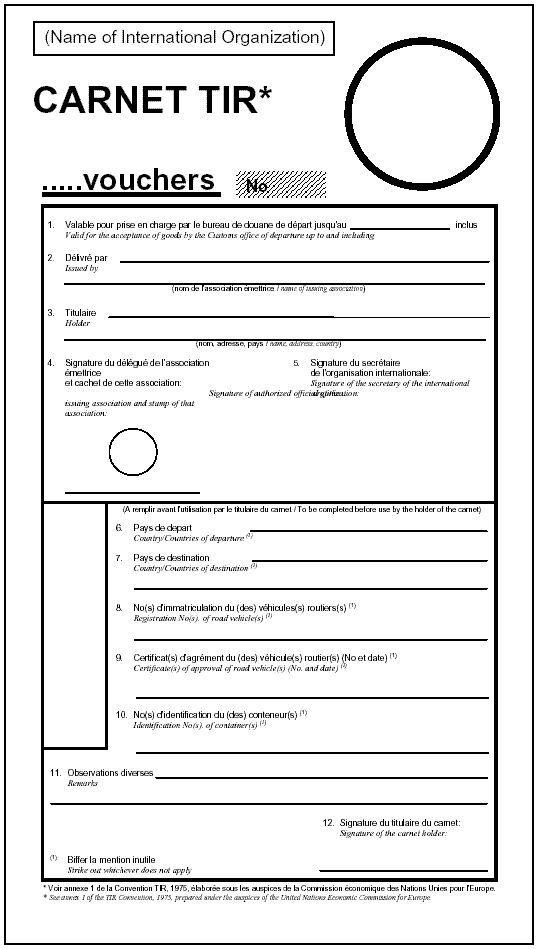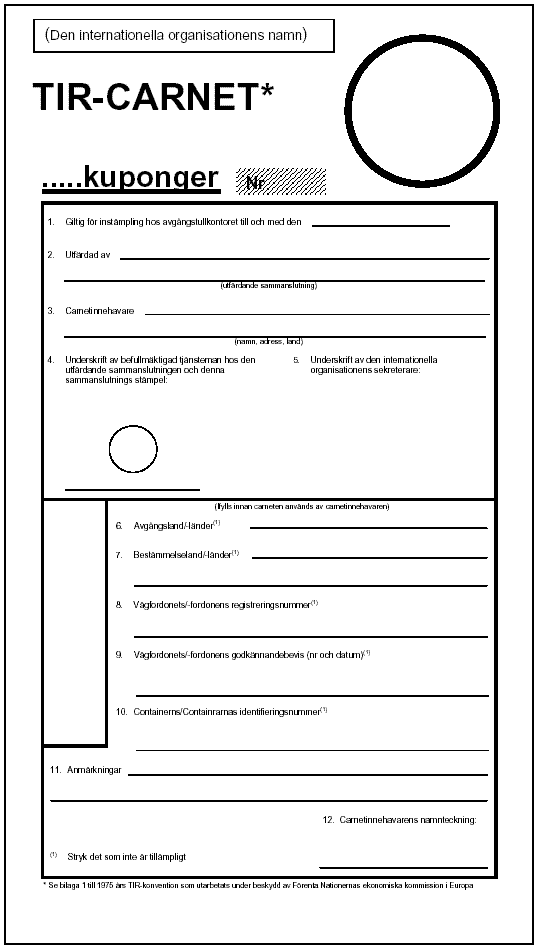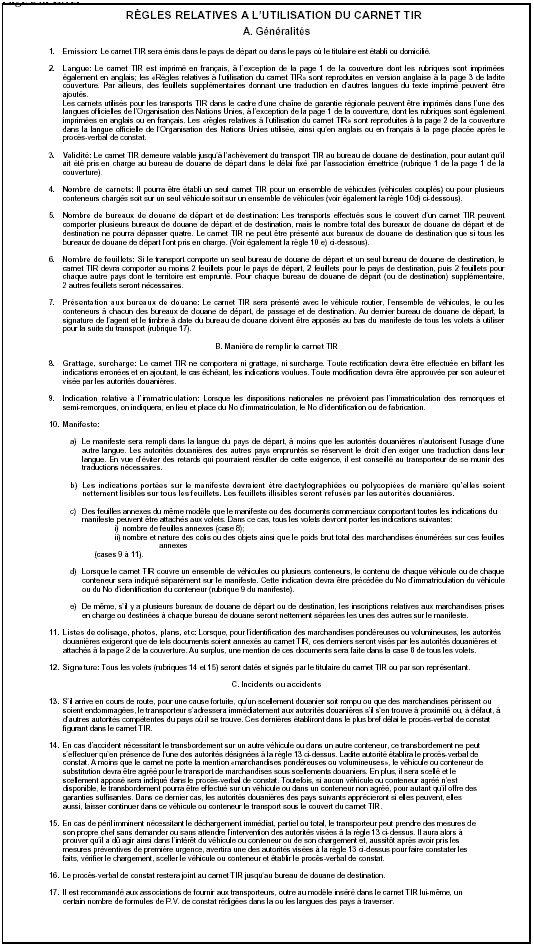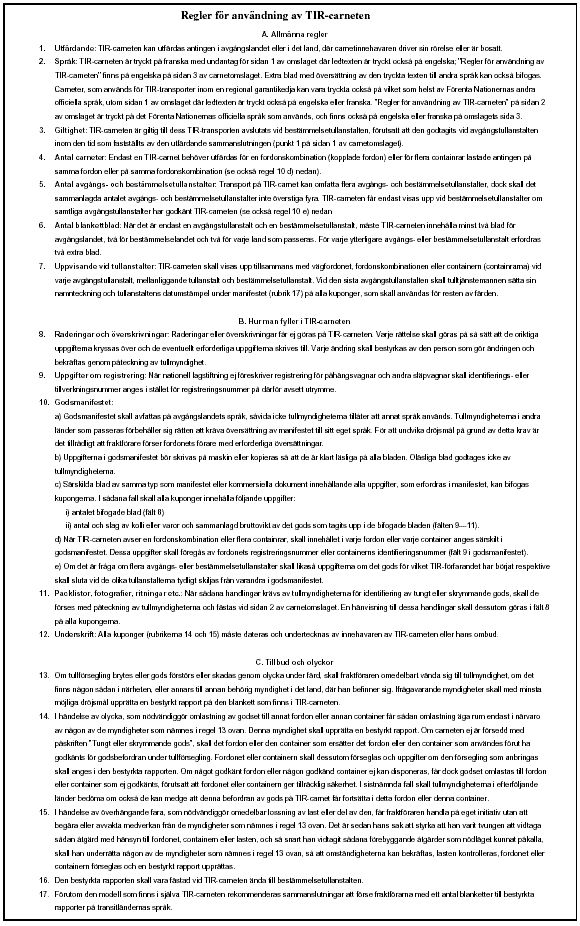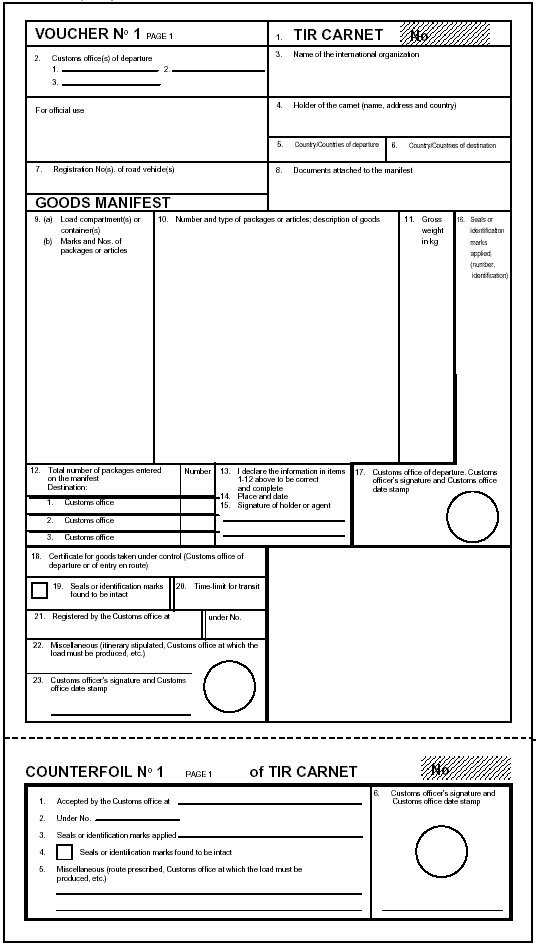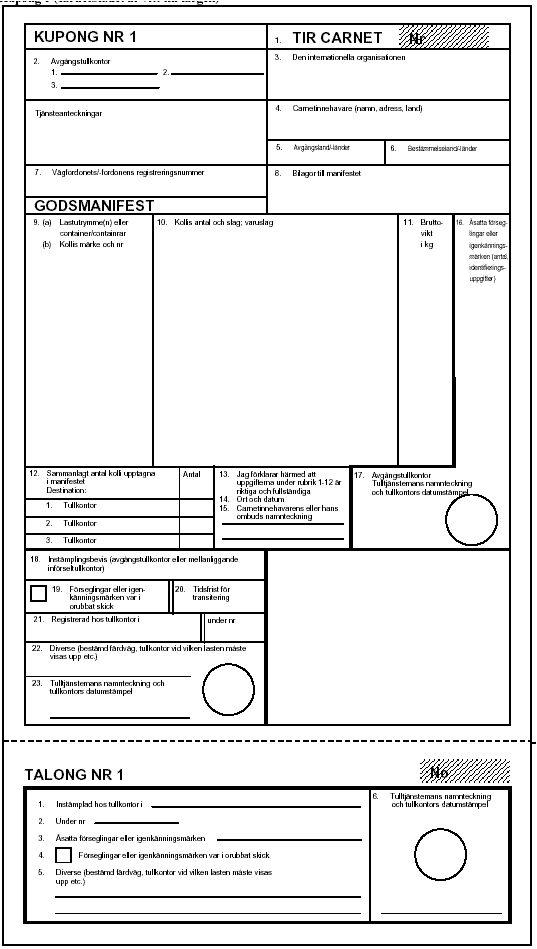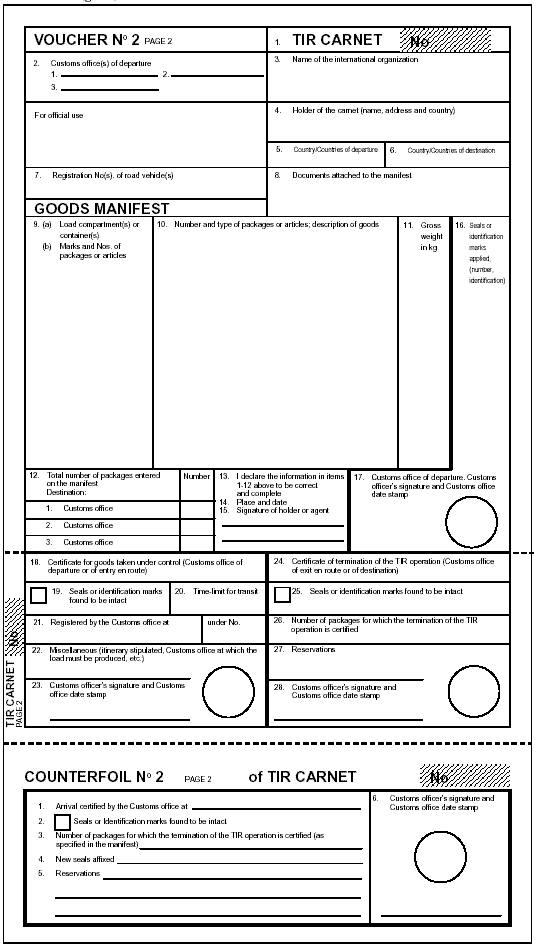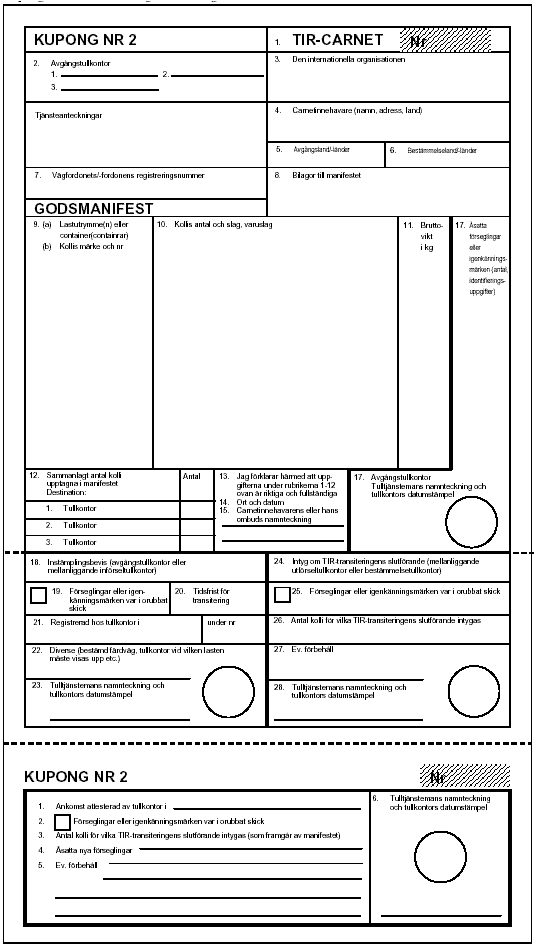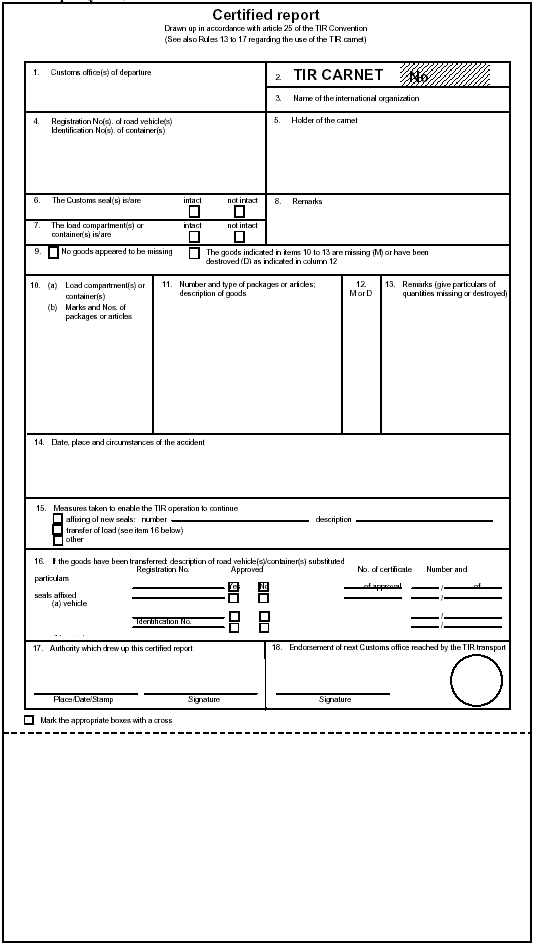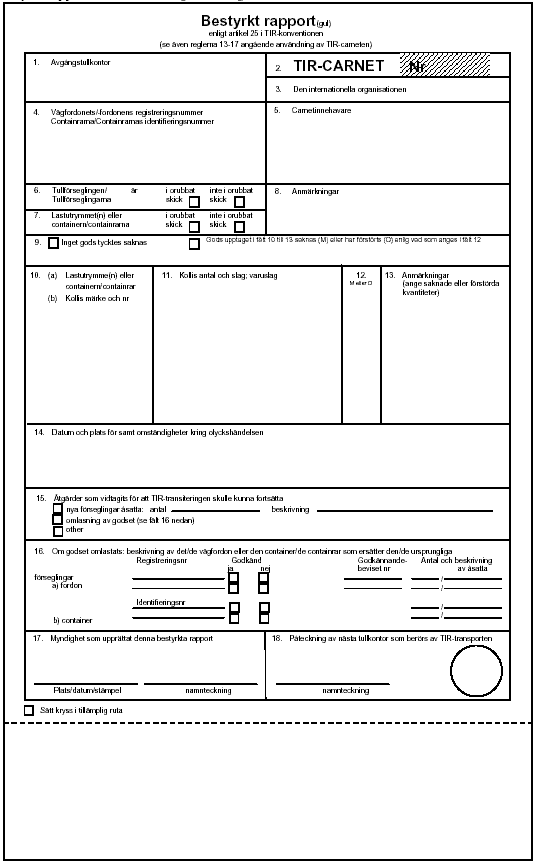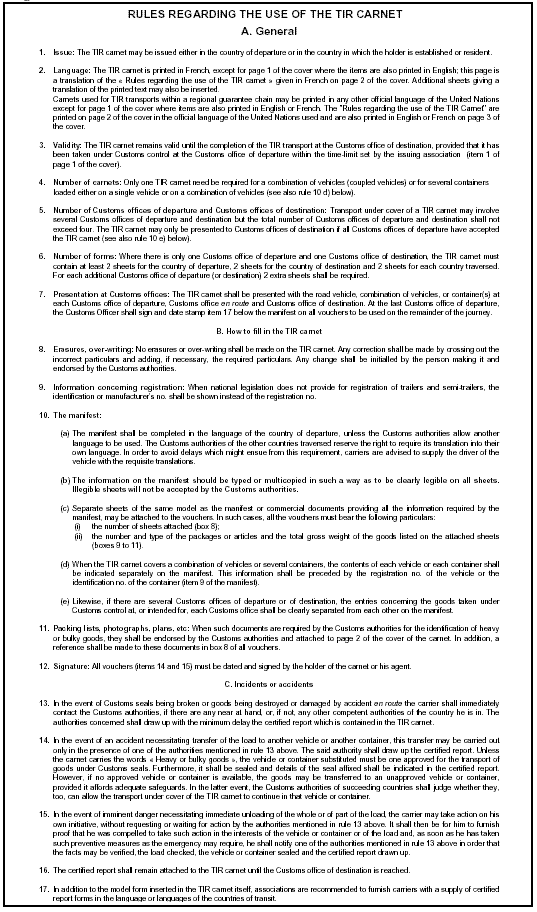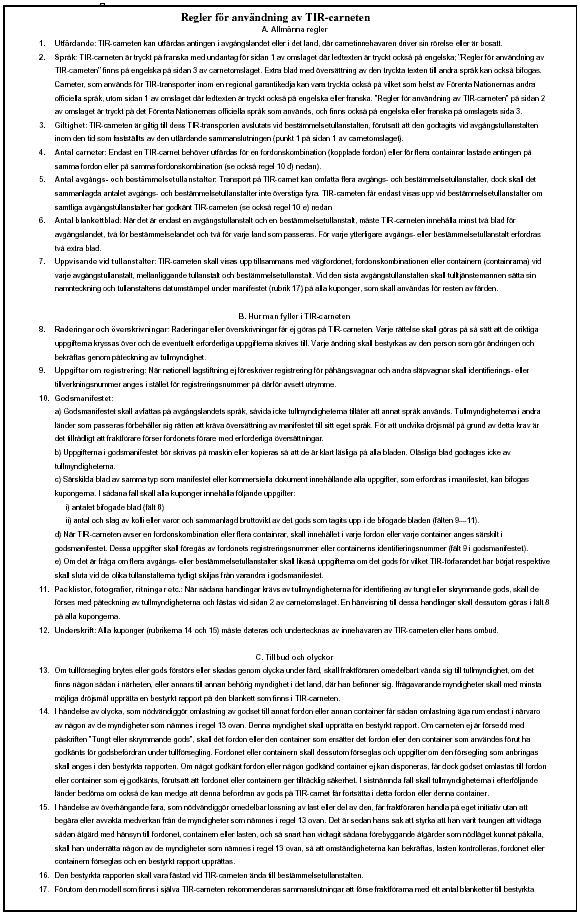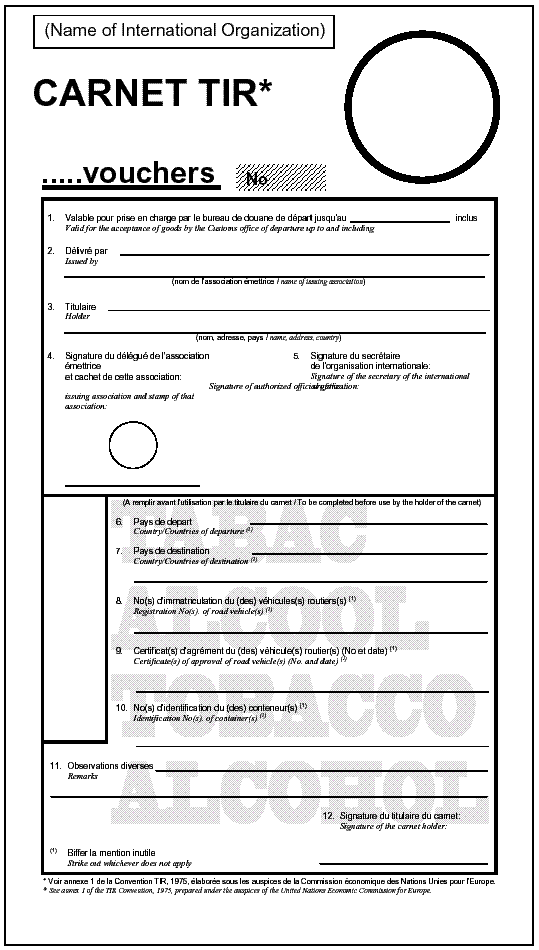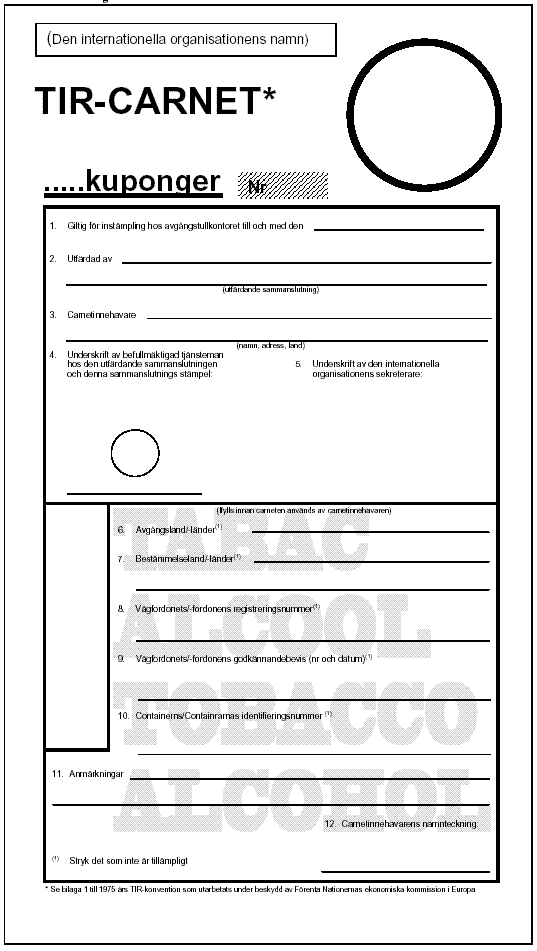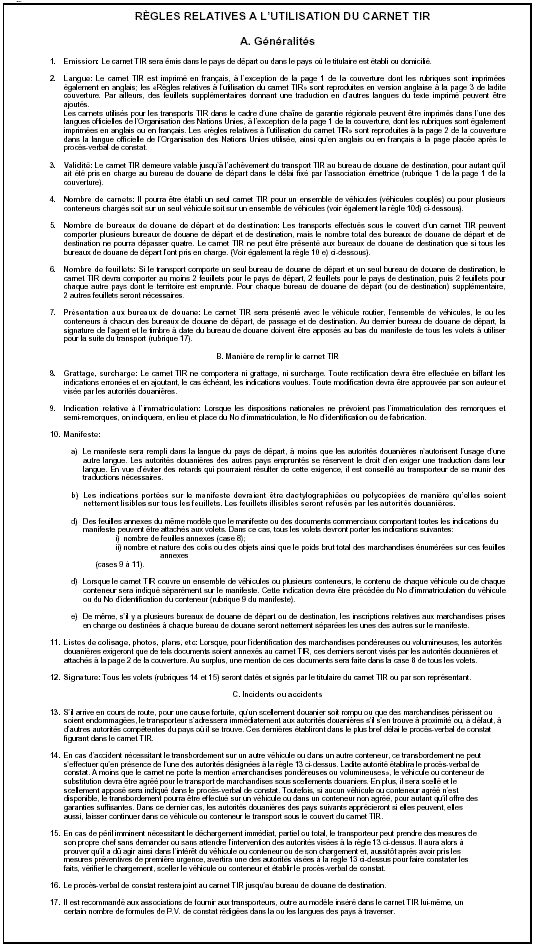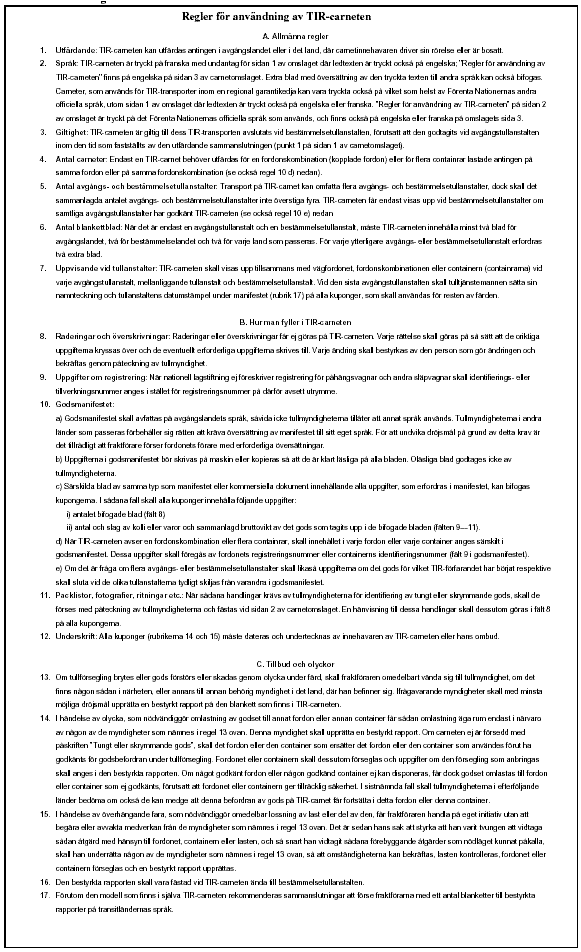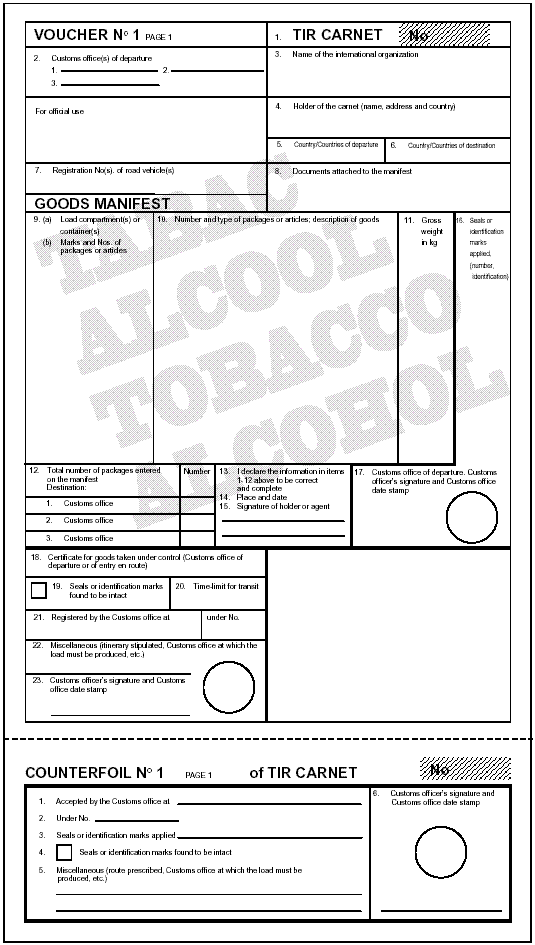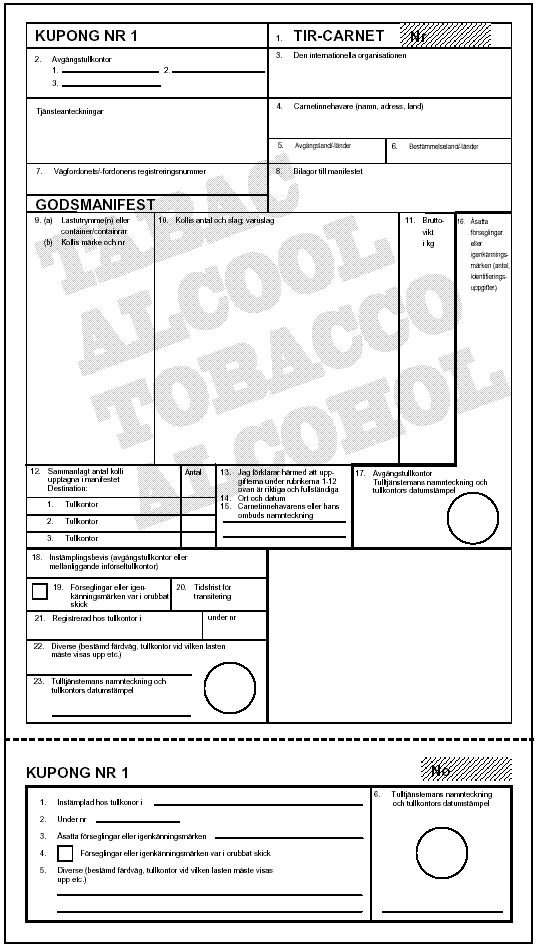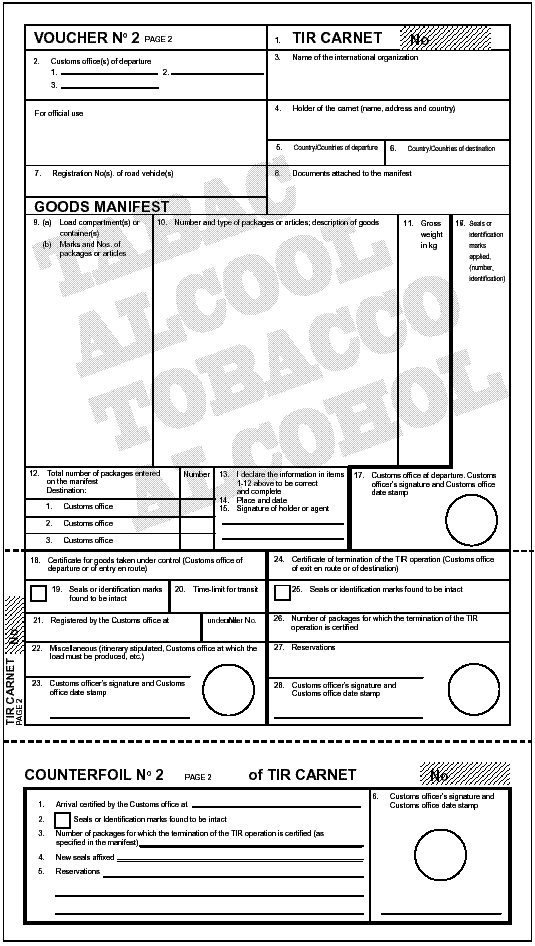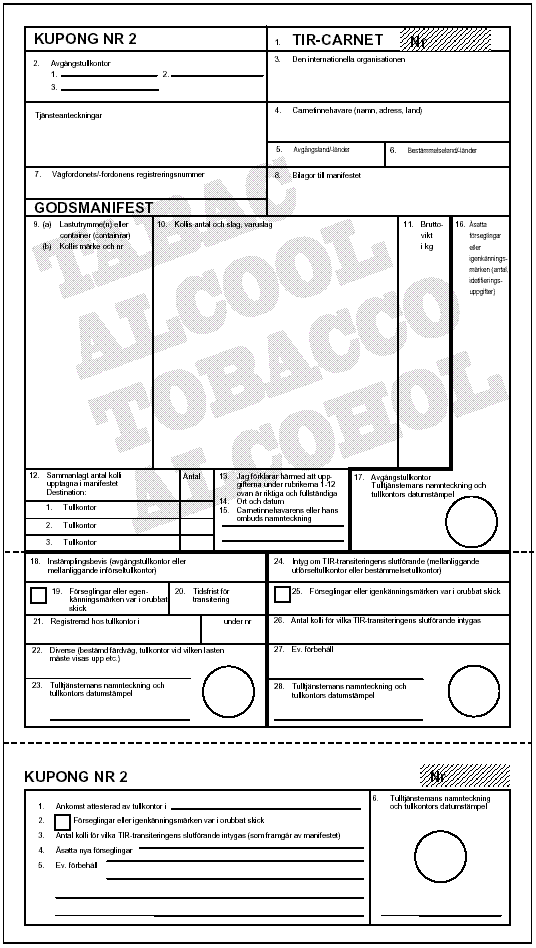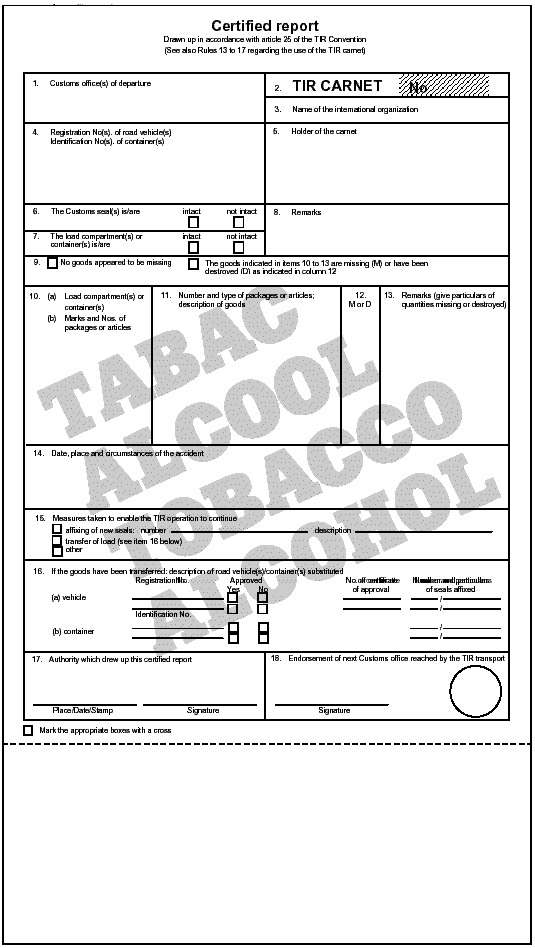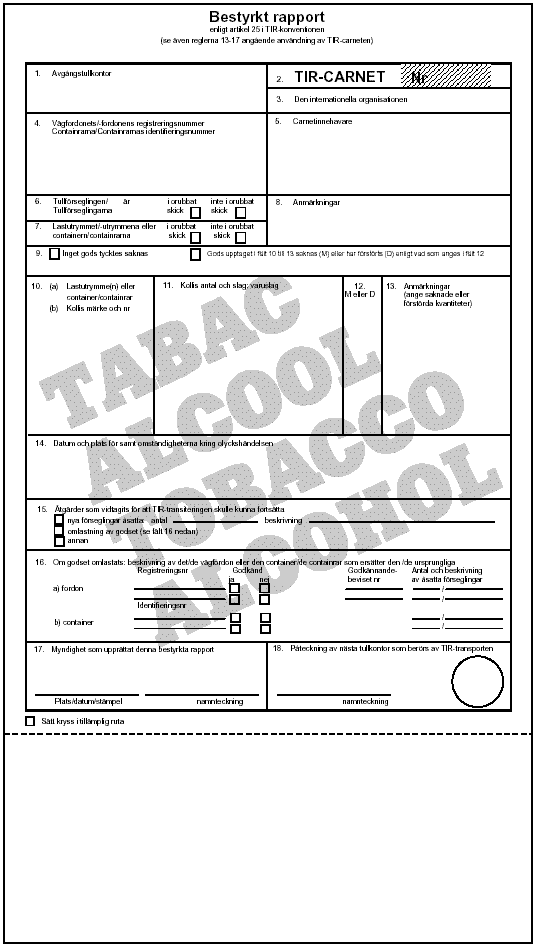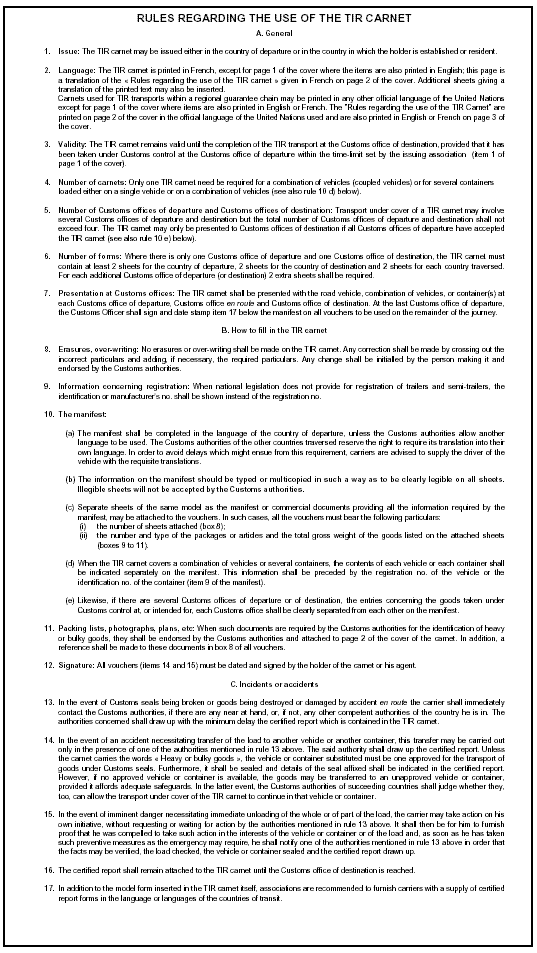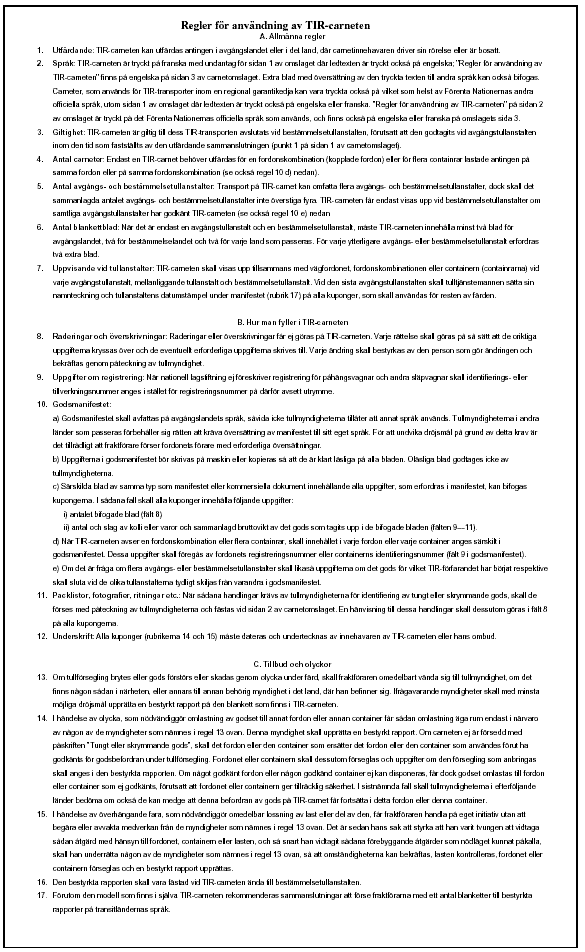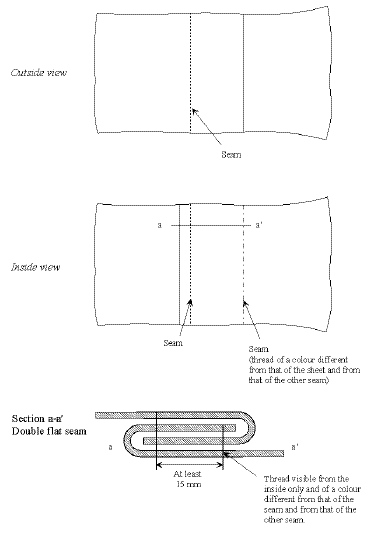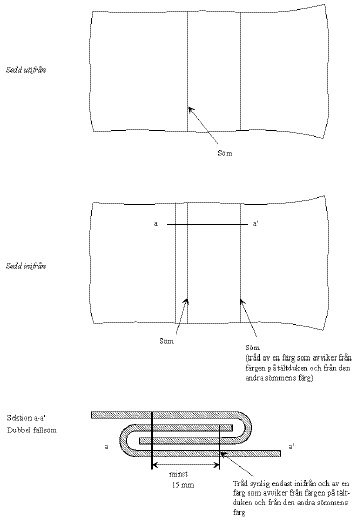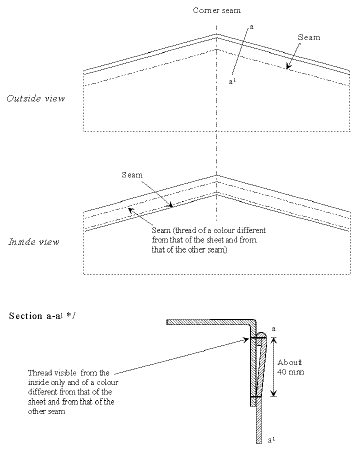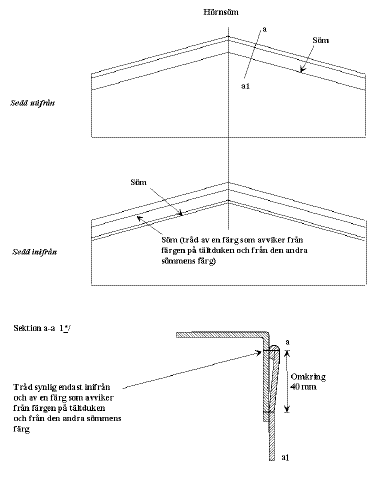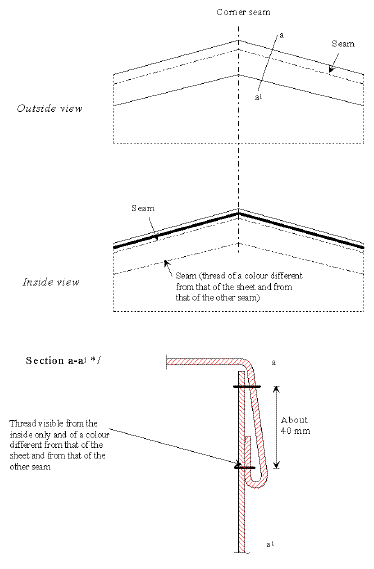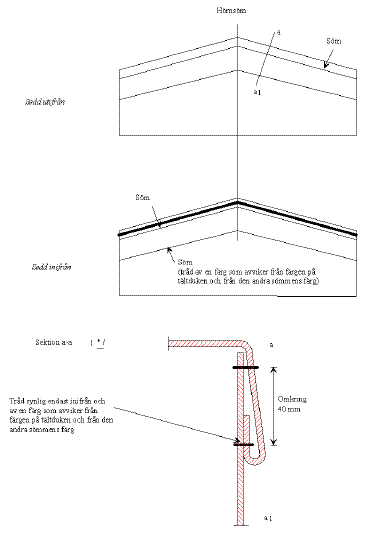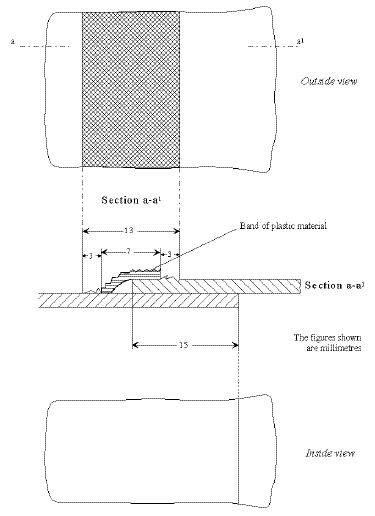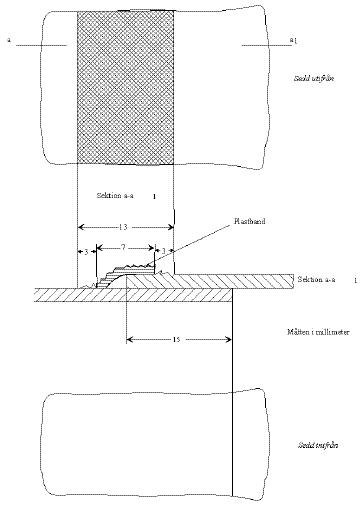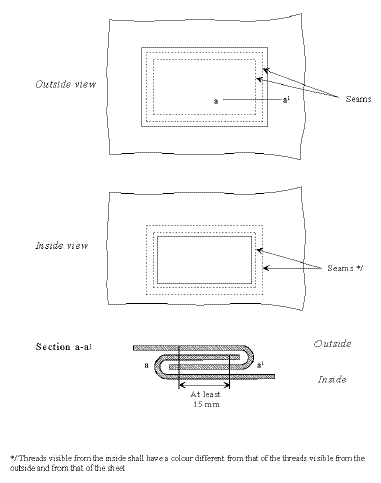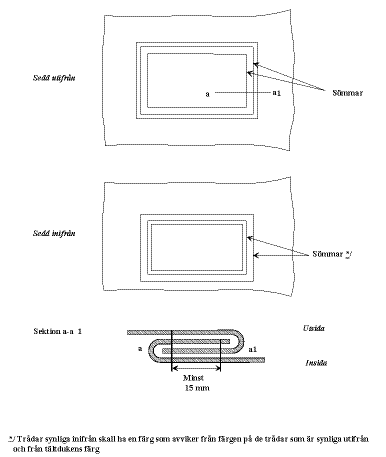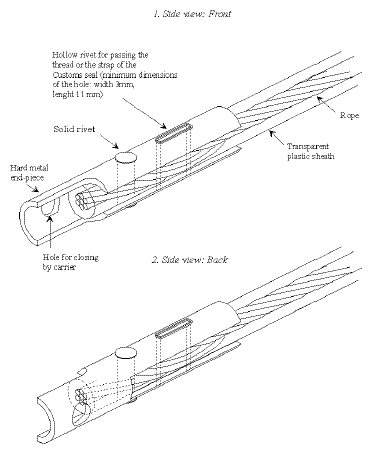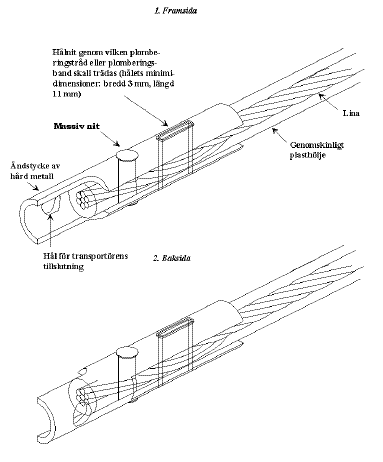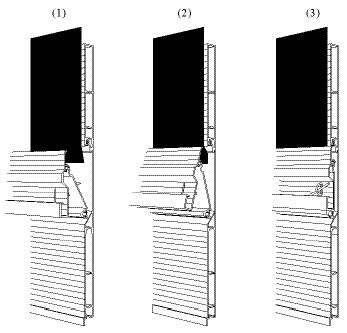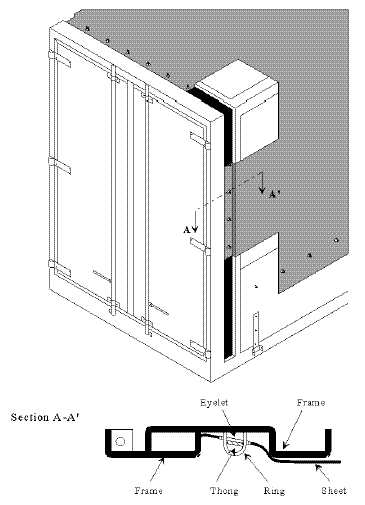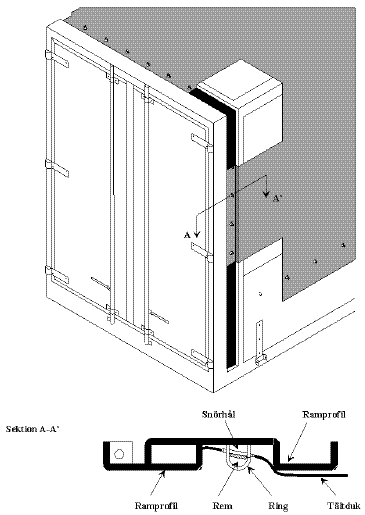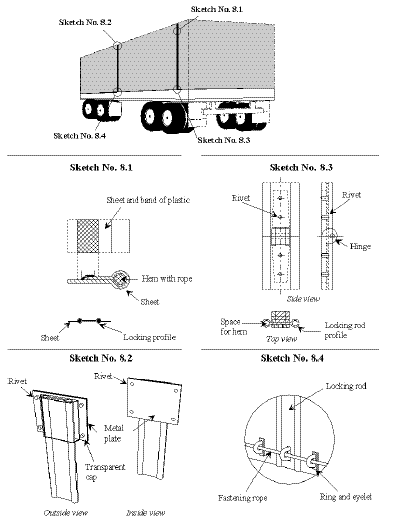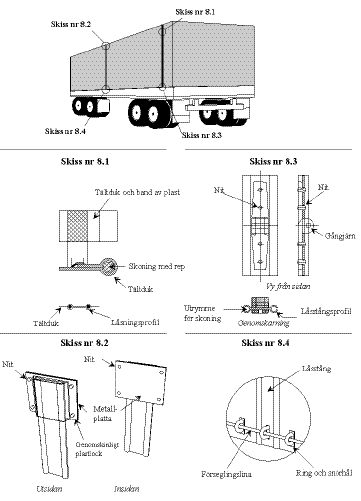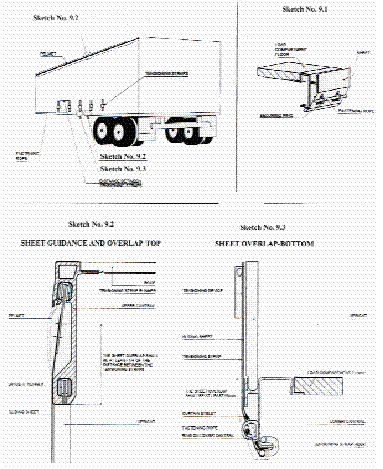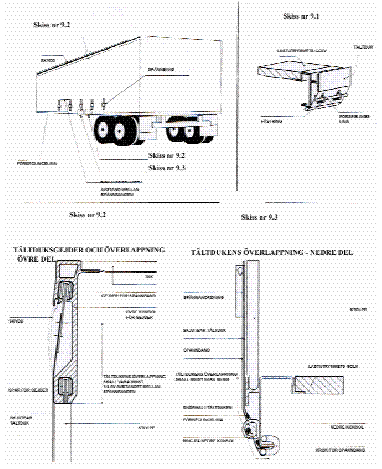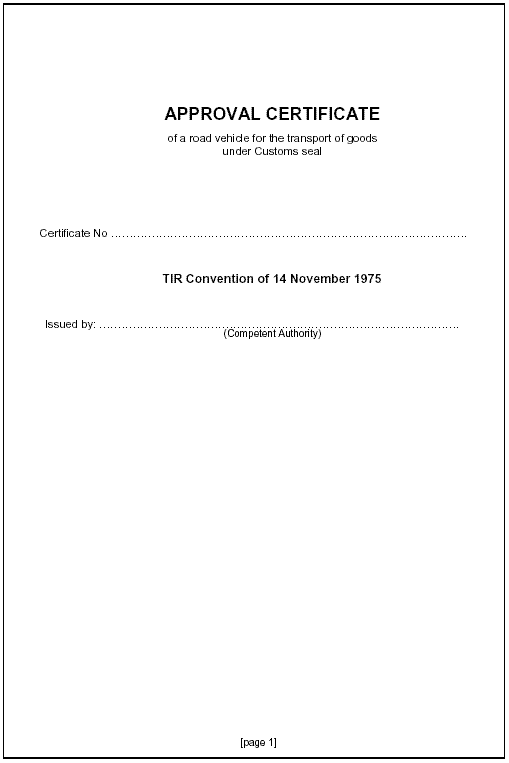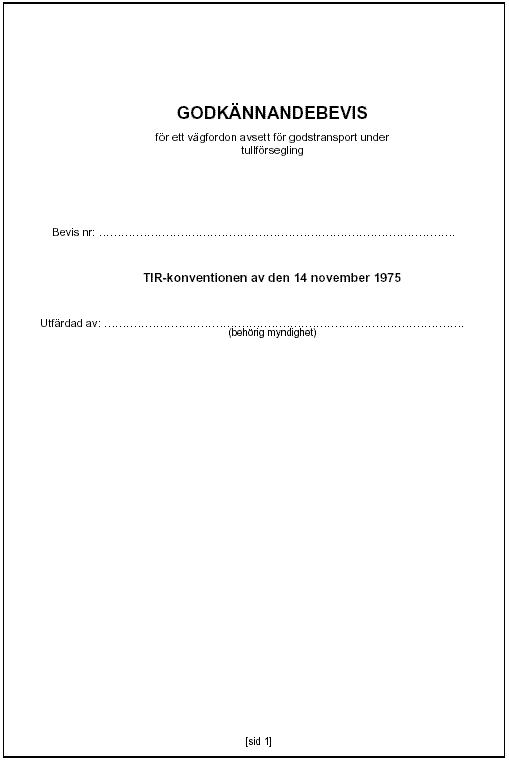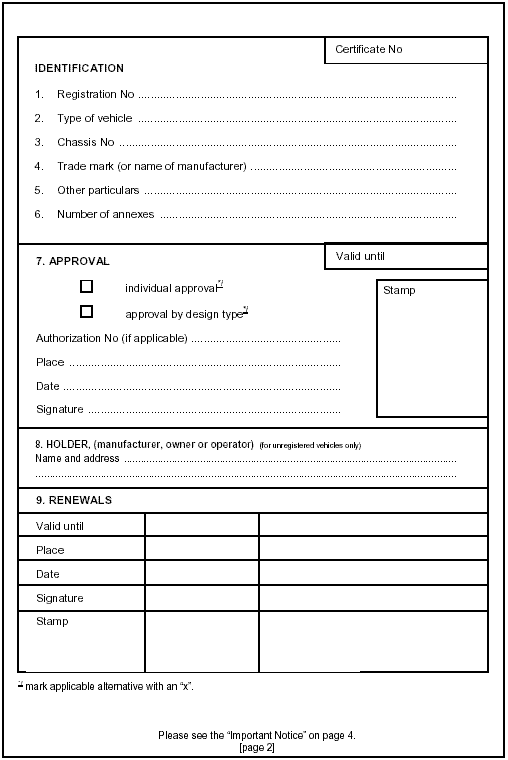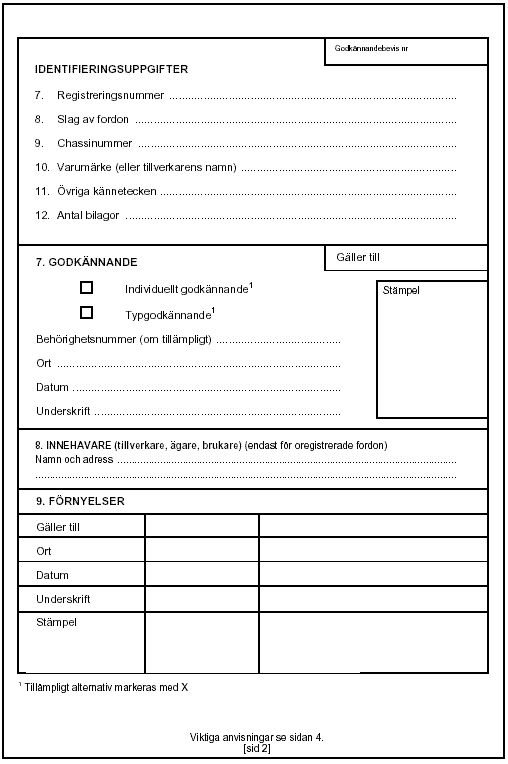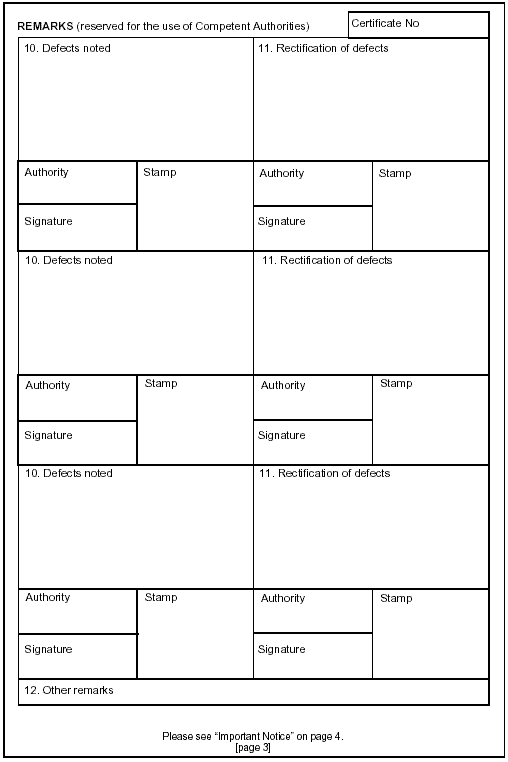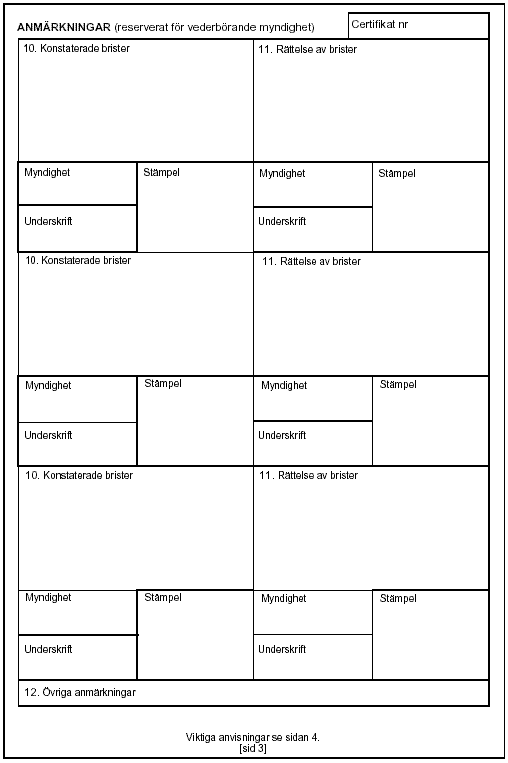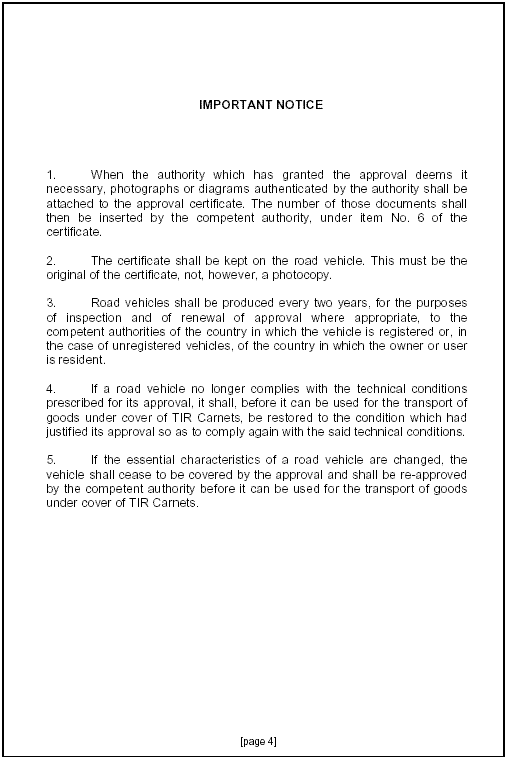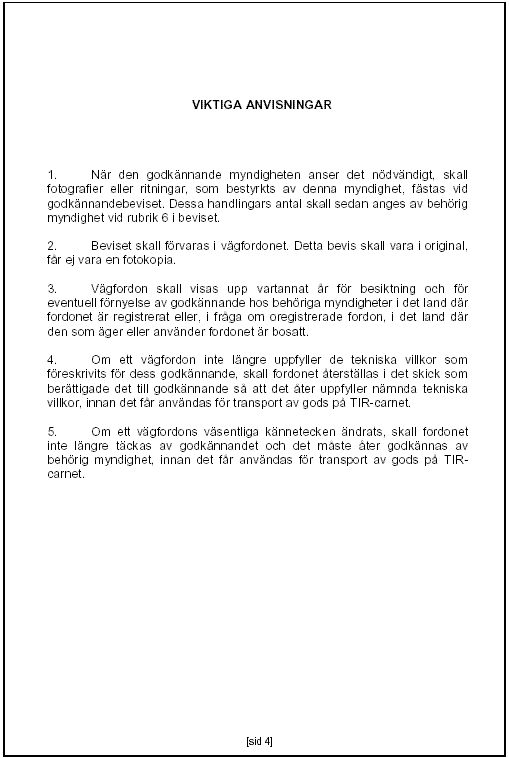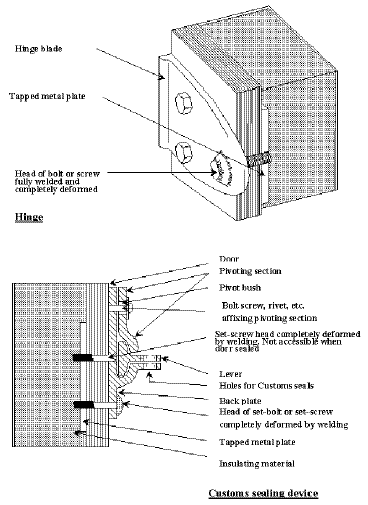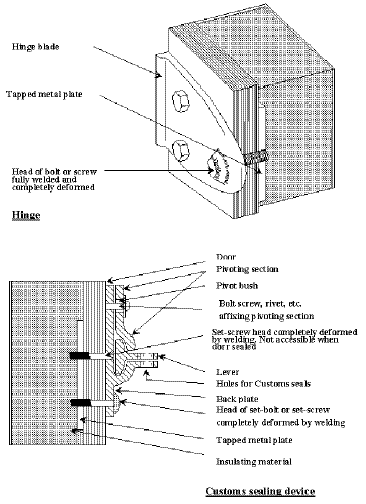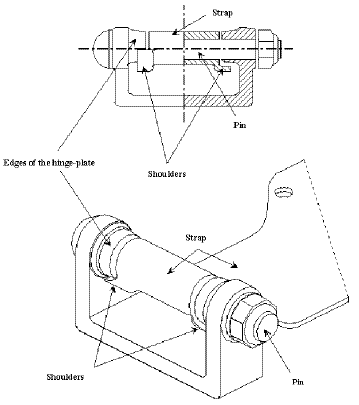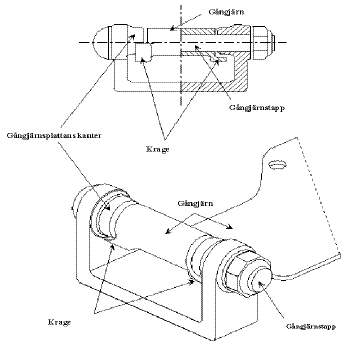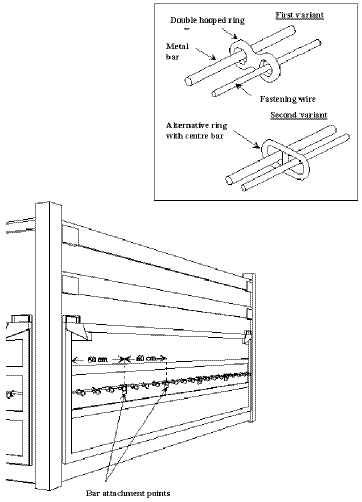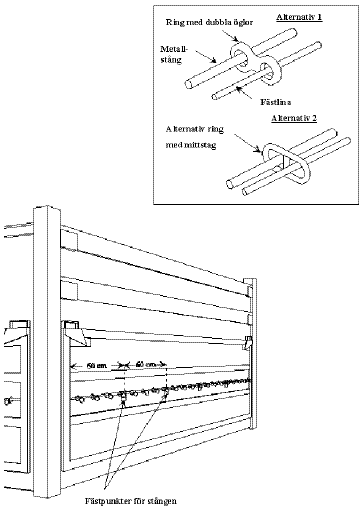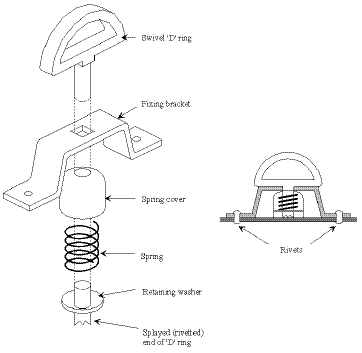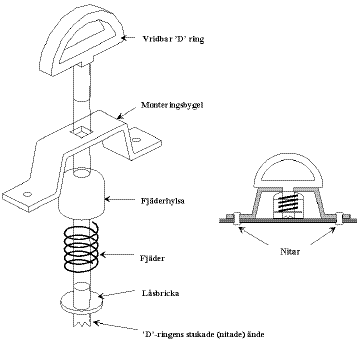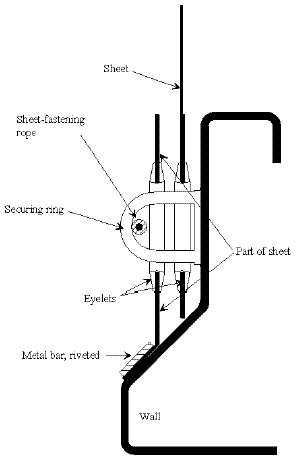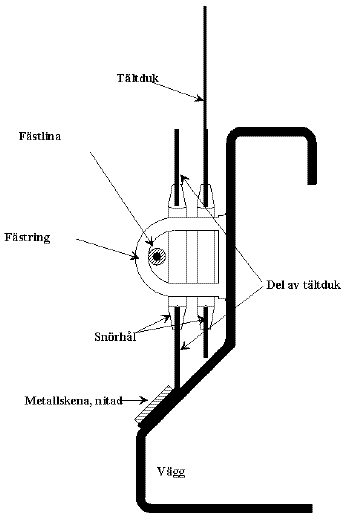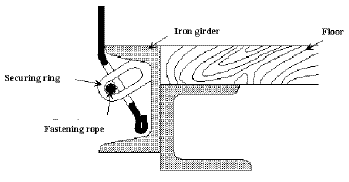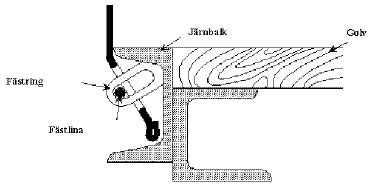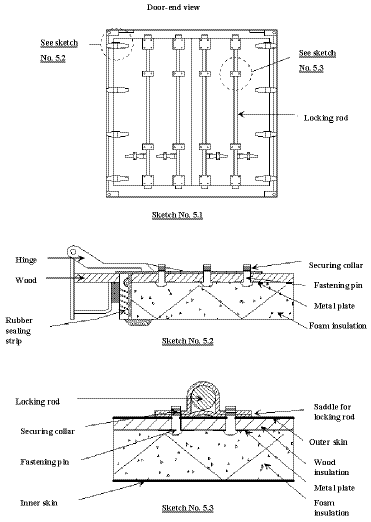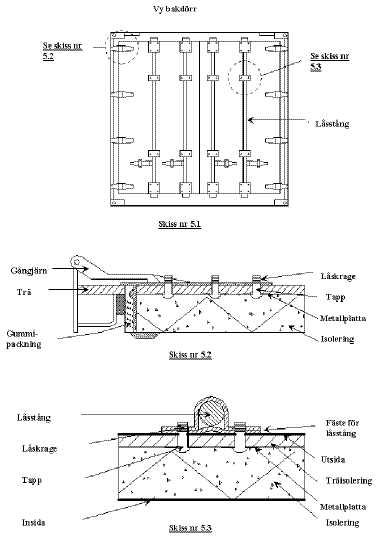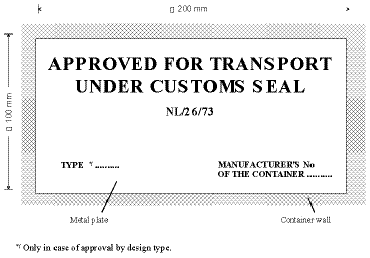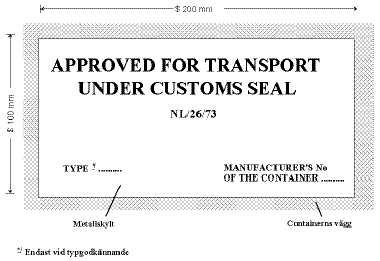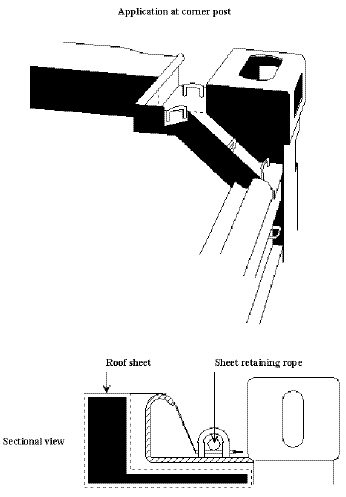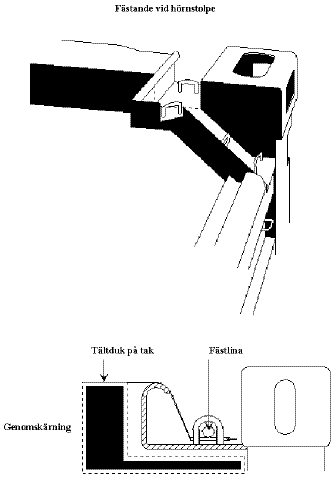TFS 2002:12
beslutad den 3 juni 2002Utkom från trycket den 14 juni 2002
Ansvarig enhet: avdelningen Effektiv handel, Kompetenscenter Klarering
Tillkännagivande
av 1975 års TIR-konvention samt tillhörande bilagor
I enlighet med 29 § tullförordningen (2000:1306) tillkännager Tullverket härmed 1975 års tullkonvention om internationell transport av gods upptaget i TIR-carnet (TIR-konventionen) samt tillhörande bilagor. TIR-konventionen undertecknades av Sverige den 17 december 1976 och trädde i kraft för Sveriges del den 20 mars 1977. Konventionen publicerades ursprungligen i Sveriges överenskommelser (SÖ 1976:133) med främmande makter.
Konventionens och bilagornas lydelse återges i engelsk version och innefattar de av TIR-konventionens administrativa kommittés beslutade ändringar fram till och med den 20 oktober 2000.
Konventionens och bilagornas lydelse i fransk respektive rysk version återges inte här.
Till konventionen finns en svensk översättning bifogad.
Customs Convention on the International transport of goods under cover of TIR Carnets (TIR Convention) |
Tullkonvention om internationell transport av gods upptaget i TIR-carnet (TIR-konvention) |
|
The contracting parties, Desiring to facilitate the international carriage of goods by road vehicle, Considering that the improvement of the conditions of transport constitutes one of the factors essential to the development of co-operation among them, Declaring themselves in favour of a simplification and a harmonization of administrative formalities in the field of international transport, in particular at frontiers, Have agreed as follows: |
De fördragsslutande parterna, som önskar underlätta internationell transport av gods med vägfordon, som anser att transportvillkorens förbättring utgör en väsentlig faktor för utvecklingen av samarbetet mellan dem, som förordnar en förenkling och harmonisering av de administrativa formaliteterna på det internationella transportområdet, i synnerhet vid gränserna, har överenskommit om följande: |
Chapter I - General(a) DefinitionsArticle 1 For the purposes of this Convention: (a) The term "TIR transport" shall mean the transport of goods from a Customs office of departure to a Customs office of destination under the procedure, called the TIR procedure, laid down in this Convention; (b) the term "TIR operation" shall mean the part of a TIR transport that is carried out in a Contracting Party from a Customs office of departure or entry (en route) to a Customs office of destination or exit (en route); (c) the term "start of a TIR operation" shall mean that the road vehicle, the combination of vehicles or the container have been presented for purposes of control to the Customs office of departure or of entry (en route) together with the load and the TIR Carnet relating thereto and that the TIR Carnet has been accepted by the Customs office; (d) the term "termination of a TIR operation" shall mean that the road vehicle, the combination of vehicles or the container have been presented for purposes of control to the Customs office of destination or of exit (en route) together with the load and the TIR Carnet relating thereto; (e) the term "discharge of a TIR operation" shall mean the recognition by Customs authorities that the TIR operation has been terminated correctly in a Contracting Party. This is established by the Customs authorities on the basis of a comparison of the data or information available at the Customs office of destination or exit (en route) and that available at the Customs office of departure or entry (en route); (f) the term "import or export duties and taxes" shall mean Customs duties and all other duties, taxes, fees and other charges which are collected on, or in connection with, the import or export of goods, but not including fees and charges limited in amount to the approximate cost of services rendered; (g) the term "road vehicle" shall mean not only any power-driven road vehicle but also any trailer or semi-trailer designed to be coupled thereto; (h) the term "combination of vehicles" shall mean coupled vehicles which travel on the road as a unit; (j) the term "container" shall mean an article of transport equipment (lift-van, movable tank or other similar structure): (i) fully or partially enclosed to constitute a compartment intended for containing goods, (ii) of a permanent character and accordingly strong enough to be suitable for repeated use, (iii) specially designed to facilitate the transport of goods by one or more modes of transport without intermediate reloading, (iv) designed for ready handling, particularly when being transferred from one mode of transport to another, (v) designed to be easy to fill and to empty, and (vi) having an internal volume of one cubic metre or more; "demountable bodies" are to be treated as containers; (k) the term "Customs office of departure" shall mean any Customs office of a Contracting Party where the TIR transport of a load or part load of goods begins; (l) the term "Customs office of destination" shall mean any Customs office of a Contracting Party where the TIR transport of a load or part load of goods ends; (m) the term "Customs office en route" shall mean any Customs office of a Contracting Party through which a road vehicle, combination of vehicles or container enters or leaves this Contracting Party in the course of a TIR transport; (n) the term "person" shall mean both natural and legal persons; (o) the term "holder" of a TIR Carnet shall mean the person to whom a TIR Carnet has been issued in accordance with the relevant provisions of the Convention and on whose behalf a Customs declaration has been made in the form of a TIR Carnet indicating a wish to place goods under the TIR procedure at the Customs office of departure. He shall be responsible for presentation of the road vehicle, the combination of vehicles or the container together with the load and the TIR carnet relating thereto at the Customs office of departure, the Customs office en route and the Customs office of destination and for due observance of the other relevant provisions of the Convention; (p) the term "heavy or bulky goods" shall mean any heavy or bulky object which because of its weight, size or nature is not normally carried in a closed road vehicle or closed container; (q) the term "guaranteeing association" shall mean an association approved by the Customs authorities of a Contracting Party to act as surety for persons using the TIR procedure. |
I kap. Allmänna bestämmelsera) DefinitionerArtikel 1 I denna konvention avses med: a) "TIR-transport" godstransport från ett avgångstullkontor till ett bestämmelsetullkontor enligt det förfarande, kallat TIR-förfarandet, om vilket föreskrifter finns i denna konvention; b) "TIR-transitering" del av TIR-transport som genomförs från ett avgångstullkontor eller infartstullkontor (mellanliggande tullkontor) till ett bestämmelsetullkontor eller utfartstullkontor (mellanliggande tullkontor) inom en fördragsslutande parts område; c) "TIR-transiterings början" att vägfordon, fordonskombinationer eller container har visats upp för att kontrolleras av avgångstullkontor eller infartstullkontor (mellanliggande tullkontor) tillsammans med lasten och den TIR-carnet som upptar lasten och att TIR-carneten har godtagits av tullkontoret; d) "TIR-transiterings slutförande" att vägfordon, fordonskombinationer eller container har visats upp för att kontrolleras av bestämmelsetullkontor eller utfartstullkontor (mellanliggande tullkontor) tillsammans med lasten och den TIR-carnet som upptar lasten; e) "TIR-transiterings avslutande" att tullmyndigheterna fastställer att TIR-transiteringen slutförts på ett korrekt sätt inom en fördragsslutande parts område. Detta fastställs av tullmyndigheterna på grundval av en jämförelse mellan de uppgifter eller den information som bestämmelsetullkontoret eller utfartstullkontoret (mellanliggande tullkontor) och avgångstullkontoret eller infartstullkontoret (mellanliggande tullkontor) har tillgång till; f) "tullar och andra avgifter vid import eller export" tullar och alla andra skatter, avgifter eller andra pålagor som uppbäres vid eller i samband med import eller export av varor; uttrycket omfattar dock ej avgifter och pålagor som begränsas till de ungefärliga kostnaderna för utförda tjänster; g) "vägfordon" ej endast varje motordrivet vägfordon utan också varje påhängsvagn eller annan släpvagn avsedd att kopplas till ett sådant vägfordon; h) "fordonskombination" sammankopplade fordon som framföres på vägen såsom en enhet; j) "container" en transportanordning (möbelbehållare, flyttbar tank eller annan anordning av liknande konstruktion): i) helt eller delvis tillsluten för att bilda ett godsutrymme; ii) av varaktigt slag och följaktligen tillräckligt hållbar för att lämpa sig för upprepad användning; iii) särskilt konstruerad för att underlätta godstransport med ett eller flera transportsätt utan omlastning under vägen; iv) konstruerad för att kunna hanteras bekvämt, i synnerhet vid ombyte av transportsätt; v) konstruerad så att den är lätt att fylla och tömma; och vi) med en inre volym av minst en kubikmeter; "Utbytbara karosserier" skall behandlas såsom containrar; k) "avgångstullkontor" varje tullkontor inom fördragsslutande parts område, vid vilket en TIR-transport av last eller del därav börjar; l) "bestämmelsetullkontor" varje tullkontor inom fördragsslutande parts område, vid vilket TIR-transport av last eller del därav slutar; m) "mellanliggande tullkontor" varje tullkontor inom fördragsslutande parts område vid vilket vägfordon, fordonskombinationer eller container under en TIR-transport införes till eller utföres från den fördragsslutande partens område; n) "person" såväl fysisk som juridisk person; o) "innehavare av en TIR-carnet" person till vilken en TIR-carnet utfärdats enligt tillämpliga föreskrifter i konventionen och på vilkens vägnar en tulldeklaration avlämnats i form av en TIR-carnet som visar en önskan om att hänföra gods till TIR-förfarandet vid ett avgångstullkontor. Innehavaren är ansvarig för att fordon, fordonskombination eller container tillsammans med lasten och den TIR-carnet som upptar lasten visas upp för avgångstullkontor, mellanliggande tullkontor och bestämmelsetullkontor och för vederbörliga åligganden enligt andra tillämpliga föreskrifter i konventionen; p) "tungt eller skrymmande gods" varje tungt eller skrymmande föremål som på grund av sin vikt, storlek eller beskaffenhet ej normalt befordras i ett tillslutet vägfordon eller i en tillsluten container; q) "garanterande sammanslutning" en sammanslutning som av fördragsslutande parts tullmyndigheter godkänts att uppträda såsom garant för personer som använder TIR-förfarandet. |
|
(b) Scope Article 2 This Convention shall apply to the transport of goods without intermediate reloading, in road vehicles, combinations of vehicles or in containers, across one or more frontiers between a Customs office of departure of one Contracting Party, and a Customs office of destination of another or of the same Contracting Party, provided that some portion of the journey between the beginning and the end of the TIR transport is made by road. |
b) Tillämpningsområde Artikel 2 Denna konvention avser godstransport utan omlastning under vägen över en eller flera gränser från ett avgångstullkontor inom en fördragsslutande parts område till ett bestämmelsetullkontor inom annan eller samma fördragsslutande parts område, i vägfordon, fordonskombinationer eller containrar, förutsatt att någon del av färden mellan början och slutet av TIRtransporten företas på väg. |
|
Article 3 For the provisions of this Convention to become applicable: (a) the transport operation must be performed (i) by means of road vehicles, combinations of vehicles or containers previously approved under the conditions set forth in Chapter III (a), or (ii) by means of other road vehicles, other combinations of vehicles or other containers under the conditions set forth in Chapter III (c), or (iii) by road vehicles or special vehicles such as buses, cranes, sweepers, concrete-laying machines, etc. exported and therefore themselves considered as goods travelling by their own means from a Customs office of departure to a Customs office of destination under the conditions set forth in Chapter III (c). In case such vehicles are carrying other goods, the conditions as referred to under (i) or (ii) above shall apply accordingly; (b) the transport operations must be guaranteed by associations approved in accordance with the provisions of Article 6 and must be performed under cover of a TIR Carnet, which shall conform to the model reproduced in Annex 1 to this Convention. |
Artikel 3 För att bestämmelserna i denna konvention skall bli tillämpliga: a) skall transportoperationerna utföras i) med vägfordon, fordonskombinationer eller containrar som i förväg godkänts enligt de villkor som anges i kapitel III a); eller ii) med andra vägfordon, andra fordonskombinationer eller andra containrar enligt de villkor som anges i kapitel III c), eller iii) med vägfordon eller speciella fordon som bussar, kranar, sopmaskiner, asfaltmaskiner o. dyl. som utförs och således själva ska anses som gods som transporteras på egna hjul från ett avgångstullkontor till ett bestämmelsetullkontor enligt de villkor som anges i kapitel III c). Om sådana fordon transporterar annat gods ska villkoren som anges ovan i i) eller ii) tillämpas på motsvarande sätt. b) skall transportoperationerna garanteras av sammanslutningar som godkänts enligt bestämmelserna i artikel 6 och för operationerna användas en TIR-carnet som skall stämma överens med modellen i bilaga 1 till denna konvention. |
|
(c) Principles Article 4 Goods carried under the TIR procedure shall not be subjected to the payment or deposit of import or export duties and taxes at Customs offices en route. |
c) Principer Artikel 4 För gods som befordras enligt TIR-förfarandet skall erläggande eller deposition av tullar och andra avgifter vid import eller export ej krävas vid mellanliggande tullkontor. |
|
Article 5 1. Goods carried under the TIR procedure in sealed road vehicles, combinations of vehicles or containers shall not as a general rule be subjected to examination at Customs offices en route. 2. However, to prevent abuses, Customs authorities may in exceptional cases, and particularly when irregularity is suspected, carry out an examination of the goods at such offices. |
Artikel 5 1. Gods som befordras enligt TIR-förfarandet i förseglade vägfordon, fordonskombinationer eller containrar skall som regel ej bli föremål för undersökning vid mellanliggande tullkontor. 2. För att förhindra missbruk kan tullmyndigheterna likväl i exceptionella fall och särskilt när oegentligheter befaras företaga en undersökning av godset vid sådana kontor. |
Chapter II - Issue of TIR CarnetsLiability of guaranteeing associations |
II kap. Utfärdande av TIR-carneterGaranterande sammanslutningars ansvarighet |
|
Article 6 1. Each Contracting Party may authorize associations to issue TIR Carnets, either directly or through corresponding associations, and to act as guarantors, as long as the minimum conditions and requirements, as laid down in Annex 9, Part I, are complied with. The authorization shall be revoked if the minimum conditions and requirements contained in Annex 9, Part I are no longer fulfilled. 2. An association shall not be approved in any country unless its guarantee also covers the liabilities incurred in that country in connection with operations under cover of TIR Carnets issued by foreign associations affiliated to the same international organization as that to which it is itself affiliated. 2a. An international organization, as referred to in papagraph 2, shall be authorized by the Administrative Committee to take on responsibility for the effective organization and functioning of an international guarantee system provided that it accepts this responsibility. 3. An association shall issue TIR Carnets only to persons, whose access to the TIR procedure has not been refused by the competent authorities of Contracting Parties in which the person is resident or established. 4. Authorization for access to the TIR procedure shall be granted only to persons who fulfil the minimum conditions and requirements laid down in Annex 9, Part II to this Convention. Without prejudice to Article 38, the authorization shall be revoked if the fulfilment of these criteria is no longer ensured. 5. Authorization for access to the TIR procedure shall be granted according to the procedure laid down in Annex 9, Part II to this Convention. |
Artikel 6 1. Varje fördragsslutande part kan, såvida de minimivillkor och minimikrav som anges i bilaga 9, del I är uppfyllda, medge sammanslutningar rätt att antingen själva eller genom motsvarande sammanslutningar utfärda TIR-carneter och att uppträda såsom garanter. Denna rätt upphör att gälla om de minimivillkor och minimikrav som anges i bilaga 9, del I ej längre är uppfyllda. 2. En sammanslutning skall ej godtagas i ett land, såvida icke dess garanti täcker också det betalningsansvar som kan uppstå inom landet i fråga i samband med transporter för vilka används TIR-carneter, som utfärdats av utländska sammanslutningar, anslutna till samma internationella organisation som den själv är ansluten till. 2 a. En internationell organisation, som avses i moment 2, skall av den administrativa kommittén medges rätt att ansvara för att ett internationellt garantisystem organiseras och förvaltas ändamålsenligt förutsatt att organisationen påtar sig detta ansvar. 3. En sammanslutning skall utfärda TIR-carneter enbart till personer vars tillgång till TIR-förfarandet inte har avvisats av de behöriga myndigheterna i den fördragsslutande part där personen driver sin rörelse eller är bosatt. 4. Tillstånd för tillgång till TIR-förfarandet skall utfärdas enbart till personer som uppfyller de minimivillkor och minimikrav som framställs i bilaga 9, del II till denna konvention. Utan att inverka på tillämpningen av artikel 38 skall detta tillstånd återkallas om det inte längre kan säkerställas att dessa minimivillkor och minimikrav är uppfyllda. 5. Tillstånd för tillgång till TIR-förfarandet skall utfärdas i enlighet med det förfarande som fastställs i bilaga 9, del II till denna konvention. |
|
Article 7 TIR Carnet forms sent to the guaranteeing associations by the corresponding foreign associations or by international organizations shall not be liable to import and export duties and taxes and shall be free of import and export prohibitions and restrictions. |
Artikel 7 Blanketter till TIR-carneter, som sänds till garanterande sammanslutningar från motsvarande utländska sammanslutningar eller från internationella organisationer, skall ej beläggas med tullar och andra avgifter vid import eller export och skall vara fria från förbud och begränsningar vid import och export. |
|
Article 8 1. The guaranteeing association shall undertake to pay the import or export duties and taxes, together with any default interest, due under the Customs laws and regulations of the country in which an irregularity has been noted in connection with a TIR operation. It shall be liable, jointly and severally with the persons from whom the sums mentioned above are due, for payment of such sums. 2. In cases where the laws and regulations of a Contracting Party do not provide for payment of import or export duties and taxes as provided for in paragraph 1 above, the guaranteeing association shall undertake to pay, under the same conditions, a sum equal to the amount of the import or export duties and taxes and any default interest. 3. Each Contracting Party shall determine the maximum sum per TIR Carnet, which may be claimed from the guaranteeing association on the basis of the provisions of paragraphs 1 and 2 above. 4. The liability of the guaranteeing association to the authorities of the country where the Customs office of departure is situated shall commence at the time when the TIR Carnet is accepted by the Customs office. In the succeeding countries through which goods are transported under the TIR procedure, this liability shall commence at the time when the goods enter these countries or, where the TIR transport has been suspended under Article 26, paragraphs 1 and 2, at the time when the TIR Carnet is accepted by the Customs office where the TIR transport is resumed. 5. The liability of the guaranteeing association shall cover not only the goods which are enumerated in the TIR Carnet but also any goods which, though not enumerated therein, may be contained in the sealed section of the road vehicle or in the sealed container. It shall not extend to any other goods. 6. For the purpose of determining the duties and taxes mentioned in paragraphs 1 and 2 of this Article, the particulars of the goods as entered in the TIR Carnet shall, in the absence of evidence to the contrary, be assumed to be correct. 7. When payment of sums mentioned in paragraphs 1 and 2 of this Article becomes due, the competent authorities shall so far as possible require payment from the person or persons directly liable before making a claim against the guaranteeing association. |
Artikel 8 1. Den garanterande sammanslutningen skall förbinda sig att erlägga de tullar och andra avgifter vid import eller export, jämte eventuell dröjsmålsränta, som skall betalas enligt tullförfattningarna i det land där en oegentlighet uppmärksammats i samband med en TIR-transitering. Sammanslutningen skall solidariskt med de personer som det åligger att betala ovannämnda belopp ansvara för erläggandet av dessa. 2. Om en fördragsslutande parts lagar och förordningar ej föreskriver att tullar och andra avgifter vid import eller export skall erläggas enligt moment 1 ovan, skall den garanterande sammanslutningen förbinda sig att på samma villkor erlägga ett belopp som motsvarar summan av tullarna och de andra avgifterna vid import eller export samt den eventuella dröjsmålsräntan. 3. Varje fördragsslutande part skall bestämma det högsta belopp per TIR-carnet, som kan krävas från den garanterande sammanslutningen på grundval av bestämmelserna i moment 1 och 2 ovan. 4. Den garanterande sammanslutningens ansvarighet gentemot myndigheterna i det land där avgångstullkontoret är beläget skall börja att gälla från den tidpunkt då TIR-carneten godtages av tullkontoret. I de länder som passeras senare och genom vilka gods transporteras enligt TIR-förfarandet skall denna ansvarighet börja att gälla vid den tidpunkt då godset föres in i dessa länder eller, om TIR-transporten avbrutits enligt moment 1 och 2 av artikel 26, vid den tidpunkt då TIR-carneten godtages av det tullkontor där TIR-transporten återupptages. 5. Den garanterande sammanslutningens ansvarighet skall gälla icke endast sådant gods som är upptaget i TIR-carneten utan också sådant gods som finns i den förseglade delen av vägfordonet eller i den förseglade containern utan att vara upptaget i carneten. Ansvarigheten skall ej omfatta annat gods. 6. Vid beräknandet av de tullar och andra avgifter, som nämnes i moment 1 och 2 av denna artikel, skall de uppgifter om godset som antecknats i TIR-carneten anses riktiga om ej annat bevisas. 7. När belopp, som nämnes i moment 1 och 2 av denna artikel skall betalas, skall de behöriga myndigheterna i så stor utsträckning som möjligt kräva betalning från den person eller de personer som är direkt ansvariga, innan den garanterande sammanslutningen kräves. |
|
Article 9 1. The guaranteeing association shall fix the period of validity of the TIR Carnet by specifying a final date of validity after which the Carnet may not be presented for acceptance at the Customs office of departure. 2. Provided that it has been accepted by the Customs office of departure on or before the final date of validity, as provided for in paragraph 1 of this Article, the Carnet shall remain valid until the termination of the TIR operation at the Customs office of destination. |
Artikel 9 1. Den garanterande sammanslutningen skall fastställa TIR-carnetens giltighetstid genom att ange sista giltighetsdag efter vilken carneten ej kan visas upp och godtagas vid avgångstullkontoret. 2. Förutsatt att carneten godtagits av avgångstullkontoret senast sista giltighetsdagen i enlighet med moment 1 av denna artikel, skall carneten förbli giltig till dess TIR-transiteringen slutförts vid bestämmelsetullkontoret. |
|
Article 10 1. Discharge of a TIR operation has to take place without delay. 2. When the Customs authorities of a country have discharged a TIR operation they can no longer claim from the guaranteeing association payment of the sums mentioned in Article 8, paragraphs 1 and 2, unless the certificate of termination of the TIR operation was obtained in an improper or fraudulent manner or no termination has taken place. |
Artikel 10 1. En TIR-transitering skall avslutas utan dröjsmål. 2. När tullmyndigheterna i ett land avslutat en TIR-transitering kan de ej längre kräva betalning av de belopp som nämns i moment 1 och 2 av artikel 8 från den garanterande sammanslutningen, såvida ej intyg om TIR-transiteringens slutförande erhållits på ett oegentligt eller bedrägligt sätt eller att slutförande ej har skett. |
|
Article 11 1. Where a TIR operation has not been discharged, the competent authorities shall not have the right to claim payment of the sums mentioned in Article 8, paragraphs 1 and 2, from the guaranteeing association unless, within a period of one year from the date of acceptance of the TIR Carnet by those authorities, they have notified the association in writing of the non-discharge. The same provision shall apply where the certificate of termination of the TIR operation was obtained in an improper or fraudulent manner, save that the period shall be two years. 2. The claim for payment of the sums referred to in Article 8, paragraphs 1 and 2, shall be made to the guaranteeing association at the earliest three months after the date on which the association was informed that the TIR operation had not been discharged or that the certificate of termination of the TIR operation had been obtained in an improper or fraudulent manner and at the latest not more than two years after that date. However, in cases which, during the above-mentioned period of two years, become the subject of legal proceedings, any claim for payment shall be made within one year of the date on which the decision of the court becomes enforceable. 3. The guaranteeing association shall have a period of three months, from the date when a claim for payment is made upon it, in which to pay the amounts claimed. The sums paid shall be reimbursed to the association if, within the two years following the date on which the claim for payment was made, it has been established to the satisfaction of the Customs authorities that no irregularity was committed in connection with the transport operation in question. |
Artikel 11 1. När en TIR-transitering ej avslutats skall de behöriga myndigheterna ej ha rätt att kräva betalning av de belopp som nämns i moment 1 och 2 av artikel 8 från den garanterande sammanslutningen, såvida ej myndigheten inom en tid av ett år från den dag då TIR-carneten godtagits av dem skriftligen underrätta sammanslutningen om att TIR-transiteringen ej har avslutats. Samma bestämmelse skall gälla när intyget om TIRtransiteringens slutförande erhållits på ett oegentligt eller bedrägligt sätt, utom att tidsfristen då skall vara två år. 2. Betalning av belopp, som avses i moment 1 och 2 av artikel 8, skall krävas från den garanterande sammanslutningen tidigast tre månader efter den dag då sammanslutningen underrättades om att TIR-transiteringen ej avslutats eller att intyget om TIR-transiteringens slutförande erhållits på ett oegentligt eller bedrägligt sätt och senast två år efter denna dag. I de fall som under ovannämnda tidsfrist av två år blir föremål för laga åtgärder skall emellertid betalning krävas inom ett år från den dag då domstolsutslaget vunnit laga kraft. 3. Den garanterande sammanslutningen skall ha en tidsfrist av tre månader från den dag då densamma krävdes på betalning för att erlägga de krävda beloppen. De erlagda beloppen skall återbetalas till sammanslutningen om det inom två år efter den dag, då betalning krävdes, styrkes på sätt som tullmyndigheterna finner tillfredsställande att någon oegentlighet ej ägt rum i anslutning till ifrågavarande transportoperation. |
Chapter III - Transport of goods under TIR Carnet(a) Approval of vehicles and containers |
III kap. Transport av gods upptaget i TIR-carneta) Godkännande av fordon och containrar |
|
Article 12 In order to fall within the provisions of sections (a) and (b) of this Chapter, every road vehicle must as regards its construction and equipment fulfil the conditions set out in Annex 2 to this Convention and must have been approved according to the procedure laid down in Annex 3 to this Convention. The Certificate of Approval shall conform to the specimen reproduced in Annex 4. |
Artikel 12 För att täckas av bestämmelserna i avsnitten a) och b) av detta kapitel måste varje vägfordon uppfylla de krav beträffande dess konstruktion och utrustning som anges i bilaga 2 till denna konvention och ha godkänts enligt det förfarande som anges i bilaga 3 till denna konvention. Godkännandebeviset skall stämma överens med den modell som återges i bilaga 4. |
|
Article 13 1. To fall within the provisions of sections (a) and (b) of this Chapter, containers must be constructed in conformity with the conditions laid down in Part I of Annex 7 and must have been approved according to the procedure laid down in Part II of that Annex. 2. Containers approved for the transport of goods under Customs seal in accordance with the Customs Convention on Containers, 1956, the agreements arising there from concluded under the auspices of the United Nations, the Customs Convention on Containers, 1972 or any international instruments that may supersede or modify the latter Convention, shall be considered as complying with the provisions of paragraph 1 above and must be accepted for transport under the TIR procedure without further approval. |
Artikel 13 1. För att täckas av bestämmelserna i avsnitten a) och b) av detta kapitel måste containrar vara konstruerade i överensstämmelse med de krav som anges i del I av bilaga 7 och ha godkänts enligt det förfarande som anges i del II av samma bilaga. 2. Containrar som är godkända för transport av gods under tullförsegling enligt 1956 års tullkonvention om godsbehållare, enligt därefter tillkomna överenskommelser som slutits under Förenta Nationernas beskydd, enligt 1972 års tullkonvention om containrar eller enligt andra internationella instrument som kan komma att ersätta eller ändra den senare konventionen skall anses uppfylla bestämmelserna i moment 1 ovan och måste godtagas för transport enligt TIR-förfarandet utan ytterligare godkännande. |
|
Article 14 1. Each Contracting Party reserves the right to refuse to recognize the validity of the approval of road vehicles or containers which do not meet the conditions set forth in Articles 12 and 13 above. Nevertheless, Contracting Parties shall avoid delaying traffic when the defects found are of minor importance and do not involve any risk of smuggling. 2. Before it is used again for the transport of goods under Customs seal, any road vehicle or container which no longer meets the conditions which justified its approval, shall be either restored to its original state, or presented for re-approval. |
Artikel 14 1. Varje fördragsslutande part förbehåller sig rätten att vägra erkänna giltigheten av ett godkännande av sådana vägfordon eller containrar som ej uppfyller villkoren i artiklarna 12 och 13 ovan. Fördragsslutande parter skall emellertid undvika att fördröja trafiken när de konstaterade bristerna är av mindre betydelse och ej innebär någon smugglingsrisk. 2. Vägfordon eller containrar, som ej längre uppfyller de villkor som berättigade deras godkännande, skall antingen återställas i sitt ursprungliga skick eller visas upp för förnyat godkännande, innan de användes igen för transport av gods under tullförsegling. |
|
(b) Procedure for transport under cover of a TIR Carnet Article 15 1. No special Customs documents shall be required in respect of the temporary importation of a road vehicle, combination of vehicles or container carrying goods under cover of the TIR procedure. No guarantee shall be required for the road vehicle or combination of vehicles or container. 2. The provisions of paragraph 1 of this Article shall not prevent a Contracting Party from requiring the fulfilment at the Customs office of destination of the formalities laid down by its national regulations to ensure that, once the TIR operation has been completed, the road vehicle, the combination of vehicles or the container will be re-exported. |
b) Förfarande för transport av gods upptaget i TIR-carnet Artikel 15 1. Något särskilt tulldokument skall ej erfordras för den temporära införseln av ett vägfordon, en kombination av vägfordon eller en container som befordrar gods enligt TIR-förfarandet. Någon garanti skall ej erfordras för vägfordonet, fordonskombinationen eller containern. 2. Bestämmelserna i moment 1 av denna artikel skall ej hindra en fördragsslutande part att vid bestämmelsetullkontoret kräva fullgörandet av de formaliteter som föreskrives i dess nationella författningar för att försäkra sig om att vägfordonet, fordonskombinationen eller containern kommer att återutföras, när TIR-transiteringen avslutats. |
|
Article 16 When a road vehicle or combination of vehicles is carrying out a TIR transport, one rectangular plate bearing the inscription "TIR" and conforming to the specifications given in Annex 5 to this Convention, shall be affixed to the front and another to the rear of the road vehicle or combination of vehicles. These plates shall be so placed as to be clearly visible. They shall be removable or be fitted or designed in such a way that these plates can be reversed, covered, folded or indicate in any other manner that a TIR transport is not carried out. |
Artikel 16 När ett vägfordon eller en fordonskombination användes för en TIRtransport skall en rektangulär skylt med beteckningen "TIR" och utformad i överensstämmelse med anvisningarna i bilaga 5 till denna konvention vara fästad framtill och en annan baktill på fordonet eller fordonskombinationen. Dessa skyltar skall vara placerade så, att de är klart synliga. De skall vara löstagbara eller uppsatta eller utförda på ett sådant sätt att de kan vändas, täckas över, fällas ihop eller på annat sätt utvisa att en TIRtransport inte äger rum. |
|
Article 17 1. A single TIR Carnet shall be made out in respect of each road vehicle or container. However, a single TIR Carnet may be made out in respect of a combination of vehicles or for several containers loaded on to a single road vehicle or on to a combination of vehicles. In that case the TIR manifest of the goods covered by the TIR Carnet shall list separately the contents of each vehicle in the combination of vehicles or of each container. 2. The TIR Carnet shall be valid for one journey only. It shall contain at least the number of detachable vouchers which are necessary for the TIR transport in question. |
Artikel 17 1. En TIR-carnet skall utfärdas för varje vägfordon eller container. En gemensam TIR-carnet kan emellertid utfärdas för en fordonskombination eller för flera containrar, som lastats på samma vägfordon eller på samma fordonskombination. I sådant fall skall TIR-manifestet för det gods som TIR-carneten gäller ta upp innehållet i varje fordon i fordonskombinationen eller i varje container särskilt. 2. TIR-carneten skall gälla för endast en färd. Den skall innehålla minst det antal frånskiljbara kuponger som erfordras för TIR-transporten i fråga. |
|
Article 18 A TIR transport may involve several Customs offices of departure and destination, but the total number of Customs offices of departure and destination shall not exceed four. The TIR Carnet may only be presented to Customs offices of destination if all Customs offices of departure have accepted the TIR Carnet. |
Artikel 18 En TIR-transport kan omfatta flera avgångs- och bestämmelsetullkontor, dock skall det sammanlagda antalet avgångs- och bestämmelsetullkontor inte överstiga fyra. TIR-carneten får endast visas upp vid bestämmelsetullkontor om samtliga avgångstullkontor har godkänt TIR-carneten. |
|
Article 19 The goods and the road vehicle, the combination of vehicles or the container shall be produced with the TIR Carnet at the Customs office of departure. The Customs authorities of the country of departure shall take such measures as are necessary for satisfying themselves as to the accu racy of the goods manifest and either for affixing the Customs seals or for checking Customs seals affixed under the responsibility of the said Customs authorities by duly authorized persons. |
Artikel 19 Godset samt vägfordonet, fordonskombinationen eller containern skall tillsammans med TIR-carneten visas upp vid avgångstullkontoret. Tullmyndigheterna i avgångslandet skall vidtaga sådana åtgärder som erfordras för att de skall kunna förvissa sig om godsmanifestets riktighet och för att antingen anbringa tullförseglingar eller kontrollera tullförseglingar som på dessa tullmyndigheters ansvar anbragts av vederbörligen godkända personer. |
|
Article 20 For journeys in the territory of their country, the Customs authorities may fix a time-limit and require the road vehicle, the combination of vehicles or the container to follow a prescribed route. |
Artikel 20 För färd inom ett land kan dess tullmyndigheter fastställa en tidsfrist och kräva att vägfordonet, fordonskombinationen eller containern skall följa en bestämd färdväg. |
|
Article 21 At each Customs office en route and at Customs offices of destination, the road vehicle, the combination of vehicles or the container shall be produced for purposes of control to the Customs authorities together with the load and the TIR Carnet relating thereto. |
Artikel 21 Vid varje mellanliggande tullkontor och vid bestämmelsetullkontorena skall vägfordonet, fordonskombinationen eller containern visas upp för att kontrolleras av tullmyndigheterna tillsammans med lasten och den TIR-carnet som upptar lasten. |
|
Article 22 1. As a general rule and except when they examine the goods in accordance with Article 5, paragraph 2, the Customs authorities of the Customs offices en route of each of the Contracting Parties shall accept the Customs seals of other Contracting Parties, provided that they are intact. The said Customs authorities may, however, if control requirements make it necessary, add their own seals. 2. The Customs seals thus accepted by a Contracting Party shall have in the territory of that Contracting Party the benefit of the same legal protection as is accorded to the national seals. |
Artikel 22 1. Varje fördragsslutande parts tullmyndigheter vid mellanliggande tullkontor skall som regel, utom då de undersöker godset enligt moment 2 av artikel 5, godtaga andra fördragsslutande parters tullförseglingar förutsatt att de är i orubbat skick. Dessa tullmyndigheter kan emellertid dessutom anbringa egna förseglingar om kraven på kontroll gör detta nödvändigt. 2. De tullförseglingar som sålunda godtagits av en fördragsslutande part skall inom denna parts område åtnjuta samma lagliga skydd som nationella tullförseglingar. |
|
Article 23 The Customs authorities shall not: - require road vehicles, combinations of vehicles or containers to be escorted at the carriers' expense on the territory of their country, - require examination en route of road vehicles, combinations of vehicles or containers and their loads except in special cases. |
Artikel 23 Tullmyndigheterna skall ej, utom i särskilda fall: - kräva att vägfordon, fordonskombinationer eller containrar åtföljes av bevakning på fraktförares bekostnad inom det egna landet, - kräva undersökning av vägfordon, fordonskombinationer eller containrar och deras last under färd. |
|
Article 24 If the Customs authorities conduct an examination of the load of a road vehicle, combination of vehicles or the container in the course of the journey or at a Customs office en route, they shall record on the TIR Carnet vouchers used in their country, on the corresponding counterfoils, and on the vouchers remaining in the TIR Carnet, particulars of the new seals affixed and of the controls carried out. |
Artikel 24 Om tullmyndigheterna undersöker lasten på ett vägfordon, en fordonskombination eller en container under färd eller vid ett mellanliggande tullkontor, skall de anteckna uppgifter om de nya förseglingarna och om de företagna undersökningarna på de kuponger i TIR-carneten som är avsedda för det egna landet, på motsvarande talonger (souches) och på de kuponger som finns kvar i TIR-carneten. |
|
Article 25 If the Customs seals are broken en route otherwise than in the circumstances of Articles 24 and 35, or if any goods are destroyed or damaged without breaking of such seals, the procedure laid down in Annex 1 to this Convention for the use of the TIR Carnet shall, without prejudice to the possible application of the provisions of national law, be followed, and the certified report in the TIR Carnet shall be completed. |
Artikel 25 Om tullförsegling brytes under färd i andra fall än de som anges i artiklarna 24 och 35, eller om gods förstörs eller skadas utan att försegling brytes, skall - utan att eventuell tillämpning av nationell lagstiftning därigenom inskränkes - det förfarande som föreskrives i bilaga 1 till denna konvention om användningen av TIR-carneten följas och den bestyrkta rapporten i TIR-carneten fyllas i. |
|
Article 26 1. When transport under cover of a TIR Carnet takes place in part in the territory of a State which is not a Contracting Party to this Convention, the TIR transport shall be suspended during that part of the journey. In that case, the Customs authorities of the Contracting Party on whose territory the journey continues shall accept the TIR Carnet for the resumption of the TIR transport, provided that the Customs seals and/or identifying marks have remained intact. 2. The same shall apply where for a part of the journey the TIR Carnet is not used by the holder of the Carnet in the territory of a Contracting Party because of the existence of simpler Customs transit procedures or when the use of a Customs transit regime is not necessary. 3. In such cases the Customs offices where the TIR transport is suspended or resumed shall be deemed to be Customs offices of exit en route and Customs offices of entry en route respectively. |
Artikel 26 1. När en transport på TIR-carnet delvis äger rum inom en stat som ej är ansluten till denna konvention, skall TIR-transporten avbrytas under den delen av färden. I sådant fall skall tullmyndigheterna inom den fördragsslutande parts område där färden fortsätter godtaga TIR-carneten för återupptagandet av TIR-transporten förutsatt att tullförseglingarna och/eller identifieringsmärkena förblivit i orubbat skick. 2. Detsamma skall gälla när innehavaren av TIR-carneten ej använder carneten för viss del av färden inom en fördragsslutande parts område på grund av att det finns enklare transiteringsförfaranden eller när det ej är nödvändigt att använda sig av ett transiteringsförfarande. 3. I sådana fall skall de tullkontor där TIR-transporten avbrytes eller återupptages anses vara mellanliggande utförsel- respektive införseltullkontor. |
|
Article 27 Subject to the provisions of this Convention and in particular of Article 18, another Customs office of destination may be substituted for a Customs office of destination originally indicated. |
Artikel 27 Under förutsättning att bestämmelserna i denna konvention och i synnerhet i artikel 18 är uppfyllda kan ett annat bestämmelsetullkontor ersätta det som ursprungligen angetts. |
|
Article 28 1. Termination of a TIR operation shall be certified by the Customs authorities without delay. Termination of a TIR operation may be certified without or with reservation: where termination is certified with reservation this shall be on account of facts connected with the TIR operation itself. These facts shall be clearly indicated in the TIR Carnet. 2. In cases where the goods are placed under another Customs procedure or another system of Customs control, all irregularities that may be committed under that other Customs procedure or system of Customs control shall not be attributed to the TIR Carnet holder as such or any person acting on his behalf. |
Artikel 28 1. Slutförande av en TIR-transitering skall intygas utan dröjsmål av tullmyndigheterna. Slutförande av en TIR-transitering får intygas utan eller med förbehåll: har slutförande intygats med förbehåll skall detta ha gjorts med anledning av omständigheter som har samband med själva TIR-transiteringen. Dessa omständigheter skall klart anges i TIR-carneten. 2. I fall där gods hänförs till ett annat tullförfarande eller annat tullkontrollsystem, skall TIR-carnetinnehavaren eller person som agerar för hans räkning ej tillskrivas de oegentligheter som begås under det andra tullförfarandet eller tullkontrollsystemet. |
|
(c) Provisions concerning transport of heavy or bulky goods
Article 29 1. The provisions of this section apply only to the transport of heavy or bulky goods as defined in Article 1, subparagraph (p), of this Convention. 2. Where the provisions of this section apply, heavy or bulky goods may, if the authorities at the Customs office of departure so decide, be carried by means of non-sealed vehicles or containers. 3. The provisions of this section shall apply only if, in the opinion of the authorities at the Customs office of departure, the heavy or bulky goods carried and any accessories carried with them can be easily identified by reference to the description given, or can be provided with Customs seals and/or identifying marks so as to prevent any substitution, or removal of the goods, without it being obvious. |
c) Bestämmelser om transport av tungt eller skrymmande gods Artikel 29 1. Bestämmelserna i detta avsnitt gäller endast transport av tungt eller skrymmande gods enligt definitionen i artikel 1 p) i denna konvention. 2. Om bestämmelserna i detta avsnitt tillämpas, kan tungt eller skrymmande gods befordras med oförseglade fordon eller containrar om myndigheterna vid avgångstullkontoret så bestämmer. 3. Bestämmelserna i detta avsnitt skall tillämpas endast om det befordrade tunga eller skrymmande godset jämte tillbehör enligt avgångstullkontorets uppfattning lätt kan identifieras genom lämnad beskrivning eller kan förses med tullförseglingar och/eller identifieringsmärken för att förhindra att godset bytes ut eller föres bort utan att det lätt kan uppdagas. |
|
Article 30 All the provisions of this Convention, save those to which the special provisions of this section make an exception, shall apply to the transport of heavy or bulky goods under the TIR procedure. |
Artikel 30 Samtliga bestämmelser i denna konvention utom sådana som undantages genom de särskilda bestämmelserna i detta avsnitt skall gälla transport av tungt eller skrymmande gods enligt TIR-förfarandet. |
|
Article 31 The liability of the guaranteeing association shall cover not only the goods enumerated in the TIR Carnet, but also any goods which, though not enumerated in the Carnet, are on the load platform or among the goods enumerated in the TIR Carnet. |
Artikel 31 Den garanterande sammanslutningens ansvarighet skall gälla ej endast det gods som upptagits i TIR-carneten utan också gods som utan att vara upptaget i carneten finns på lastflaket eller bland det gods som upptagits i TIR-carneten. |
|
Article 32 The cover and all vouchers of the TIR Carnet shall bear the endorsement "heavy or bulky goods" in bold letters in English or in French. |
Artikel 32 Carnetomslaget och samtliga kuponger i TIR-carneten skall vara försedda med påskriften "tungt eller skrymmande gods" i kraftiga bokstäver på engelska eller franska. |
|
Article 33 The authorities at the Customs office of departure may require such packing lists, photographs, drawings, etc., as are necessary for the identification of the goods carried to be appended to the TIR Carnet. In this case they shall endorse these documents, one copy of the said documents shall be attached to the inside of the cover page of the TIR Carnet, and all the manifests of the TIR Carnet shall include a reference to such documents. |
Artikel 33 Myndigheterna vid avgångstullkontoret kan kräva att sådana packlistor, fotografier, ritningar etc. som erfordras för identifiering av det befordrade godset skall fogas till TIR-carneten. I sådant fall skall myndigheterna förse dessa handlingar med en påteckning, och ett exemplar av dessa handlingar skall fästas vid carnetomslagets andra sida varjämte samtliga manifest i TIR-carneten skall innehålla en hänvisning till handlingarna i fråga. |
|
Article 34 The authorities at the Customs offices en route of each of the Contracting Parties shall accept the Customs seals and/or identifying marks affixed by the competent authorities of other Contracting Parties. They may, however, affix additional seals and/or identifying marks; they shall record particulars of the new seals and/or identifying marks on the vouchers of the TIR Carnet used in their country, on the corresponding counterfoils and on the vouchers remaining in the TIR Carnet. |
Artikel 34 Varje fördragsslutande parts tullmyndigheter vid mellanliggande tullkontor skall godtaga de tullförseglingar och/eller identifieringsmärken som anbragts av andra fördragsslutande parters behöriga myndigheter. Tullmyndigheterna kan emellertid anbringa ytterligare förseglingar och/eller identifieringsmärken; de skall anteckna uppgifter om de nya förseglingarna och/eller identifieringsmärkena på de kuponger i TIRcarneten som är avsedda för det egna landet, på motsvarande talonger (souches) och på de kuponger som finns kvar i TIR-carneten. |
|
Article 35 If Customs authorities conducting an examination of the load at a Customs office en route or in the course of the journey are obliged to break seals and/or remove identifying marks, they shall record the new seals and/or identifying marks on the vouchers of the TIR Carnet used in their country, on the corresponding counterfoils and on the vouchers remaining in the TIR Carnet. |
Artikel 35 Om tullmyndigheter som undersöker lasten vid ett mellanliggande tullkontor eller under färd är tvungna att bryta förseglingar och/eller taga bort identifieringsmärken, skall de anteckna uppgifter om de nya förseglingarna och/eller identifieringsmärkena på de kuponger i TIR-carneten som är avsedda för det egna landet, på motsvarande talonger (souches) och på de kuponger som finns kvar i TIR-carneten. |
Chapter IV - IrregularitiesArticle 36 Any breach of the provisions of this Convention shall render the offender liable, in the country where the offence was committed, to the penalties prescribed by the law of that country. |
IV kap. OegentligheterArtikel 36 Varje överträdelse av bestämmelserna i denna konvention skall i det land där förseelsen ägt rum medföra de straffpåföljder för den skyldige som detta lands lag föreskriver. |
|
Article 37 When it is not possible to establish in which territory an irregularity was committed, it shall be deemed to have been committed in the territory of the Contracting Party where it is detected. |
Artikel 37 När det inte är möjligt att fastställa inom vilken fördragsslutande parts område en oegentlighet begåtts, skall den anses ha ägt rum inom den fördragsslutande parts område där den upptäcktes. |
|
Article 38 l. Each of the Contracting Parties shall have the right to exclude temporarily or permanently from the operation of this Convention any person guilty of a serious offence against the Customs laws or regulations applicable to the international transport of goods. 2. This exclusion shall be notified within one week to the competent authorities of the Contracting Party on whose territory the person concerned is established or resident, to the association(s) in the country or Customs territory where the offence has been committed and to the TIR Executive Board. |
Artikel 38 1. Varje fördragsslutande part skall ha rätt att från förmåner enligt denna konvention tillfälligt eller för all framtid utesluta varje person, som gjort sig skyldig till allvarlig överträdelse av de tullförfattningar som gäller internationell godstransport. 2. Sådan uteslutning skall inom en vecka anmälas till de behöriga myndigheterna i den fördragsslutande part inom vilkens område personen i fråga driver sin rörelse eller är bosatt, till sammanslutningen (sammanslutningarna) i det land eller det tullområde där överträdelsen ägt rum samt till verkställande TIR-utskottet. |
|
Article 39 When TIR operations are accepted as being otherwise in order: 1. The Contracting Parties shall disregard minor discrepancies in the observance of time-limits or routes prescribed. 2. Likewise, discrepancies between the particulars on the goods manifest of the TIR Carnet and the actual contents of a road vehicle, combination of vehicles or container shall not be considered as infringements of the Convention by the holder of the TIR Carnet when evidence is produced to the satisfaction of the competent authorities that these discrepancies were not due to mistakes committed knowingly or through negligence at the time when the goods were loaded or dispatched or when the manifest was made out. |
Artikel 39 När TIR-transiteringar anses i övrigt fullgjorda på riktigt sätt 1. skall de fördragsslutande parterna bortse från mindre avvikelser från föreskrivna tidsfrister och färdvägar, 2. skall ej heller skiljaktigheter mellan uppgifterna i TIR-carnetens godsmanifest och det verkliga innehållet i ett vägfordon, en fordonskombination eller en container betraktas som om innehavaren av TIR-carneten brutit mot konventionen, då bevis förelägges på sätt behöriga myndigheter finner tillfredsställande att dessa skiljaktigheter ej berott på fel som begåtts medvetet eller av vårdslöshet då godset lastades eller avsändes eller när manifestet fylldes i. |
|
Article 40 The Customs administrations of the countries of departure and of destination shall not consider the holder of the TIR Carnet responsible for the discrepancies which may be discovered in those countries, when the discrepancies in fact relate to the Customs procedures which preceded or followed a TIR transport and in which the holder was not involved. |
Artikel 40 Tullmyndigheterna i avgångs- och bestämmelseländerna skall ej betrakta innehavaren av TIR-carneten såsom ansvarig för skiljaktigheter som eventuellt upptäckes i dessa länder då skiljaktigheterna i själva verket har samband med tullförfaranden som föregått eller följt på en TIR-transport och i vilka innehavaren ej varit inblandad. |
|
Article 41 When it is established to the satisfaction of the Customs authorities that goods specified on the manifest of a TIR Carnet have been destroyed or have been irrecoverably lost by accident or force majeure or that they are short by reason of their nature, payment of the duties and taxes normally due shall be waived. |
Artikel 41 När det för tullmyndigheterna tillfredsställande styrkes att gods upptaget i en TIR-carnets manifest har förstörts eller oåterkalleligt förlorats till följd av olyckshändelse eller force majeure eller att kvantiteten minskat på grund av godsets beskaffenhet, skall befrielse från erläggande av normalt belöpande tullar och andra avgifter medges. |
|
Article 42 On receipt from a Contracting Party of a request giving the relevant reasons, the competent authorities of the Contracting Parties concerned in a TIR transport shall furnish that Contracting Party with all the available information needed for implementation of the provisions of Articles 39, 40 and 41 above. |
Artikel 42 De av en TIR-transport berörda fördragsslutande parternas behöriga myndigheter skall, när en fördragsslutande part så begär och anger skälen därtill, lämna denna part alla tillgängliga upplysningar som erfordras för tillämpningen av bestämmelserna i artiklarna 39, 40 och 41 ovan. |
|
Article 42 a The competent authorities, in close cooperation with the associations, shall take all necessary measures to ensure the proper use of TIR Carnets. To this effect they may take appropriate national and international control measures. National control measures taken in this context by the competent authorities shall be communicated immediately to the TIR Executive Board which will examine their conformity with the provisions of the Convention. International control measures shall be adopted by the Administrative Committee. |
Artikel 42 a De behöriga myndigheterna skall, i nära samarbete med sammanslutningarna, vidtaga alla nödvändiga åtgärder för att säkerställa ett korrekt användande av TIR-carneter. I det syftet får dessa vidtaga lämpliga nationella och internationella kontrollåtgärder. Nationella kontrollåtgärder som vidtages av de behöriga myndigheterna i detta sammanhang skall omedelbart delges verkställande TIR-utskottet som undersöker deras förenlighet med konventionens bestämmelser. Internationella kontrollåtgärder skall beslutas av den administrativa kommittén. |
Chapter V - Explanatory notesArticle 43 The Explanatory Notes set out in Annex 6 and Annex 7, Part III, interpret certain provisions of this Convention and its Annexes. They also describe certain recommended practices. |
V kap. Förklarande anmärkningarArtikel 43 De förklarande anmärkningarna i bilaga 6 och i del III av bilaga 7 tolkar vissa bestämmelser i denna konvention och dess bilagor. De innehåller också vissa rekommendationer. |
Chapter VI - Miscellaneous provisionsArticle 44 Each Contracting Party shall provide the guaranteeing associations concerned with facilities for: (a) the transfer of the currency necessary for the sums claimed by the authorities of Contracting Parties by virtue of the provisions of Article 8 of this Convention; and (b) the transfer of currency for payment for TIR Carnet forms sent to the guaranteeing associations by the corresponding foreign associations or by the international organizations. |
VI kap. Särskilda bestämmelserArtikel 44 Varje fördragsslutande part skall för berörda garanterande sammanslutningar underlätta a) överföring av erforderlig valuta för belopp som kräves av fördragsslutande parters myndigheter med stöd av artikel 8 i denna konvention; och b) överföring av valuta till betalning för blanketter till TIR-carneter som sänts till garanterande sammanslutningar från motsvarande utländska sammanslutningar eller från internationella organisationer. |
|
Article 45 Each Contracting Party shall cause to be published the list of the Customs offices of departure, Customs offices en route and Customs offices of destination approved by it for accomplishing TIR operations. The Contracting Parties of adjacent territories shall consult each other to agree upon corresponding frontier offices and upon their opening hours. |
Artikel 45 Varje fördragsslutande part skall låta ge ut en förteckning över de avgångstullkontor, mellanliggande tullkontor och bestämmelsetullkontor som parten godkänt för handläggning av TIR-transiteringar. Fördragsslutande parter i angränsande länder skall rådgöra med varandra för att komma överens om godkännande av mot varandra svarande kontor vid gränsen och om deras tid för öppethållande. |
|
Article 46 1. No charge shall be made for Customs attendance in connection with the Customs operations mentioned in this Convention, save where it is provided on days or at times or places other than those normally appointed for such operations. 2. Contracting Parties shall arrange to the fullest extent possible for Customs operations concerning perishable goods at Customs offices to be facilitated. |
Artikel 46 1. Ingen tullförrättningsavgift skall tagas ut för de åtgärder från tullens sida som nämnes i denna konvention, utom när förrättningen äger rum andra dagar eller andra tider eller på andra platser än normalt. 2. Fördragsslutande parter skall i största möjliga utsträckning underlätta de åtgärder från tullens sida beträffande lättfördärvliga varor som vidtages vid tullkontor. |
|
Article 47 1. The provisions of this Convention shall preclude neither the application of restrictions and controls imposed under national regulations on grounds of public morality, public security, hygiene or public health, or for veterinary or phytopathological reasons, nor the levy of dues chargeable by virtue of such regulations. 2. The provisions of this Convention shall not preclude the application of other provisions either national or international governing transport. |
Artikel 47 1. Bestämmelserna i denna konvention skall ej utesluta tillämpning av begränsningar eller kontrollåtgärder som stadgas i nationella föreskrifter av hänsyn till allmän moral, allmän säkerhet eller allmän hälsovård eller av hänsyn till djur- eller växtsjukdomar och ej heller upptagande av avgifter som kan debiteras med stöd av sådana föreskrifter. 2. Bestämmelserna i denna konvention skall icke utesluta tillämpningen av andra nationella eller internationella bestämmelser om transport. |
|
Article 48 Nothing in this Convention shall prevent Contracting Parties which form a Customs or Economic Union from enacting special provisions in respect of transport operations commencing or terminating, or passing through, their territories, provided that such provisions do not attenuate the facilities provided for by this Convention. |
Artikel 48 Denna konvention skall ej utgöra något hinder för fördragsslutande parter som bildar en tullunion eller ekonomisk union att fastställa särskilda regler för transportoperationer som börjar eller slutar inom eller passerar genom deras områden under förutsättning att dessa regler ej minskar de lättnader som föreskrives i konventionen. |
|
Article 49 This Convention shall not prevent the application of greater facilities which Contracting Parties grant or may wish to grant either by unilateral provisions or by virtue of bilateral or multilateral agreements provided that such facilities do not impede the application of the provisions of this Convention, and in particular, TIR operations. |
Artikel 49 Denna konvention skall ej utgöra något hinder för tillämpning av de större lättnader som fördragsslutande parter medger eller kan vilja medge antingen på grund av unilaterala bestämmelser eller i kraft av bilaterala eller multilaterala överenskommelser, förutsatt att dessa lättnader ej hindrar tillämpningen av bestämmelserna i denna konvention och i synnerhet TIRtransiteringar. |
|
Article 50 The Contracting Parties shall communicate to one another, on request, information necessary for implementing the provisions of this Convention, and particularly information relating to the approval of road vehicles or containers and to the technical characteristics of their design. |
Artikel 50 De fördragsslutande parterna skall på begäran meddela varandra de upplysningar som erfordras för att tillämpa bestämmelserna i denna konvention och särskilt uppgifter om godkännande av vägfordon eller containrar och om tekniska kännetecken i deras konstruktion. |
|
Article 51 The Annexes to this Convention form an integral part of the Convention. |
Artikel 51 Bilagorna till denna konvention utgör en integrerande del av konventionen. |
Chapter VII - Final clausesArticle 52 - Signature, ratification, acceptance, approval and accession 1. All States Members of the United Nations or members of any of the specialized agencies or of the International Atomic Energy Agency or Parties to the Statute of the International Court of Justice, and any other State invited by the General Assembly of the United Nations, may become Contracting Parties to this Convention: (a) by signing it without reservation of ratification, acceptance or approval, (b) by depositing an instrument of ratification, acceptance or approval after signing it subject to ratification, acceptance or approval, or (c) by depositing an instrument of accession. 2. This Convention shall be open from 1 January 1976 until 31 December 1976 inclusive for signature at the Office of the United Nations at Geneva by the States referred to in paragraph 1 of this Article. Thereafter it shall be open for their accession. 3. Customs or economic unions may, together with all their member States or at any time after all their member States have become Contracting Parties to this Convention, also become Contracting Parties to this Convention in accordance with the provisions of paragraphs 1 and 2 of this Article. However, these unions shall not have the right to vote. 4. The instruments of ratification, acceptance, approval or accession shall be deposited with the Secretary-General of the United Nations. |
VII kap. SlutbestämmelserArtikel 52 Undertecknande, ratifikation, godtagande, godkännande och anslutning 1. Alla stater som är medlemmar av Förenta Nationerna eller medlemmar av något av dess fackorgan eller Internationella atomenergiorganet eller anslutna till Internationella domstolens stadga och varje annan stat som inbjuds av Förenta Nationernas generalförsamling kan tillträda denna konvention a) genom att underteckna den utan förbehåll för ratifikation, godtagande eller godkännande, b) genom att deponera ett instrument om ratifikation, godtagande eller godkännande efter att ha undertecknat den med förbehåll för ratifikation, godtagande eller godkännande, eller c) genom att deponera ett anslutningsinstrument. 2. Denna konvention skall stå öppen från och med den 1 januari 1976 till och med den 31 december 1976 för undertecknande vid Förenta Nationernas kontor i Genève av de stater som avses i moment 1 av denna artikel. Därefter skall den stå öppen för deras anslutning. 3. Tullunioner och ekonomiska unioner kan, tillsammans med alla sina medlemsstater eller vid vilken tidpunkt som helst efter det att alla sådana stater tillträtt denna konvention, också tillträda denna konvention enligt bestämmelserna i moment 1 och 2 av denna artikel. Sådana unioner skall emellertid icke ha rösträtt. 4. Instrumenten om ratifikation, godtagande, godkännande eller anslutning skall deponeras hos Förenta Nationernas generalsekreterare. |
|
Article 53 - Entry into force 1. This Convention shall enter into force six months after the date on which five States referred to in Article 52, paragraph 1, have signed it without reservation of ratification, acceptance or approval or have deposited their instruments of ratification, acceptance, approval or accession. 2. After five States referred to in Article 52, paragraph 1, have signed it without reservation of ratification, acceptance or approval, or have deposited their instruments of ratification, acceptance, approval or accession, this Convention shall enter into force for further Contracting Parties six months after the date of the deposit of their instruments of ratification, acceptance, approval or accession. 3. Any instrument of ratification, acceptance, approval or accession deposited after the entry into force of an amendment to this Convention shall be deemed to apply to this Convention as amended. 4. Any such instrument deposited after an amendment has been accepted but before it has entered into force shall be deemed to apply to this Convention as amended on the date when the amendment enters into force. |
Artikel 53 Ikraftträdande 1. Denna konvention skall träda i kraft sex månader efter den dag då fem av de stater som avses i moment 1 av artikel 52 undertecknat den utan förbehåll för ratifikation, godtagande eller godkännande eller deponerat sina instrument om ratifikation, godtagande, godkännande eller anslutning. 2. Efter det att fem av de stater som avses i moment 1 av artikel 52 undertecknat denna konvention utan förbehåll för ratifikation, godtagande eller godkännande eller deponerat sina instrument om ratifikation, godtagande, godkännande eller anslutning, skall den träda i kraft för nya fördragsslutande parter sex månader efter den dag då de deponerade sina instrument om ratifikation, godtagande, godkännande eller anslutning. 3. Varje instrument om ratifikation, godtagande, godkännande eller anslutning, som deponerats sedan en ändring i denna konvention trätt i kraft, skall anses gälla den ändrade konventionen. 4. Varje sådant instrument, som deponerats sedan en ändring antagits men innan den trätt i kraft, skall anses gälla den ändrade konventionen från den dag då ändringen träder i kraft. |
|
Article 54 - Denunciation 1. Any Contracting Party may denounce this Convention by so notifying the Secretary-General of the United Nations. 2. Denunciation shall take effect fifteen months after the date of receipt by the Secretary-General of the notification of denunciation. 3. The validity of TIR Carnets accepted by the Customs office of departure before the date when the denunciation takes effect shall not be affected thereby and the guarantee of the guaranteeing association shall hold good in accordance with the provisions of this Convention. |
Artikel 54 Uppsägning 1. Varje fördragsslutande part kan säga upp denna konvention genom notifikation till Förenta Nationernas generalsekreterare. 2. Uppsägningen träder i kraft femton månader efter den dag då generalsekreteraren mottagit notifikationen därom. 3. Giltigheten av TIR-carneter som godtagits av avgångstullkontoret före den dag då uppsägningen blir gällande skall ej påverkas därav, och den garanterande sammanslutningens garanti skall förbli giltig enligt bestämmelserna i denna konvention. |
|
Article 55 - Termination If, after the entry into force of this Convention, the number of States which are Contracting Parties is for any period of twelve consecutive months reduced to less than five, the Convention shall cease to have effect from the end of the twelve-month period. |
Artikel 55 Upphörande Om antalet stater, som är fördragsslutande parter, understiger fem under en sammanhängande tid av tolv månader efter det att denna konvention trätt i kraft, skall konventionen upphöra att gälla vid utgången av dessa tolv månader. |
|
Article 56 - Termination of the operation of the TIR Convention, 1959 1. Upon its entry into force, this Convention shall terminate and replace, in relations between the Contracting Parties to this Convention, the TIR Convention, 1959. 2. Certificates of approval issued in respect of road vehicles and containers under the conditions of the TIR Convention, 1959, shall be accepted during the period of their validity or any extension thereof for the transport of goods under Customs seal by Contracting Parties to this Convention, provided that such vehicles and containers continue to fulfil the conditions under which they were originally approved. |
Artikel 56 Upphävandet av 1959 års TIR-konvention 1. När denna konvention träder i kraft skall den i förhållandet mellan de till denna konvention anslutna staterna upphäva och ersätta 1959 års TIRkonvention. 2. Godkännandebevis, som utfärdats för vägfordon och containrar enligt villkoren i 1959 års TIR-konvention, skall av de till förevarande konvention anslutna staterna godtagas för godsbefordran under tullförsegling under deras giltighetstid eller under eventuell utsträckning av denna, förutsatt att dessa fordon och containrar fortfarande uppfyller villkoren enligt vilka de ursprungligen godkändes. |
|
Article 57 - Settlement of disputes 1. Any dispute between two or more Contracting Parties concerning the interpretation or application of this Convention shall, so far as possible, be settled by negotiation between them or other means of settlement. 2. Any dispute between two or more Contracting Parties concerning the interpretation or application of this Convention which cannot be settled by the means indicated in paragraph 1 of this Article shall, at the request of one of them, be referred to an arbitration tribunal composed as follows: each Party to the dispute shall appoint an arbitrator and these arbitrators shall appoint another arbitrator, who shall be chairman. If, three months after receipt of a request, one of the Parties has failed to appoint an arbitrator or if the arbitrators have failed to elect the chairman, any of the Parties may request the Secretary-General of the United Nations to appoint an arbitrator or the chairman of the arbitration tribunal. 3. The decision of the arbitration tribunal established under the provisions of paragraph 2 shall be binding on the parties to the dispute. 4. The arbitration tribunal shall determine its own rules of procedure. 5. Decisions of the arbitration tribunal shall be taken by majority vote. 6. Any controversy which may arise between the Parties to the dispute as regards the interpretation and execution of the award may be submitted by any of the Parties for judgment to the arbitration tribunal which made the award. |
Artikel 57 Biläggande av tvister 1. Varje tvist mellan två eller flera fördragsslutande parter om tolkningen eller tillämpningen av denna konvention skall i möjligaste mån lösas genom förhandlingar mellan dem eller på annat sätt. 2. Varje tvist mellan två eller flera fördragsslutande parter om tolkningen eller tillämpningen av denna konvention, som inte kan biläggas på sätt som anges i moment 1 av denna artikel, skall på begäran av en av dem hänskjutas till en skiljedomstol bildad på följande sätt: varje tvistande part skall utse en skiljeman och dessa skiljemän skall utse en annan skiljeman som skall vara ordförande. Om en av parterna ej inom tre månader efter det att begäran mottogs, en skiljeman eller om skiljemännen ej valt ordförande, kan någon av parterna begära att Förenta Nationernas generalsekreterare skall utse en skiljeman eller skiljedomstolens ordförande. 3. Dom av skiljedomstol, som utsetts enligt bestämmelserna i moment 2, skall vara bindande för de tvistande parterna. 4. Skiljedomstolen skall själv fastställa sina procedurregler. 5. Skiljedomstols beslut skall fattas genom majoritetsbeslut. 6. Varje oenighet, som kan uppkomma mellan de tvistande parterna vad beträffar tolkningen och verkställandet av domen, kan av någon av parterna för bedömande underställas den skiljedomstol som fällde domen. |
|
Article 58 - Reservations 1. Any State may, at the time of signing, ratifying or acceding to this Convention, declare that it does not consider itself bound by Article 57, paragraphs 2 to 6, of this Convention. Other Contracting Parties shall not be bound by these paragraphs in respect of any Contracting Party which has entered such a reservation. 2. Any Contracting Party having entered a reservation as provided for in paragraph 1 of this Article may at any time withdraw such reservation by notifying the Secretary-General of the United Nations. 3. Apart from the reservations provided for in paragraph 1 of this Article, no reservation to this Convention shall be permitted. |
Artikel 58 Förbehåll 1. Varje stat kan vid undertecknande, ratifikation eller anslutning till denna konvention förklara att den icke anser sig bunden av moment 2-6 av artikel 57 i denna konvention. Övriga fördragsslutande parter skall icke vara bundna av dessa moment gentemot fördragsslutande part som anmält sådant förbehåll. 2. Varje fördragsslutande part som anmält förbehåll enligt moment 1 av denna artikel kan när som helst återkalla detsamma genom notifikation till Förenta Nationernas generalsekreterare. 3. Frånsett förbehåll enligt moment 1 av denna artikel skall inget förbehåll till denna konvention vara tillåtet. |
|
Article 58 a - Administrative Committee An Administrative Committee composed of all the Contracting Parties shall be established. Its composition, functions and rules of procedure are set out in Annex 8. |
Artikel 58 a Administrativ kommitté En administrativ kommitté bestående av alla fördragsslutande parter skall inrättas. Dess sammansättning, funktion och procedurregler anges i bilaga 8. |
|
Article 58 b - TIR Executive Board The Administrative Committee shall establish a TIR Executive Board as a subsidiary body which will, on its behalf, fulfil the tasks entrusted to it by the Convention and by the Committee. Its composition, functions and rules of procedure are set out in Annex 8. |
Artikel 58 b Verkställande TIR-utskott Den administrativa kommittén skall inrätta ett verkställande TIR-utskott såsom biträdande organ som, på dess vägnar, skall fullgöra de uppgifter som det åläggs i konventionen och av kommittén. Utskottets sammansättning, funktion och procedurregler anges i bilaga 8. |
|
Article 59 - Procedure for amending this Convention 1. This Convention, including its Annexes, may be amended upon the proposal of a Contracting Party by the procedure specified in this Article. 2. Any proposed amendment to this Convention shall be considered by the Administrative Committee composed of all the Contracting Parties in accordance with the rules of procedure set out in Annex 8. Any such amendment considered or prepared during the meeting of the Administrative Committee and adopted by it by a two-thirds majority of the members present and voting shall be communicated by the Secretary- General of the United Nations to the Contracting Parties for their acceptance. 3. Except as provided for under Article 60, any proposed amendment communicated in accordance with the preceding paragraph shall come into force with respect to all Contracting Parties three months after the expiry of a period of twelve months following the date of communication of the proposed amendment during which period no objection to the proposed amendment has been communicated to the Secretary-General of the United Nations by a State which is a Contracting Party. 4. If an objection to the proposed amendment has been communicated in accordance with paragraph 3 of this Article, the amendment shall be deemed not to have been aecepted and shall have no effect whatsoever. |
Artikel 59 Förfarande för ändring av denna konvention 1. Denna konvention och dess bilagor kan ändras på förslag av en fördragsslutande part genom det förfarande som anges i denna artikel. 2. Varje förslag till ändring av denna konvention skall behandlas av den administrativa kommittén, sammansatt av alla fördragsslutande parter enligt procedurreglerna i bilaga 8. Varje sådan ändring, som behandlats eller utarbetats under möte med den administrativa kommittén och som antagits av den med två tredjedelars majoritet av de medlemmar som är närvarande och deltar i omröstningen, skall av Förenta Nationernas generalsekreterare översändas till de fördragsslutande parterna för godkännande. 3. Med förbehåll för bestämmelserna i artikel 60 skall varje ändringsförslag, som sänts ut i enlighet med föregående moment, träda i kraft för alla fördragsslutande parter tre månader efter utgången av en frist av tolv månader räknat från den dag då ändringsförslaget utsändes om ingen erinran mot ändringsförslaget under denna frist delgivits Förenta Nationernas generalsekreterare av stat som är fördragsslutande part. 4. Om erinran mot ändringsförslaget framställts enligt moment 3 av denna artikel, skall ändringen icke anses godkänd och vara utan verkan. |
|
Article 60 - Special procedure for amending Annexes 1, 2, 3, 4, 5, 6, 7, 8 and 9 1. Any proposed amendment to Annexes 1, 2, 3, 4, 5, 6, 7, 8 and 9 considered in accordance with paragraphs 1 and 2 of Article 59 shall come into force on a date to be determined by the Administrative Committee at the time of its adoption, unless by a prior date determined by the Administrative Committee at the same time, one-fifth or five of the States which are Contracting Parties, whichever number is less, notify the Secretary- General of the United Nations of their objection to the amendment. Determination by the Administrative Committee of the dates referred to in this paragraph shall be by a two-thirds majority of those present and voting. 2. On entry into force, any amendment adopted in accordance with the procedures set out in paragraph 1 above shall for all Contracting Parties replace and supersede any previous provisions to which the amendment refers. |
Artikel 60 Särskilt förfarande för ändring av bilagorna 1, 2, 3, 4, 5, 6, 7, 8 och 9 1. Varje förslag till ändring av bilagorna 1, 2, 3, 4, 5, 6, 7, 8 och 9 som behandlats enligt moment 1 och 2 av artikel 59, skall träda i kraft den dag som bestämmes av den administrativa kommittén vid förslagets antagande, såvida icke senast viss dag dessförinnan, som samtidigt bestämmes av den administrativa kommittén en femtedel eller fem av de stater som är fördragsslutande parter, vilketdera antal som är minst, framställer erinran mot ändringen genom notifikation till Förenta Nationernas generalsekreterare. Den administrativa kommitténs beslut om de dagar som avses i detta moment skall fattas med två tredjedelars majoritet av dem som är närvarande och deltar i omröstningen. 2. Varje ändring, som antagits enligt förfarandena i moment 1 ovan, skall när ändringen träder i kraft för alla fördragsslutande parter ersätta och upphäva varje tidigare bestämmelse, som beröres av ändringen. |
|
Article 61 - Requests, communications and objections The Secretary-General of the United Nations shall inform all Contracting Parties and all States referred to in Article 52, paragraph 1, of this Convention of any request, communication or objection under Articles 59 and 60 above and of the date on which any amendment enters into force. |
Artikel 61 Begäran, delgivning och erinran Förenta Nationernas generalsekreterare skall underrätta alla fördragsslutande parter och alla stater som avses i moment 1 av artikel 52 i denna konvention om varje begäran, delgivning eller erinran enligt artiklarna 59 och 60 ovan och om dag då ändring träder i kraft. |
|
Article 62 - Review Conference 1. Any State which is a Contracting Party may, by notification to the Secretary- General of the United Nations, request that a conference be convened for the purpose of reviewing this Convention. 2. A review conference to which all Contracting Parties and all States referred to in Article 52, paragraph 1, shall be invited, shall be convened by the Secretary-General of the United Nations if, within a period of six months following the date of notification by the Secretary-General, not less than one-fourth of the States which are Contracting Parties notify him of their concurrence with the request. 3. A review conference to which all Contracting Parties and all States referred to in Article 52, paragraph 1, shall be invited shall also be convened by the Secretary-General of the United Nations upon notification of a request by the Administrative Committee. The Administrative Committee shall make a request if agreed to by a majority of those present and voting in the Committee. 4. If a conference is convened in pursuance of paragraphs 1 or 3 of this Article, the Secretary-General of the United Nations shall so advise all the Contracting Parties and invite them to submit, within a period of three months, the proposals which they wish the conference to consider. The Secretary-General of the United Nations shall circulate to all Contracting Parties the provisional agenda for the conference, together with the texts of such proposals, at least three months before the date on which the conference is to meet. |
Artikel 62 Revisionskonferens 1. Varje stat som är fördragsslutande part kan genom notifikation till Förenta Nationernas generalsekreterare begära att en konferens sammankallas för att revidera konventionen. 2. En revisionskonferens, till vilken alla fördragsslutande parter och alla stater som avses i moment 1 av artikel 52 skall inbjudas, skall sammankallas av Förenta Nationernas generalsekreterare om minst en fjärdedel av de stater som är fördragsslutande parter inom sex månader räknat från dagen för generalsekreterarens delgivning samtycker till denna begäran. 3. En revisionskonferens, till vilken alla fördragsslutande parter och alla stater som avses i moment 1 av artikel 52 skall inbjudas, skall också sammankallas av Förenta Nationernas generalsekreterare efter notifikation av en begäran av den administrativa kommittén. Denna kommitté skall framställa en begäran, om en majoritet av dem som är närvarande och deltar i omröstningen i kommittén är överens härom. 4. Om en konferens sammankallas enligt moment 1 eller 3 av denna artikel, skall Förenta Nationernas generalsekreterare underrätta alla fördragsslutande parter härom och bereda dem tillfälle att inom tre månader framlägga de förslag som de önskar att konferensen skall behandla. Förenta Nationernas generalsekreterare skall minst tre månader före dagen för konferensens öppnande delge alla fördragsslutande parter förslaget till dagordning för konferensen tillsammans med texterna till dessa förslag. |
|
Article 63 - Notifications In addition to the notifications and communications provided for in Articles 61 and 62, the Secretary-General of the United Nations shall notify all the States referred to in Article 52 of the following: (a) signatures, ratifications, acceptances, approvals and accessions under Article52; (b) the dates of entry into force of this Convention in accordance with Article 53; (c) denunciations under Article 54; (d) the termination of this Convention under Article 55; (e) reservations under Article 58. |
Artikel 63 Notifikationer Förutom de notifikationer och delgivningar som avses i artiklarna 61 och 62 skall Förenta Nationernas generalsekreterare underrätta alla stater som avses i artikel 52 om följande: a) undertecknanden, ratifikationer, godtaganden, godkännanden och anslutningar enligt artikel 52; b) dagen för denna konventions ikraftträdande enligt artikel 53; c) uppsägningar enligt artikel 54; d) denna konventions upphörande enligt artikel 55; e) förbehåll enligt artikel 58. |
|
Article 64 - Authentic text After 31 December 1976, the original of this Convention shall be deposited with the Secretary-General of the United Nations, who shall transmit certified true copies to each of the Contracting Parties and to the States referred to in Article 52, paragraph 1, which are not Contracting Parties. IN WITNESS WHEREOF, the undersigned, being duly authorized thereto, have signed this Convention. DONE at Geneva, this fourteenth day of November one thousand nine hundred and seventy-five, in a single copy in the English, French and Russian languages, the three texts being equally authentic. |
Artikel 64 Autentisk text Efter den 31 december 1976 skall originalexemplaret av denna konvention deponeras hos Förenta Nationernas generalsekreterare, som skall översända bestyrkta avskrifter till de fördragsslutande parterna och till de i moment 1 av artikel 52 avsedda stater som ej är fördragsslutande parter. TILL BEKRÄFTELSE HÄRAV har undertecknade, vederbörligen befullmäktigade därtill, undertecknat denna konvention. SOM SKEDDE i Genève den fjortonde november nittonhundrasjuttiofem i ett enda exemplar på engelska, franska och ryska språken, vilka tre texter äger lika vitsord. |
|
| ||||||||||||||||||||||||||||||||||||||||||||||||||
Annex 1Model of the TIR carnetVERSION 1 |
Bilaga 1Modell till TIR-carnetVERSION 1 | |||||||||||||||||||||||||||||||||||||||||||||||||
|
1. The TIR carnet is printed in French except for page 1 of the cover where the items are also printed in English. The "Rules regarding the use of the TIR Carnet" given in French on page 2 of the cover are also printed in English on page 3 of the cover. The "Certified Report" may also appear, on its reverse side, in a language other than French, as may be appropriate. 2. Carnets used for TIR operations within a regional guarantee chain may be printed in any other official language of the United Nations except for page 1 of the cover where the items are also printed in English or French. The "Rules regarding the use of the TIR Carnet" are printed on page 2 of the cover in the official language of the United Nations used and are also printed in English or French on page 3 of the cover. |
1. TIR-carneten är tryckt på franska med undantag för sidan 1 av carnetomslaget, där rubrikerna är tryckta också på engelska. De "Regler för användning av TIR-carneten" som finns på franska på sidan 2 av carnetomslaget är tryckta också på engelska på sidan 3 av omslaget. "Den bestyrkta rapporten" får på baksidan även tryckas på annat lämpligt språk än franska. 2. Carneter som används för TIR-transporter inom en regional garantikedja kan vara tryckta också på vilket som helst av Förenta Nationernas andra officiella språk, utom sidan 1 av carnetomslaget, där rubrikerna är tryckta också på engelska eller franska. "Regler för användning av TIR-carneten" på sidan 2 av omslaget är tryckta på det Förenta Nationernas språk som används och finns också på engelska eller franska på sidan 3 av carnetomslaget. | |||||||||||||||||||||||||||||||||||||||||||||||||
VERSION 2 |
VERSION 2 | |||||||||||||||||||||||||||||||||||||||||||||||||
|
3. For the transport of tobacco and alcohol for which an increased guarantee may be claimed from the guaranteeing association, in line with Annex 6, Explanatory Note 0.8.3, Customs authorities shall request TIR Carnets to be clearly marked "TOBACCO/ALCOHOL" and "TABAC/ ALCOOL" on the cover and on all vouchers. In addition, these Carnets must provide details, at least in English and French, on the categories of tobacco and alcohol guaranteed, on a separate sheet inserted into the Carnet following page 2 of the cover of the Carnet. |
3. För transport av tobak och alkohol där en utökad garanti kan krävas av den garanterande sammanslutningen enligt förklarande anmärkningar i bilaga 6 till artikel 8 moment 3 skall tullmyndigheterna kräva att TIR-carneten på omslaget och alla blad är tydligt märkt "TOBACCO/ALCOHOL" och "TABAC/ ALCOOL". Dessutom måste dessa carneter innehålla, åtminstone på engelska och franska, på ett separat blad insatt i carneten efter sidan 2 av omslaget, en förteckning över de tobaks- och alkoholvaror som garanteras. | |||||||||||||||||||||||||||||||||||||||||||||||||
|
[Engelsk text] Model of the TIR Carnet - Version 1
| ||||||||||||||||||||||||||||||||||||||||||||||||||
|
[Svensk översättning] Avbildning av TIR-carnet, version 1
| ||||||||||||||||||||||||||||||||||||||||||||||||||
|
[Engelsk text] Model of the TIR Carnet - Version 1
| ||||||||||||||||||||||||||||||||||||||||||||||||||
|
[Svensk översättning] Avbildning av TIR-carnet, version 1
| ||||||||||||||||||||||||||||||||||||||||||||||||||
|
[Engelsk text] Model of the TIR Carnet - Version 1
| ||||||||||||||||||||||||||||||||||||||||||||||||||
|
[Svensk översättning] Avbildning av TIR-carnet, version 1
| ||||||||||||||||||||||||||||||||||||||||||||||||||
|
[Engelsk text] Model of the TIR Carnet - Version 1
| ||||||||||||||||||||||||||||||||||||||||||||||||||
|
[Svensk översättning] Avbildning av TIR-carnet, version 1
| ||||||||||||||||||||||||||||||||||||||||||||||||||
|
[Engelsk text] Model of the TIR Carnet - Version 1
| ||||||||||||||||||||||||||||||||||||||||||||||||||
|
[Svensk översättning] Avbildning av TIR-carnet, version 1
| ||||||||||||||||||||||||||||||||||||||||||||||||||
|
[Engelsk text] Model of the TIR Carnet - Version 1
| ||||||||||||||||||||||||||||||||||||||||||||||||||
|
[Svensk översättning] Avbildning av TIR-carnet, version 1
| ||||||||||||||||||||||||||||||||||||||||||||||||||
|
[Engelsk text] Model of the TIR Carnet - Version 2
| ||||||||||||||||||||||||||||||||||||||||||||||||||
|
[Svensk översättning] Avbildning av TIR-carnet, version 2
| ||||||||||||||||||||||||||||||||||||||||||||||||||
|
[Engelsk text] Model of the TIR Carnet - Version 2
| ||||||||||||||||||||||||||||||||||||||||||||||||||
|
[Svensk översättning] Avbildning av TIR-carnet, version 2
| ||||||||||||||||||||||||||||||||||||||||||||||||||
|
[Engelsk text] Model of the TIR Carnet - Version 2
| ||||||||||||||||||||||||||||||||||||||||||||||||||
|
[Svensk översättning] Avbildning av TIR-carnet, version 2
| ||||||||||||||||||||||||||||||||||||||||||||||||||
|
[Engelsk text] Model of the TIR Carnet - Version 2
| ||||||||||||||||||||||||||||||||||||||||||||||||||
|
[Svensk översättning] Avbildning av TIR-carnet, version 2
| ||||||||||||||||||||||||||||||||||||||||||||||||||
|
[Engelsk text] Model of the TIR Carnet - Version 2
| ||||||||||||||||||||||||||||||||||||||||||||||||||
|
[Svensk översättning] Avbildning av TIR-carnet, version 2
| ||||||||||||||||||||||||||||||||||||||||||||||||||
|
[Engelsk text] Model of the TIR Carnet - Version 2
| ||||||||||||||||||||||||||||||||||||||||||||||||||
|
[Svensk översättning] Avbildning av TIR-carnet, version 2
| ||||||||||||||||||||||||||||||||||||||||||||||||||
|
| ||||||||||||||||||||||||||||||||||||||||||||||||||
Annex 2Regulations on technical conditions applicable to road vehicles which may be accepted for international transport under Customs seal |
Bilaga 2Regler om de tekniska villkor som vägfordon skall uppfylla för att kunna godkännas för internationell transport under tullförsegling | |||||||||||||||||||||||||||||||||||||||||||||||||
|
Article 1 - Basic principles Approval for the international transport of goods under Customs seal may be granted only to vehicles, the load compartments of which are constructed and equipped in such a manner that: (a) no goods can be removed from, or introduced into, the sealed part of the vehicle without leaving obvious traces of tampering or without breaking the Customs seal; (b) Customs seals can be simply and effectively affixed to them; (c) they contain no concealed spaces where goods may be hidden; (d) all spaces capable of holding goods are readily accessible for Customs inspection. |
Artikel 1 Grundprinciper För internationell godstransport under tullförsegling får godkännas endast fordon vars lastutrymmen konstruerats och utrustats på sådant sätt: a) att gods inte kan tagas ut ur eller föras in i den förseglade delen av fordonet utan att tydliga spår av manipulation uppkommer eller tullförseglingen brytes; b) att tullförsegling kan anbringas på dem lätt och effektivt; c) att de ej innehåller några dolda utrymmen där gods kan gömmas undan; d) att alla utrymmen som kan innehålla gods är lätt åtkomliga för tullundersökning. | |||||||||||||||||||||||||||||||||||||||||||||||||
|
Article 2 - Structure of load compartments 1. To meet the requirements of Article 1 of these Regulations: (a) the constituent parts of the load compartment (sides, floor, doors, roof, uprights, frames, cross-pieces, etc.) shall be assembled either by means of devices which cannot be removed and replaced from the outside without leaving obvious traces or by such methods as will produce a structure which cannot be modified without leaving obvious traces. When the sides, floor, doors and roof are made up of various components, these shall meet the same requirements and be of sufficient strength; (b) doors and all other closing systems (including stopcocks, manholecovers, flanges etc.) shall be fitted with a device on which Customs seals can be fixed. This device must be such that it cannot be removed and replaced from the outside without leaving obvious traces, or the door or fastening be opened without breaking the Customs seals. The latter shall be adequately protected. Opening roofs shall be permitted; (c) apertures for ventilation and drainage shall be provided with a device preventing access to the interior of the load compartment. This device must be such that it cannot be removed and replaced from the outside without leaving obvious traces. |
Artikel 2 Lastutrymmens konstruktion 1. För tillämpningen av villkoren i artikel 1 i dessa regler gäller följande: a) De väsentliga delarna av ett lastutrymme (väggar, golv, dörrar, tak, stolpar, ramar, tvärstycken etc.) skall vara sammanfogade antingen med anordningar som ej kan tagas bort och sättas tillbaka från utsidan utan att tydliga spår uppkommer eller på sådant sätt att en konstruktion åstadkommes som ej kan ändras utan att tydliga spår uppkommer. När väggar, golv, dörrar och tak tillverkats av olika delar skall dessa uppfylla samma villkor och ha tillräcklig motståndskraft; b) Dörrar och alla andra tillslutningsanordningar (inklusive kranar, manhålsluckor, flänsar etc.) skall vara försedda med en anordning på vilken tullförsegling kan anbringas. Denna anordning måste vara sådan att den ej kan tagas bort och sättas tillbaka från utsidan utan att tydliga spår uppkommer, eller dörren eller tillslutningen öppnas utan att tullförseglingen brytes. Denna skall vara skyddad på lämpligt sätt. Öppningsbara tak skall vara tillåtna. c) Öppningar för luftning eller avrinning skall vara försedda med en anordning som hindrar tillträde till lastutrymmets inre. Denna anordning måste vara sådan att den ej kan tagas bort och sättas tillbaka från utsidan utan att tydliga spår uppkommer. | |||||||||||||||||||||||||||||||||||||||||||||||||
|
2. Notwithstanding the provisions of Article 1 (c) of these Regulations, constituent parts of the load compartment which, for practical reasons, have to include empty spaces (for example, between the partitions of a double wall) shall be permitted. In order that the said spaces cannot be used to conceal goods: (i) where it covers the full height from floor to roof, or, in other cases, where the space between it and the outer wall is completely enclosed the lining inside the load compartment shall be so fitted that it cannot be removed and replaced without leaving obvious traces; and (ii) where a lining is of less than full height and the spaces between the lining and the outer wall are not completely enclosed, and in all other cases where spaces occur in the construction of a load compartment, the number of such spaces shall be kept to a minimum and these spaces shall be readily accessible for Customs inspection. |
2. Utan hinder av föreskrifterna i artikel 1 c) i dessa regler är sådana väsentliga delar av lastutrymmet tillåtna vilka av praktiska skäl måste innehålla tomrum (t.ex. mellan väggarna i en dubbel vägg). För att hindra att nämnda utrymmen används för att gömma gods i) skall, om lastutrymmets invändiga beklädnad täcker hela väggen från golv till tak eller om i andra fall utrymmet mellan beklädnaden och den yttre väggen är helt tillslutet, beklädnaden vara anbragt så att den ej kan tagas bort och sättas tillbaka utan att tydliga spår uppkommer; och ii) om en beklädnad ej täcker hela väggen och utrymmena mellan beklädnaden och den yttre väggen ej är helt tillslutna och i alla andra fall då sådana utrymmen förekommer i konstruktionen av ett lastutrymme, skall dessa utrymmen vara så få som möjligt och vara lätt åtkomliga för tullundersökning. | |||||||||||||||||||||||||||||||||||||||||||||||||
|
3. Windows shall be allowed provided that they are made of materials of sufficient strength and that they cannot be removed and replaced from the outside without leaving obvious traces. Glass may nevertheless be permitted, but if glass other than safety glass is used, the windows shall be fitted with a fixed metal grille which cannot be removed from the outside; the mesh of the grille shall not exceed 10 mm. |
3. Fönster skall vara tillåtna under förutsättning att de är tillverkade av material som har tillräcklig motståndskraft och att de ej kan tagas bort och sättas tillbaka från utsidan utan att tydliga spår uppkommer. Glas skall trots detta tillåtas, men om annat glas än säkerhetsglas används, skall fönstret vara försett med ett fastsatt metallgaller som ej kan tagas bort från utsidan. Gallrets hål skall ej vara mer än 10 mm. | |||||||||||||||||||||||||||||||||||||||||||||||||
|
4. Openings made in the floor for technical purposes, such as lubrication, maintenance and filling of the sand-box, shall be allowed only on condition that they are fitted with a cover capable of being fixed in such a way as to render the load compartment inaccessible from the outside. |
4. Öppningar i golvet för tekniska ändamål såsom smörjning, underhåll och fyllande av sandlåda skall vara tillåtna endast på villkor att de är försedda med lock, som kan slutas till så att lastutrymmet är oåtkomligt utifrån. | |||||||||||||||||||||||||||||||||||||||||||||||||
|
Article 3 - Sheeted vehicles 1. Where applicable, the provisions of Articles 1 and 2 of these Regulations shall apply to sheeted vehicles. In addition, these vehicles shall conform to the provisions of this article. |
Artikel 3 Fordon med tälttak 1. Fordon med tälttak skall i tillämpliga delar uppfylla föreskrifterna i artiklarna 1 och 2 i dessa regler. Dessutom skall dessa fordon uppfylla bestämmelserna i denna artikel. | |||||||||||||||||||||||||||||||||||||||||||||||||
|
2. The sheet shall be either of strong canvas or of plastic-covered or rubberized cloth, which shall be of sufficient strength and unstretchable. It shall be in good condition and made up in such a way that once the closing device has been secured, it is impossible to gain access to the load compartment without leaving obvious traces. |
2. Tältduken skall utgöras antingen av kraftig segelduk eller av plastöverdragen eller gummerad väv som är otöjbar och tillräckligt hållfast. Den skall vara i gott skick och så anordnad att när stängningsanordningen säkrats, möjlighet ej finns att komma in i lastutrymmet utan att tydliga spår uppkommer. | |||||||||||||||||||||||||||||||||||||||||||||||||
|
3. If the sheet is made up of several pieces, their edges shall be folded into one another and sewn together with two seams at least 15 mm apart. These seams shall be made as shown in sketch No. 1 appended to these Regulations; however, where in the case of certain parts of the sheet (such as flaps and reinforced corners) it is not possible to assemble the pieces in that way, it shall be sufficient to fold the edge of the top section and make the seams as shown in sketches Nos. 2 or 2 (a) appended to these Regulations. One of the seams shall be visible only from the inside and the colour of the thread used for that seam shall be clearly different from the colour of the sheet itself and from the colour of the thread used for the other seam. All seams shall be machine-sewn. |
3. Om tältduken är tillverkad av flera stycken, skall dessas kanter vikas in i varandra och sys ihop med två sömmar på minst 15 mm inbördes avstånd. Dessa sömmar skall utföras såsom framgår av skiss nr 1, bifogad dessa regler; om det emellertid för vissa delar av tältduken (exempelvis flikar och förstärkta hörn), ej är möjligt att sammanfoga styckena på detta sätt, är det tillräckligt att vika kanten av den övre delen och sy såsom framgår av skiss nr 2 eller 2 a), bifogade dessa regler. En av sömmarna skall vara synlig endast från insidan och färgen på den tråd som används för denna söm skall tydligt avvika från färgen på själva duken och från färgen på den tråd som används för den andra sömmen. Alla sömmar skall vara maskinsydda. | |||||||||||||||||||||||||||||||||||||||||||||||||
|
4. If the sheet is of plastic-covered cloth, and is made up of several pieces, the pieces may alternatively be welded together in the manner shown in sketch No. 3 appended to these Regulations. The edges of the pieces shall overlap by at least 15 mm. The pieces shall be fused together over the whole width of the overlap. The edge of the outer sheet shall be covered with a band of plastic material at least 7 mm wide, affixed by the same welding process. The plastic band and the sheet on each side of it for a width of at least 3 mm shall have a clearly-defined uniform relief pattern stamped on them. The pieces shall be welded in such a way that they cannot be separated and rejoined without leaving obvious traces. |
4. Om tältduken utgöres av plastöverdragen väv och är tillverkad av flera stycken kan styckena i stället vara sammanfogade genom svetsning såsom framgår av skiss nr 3, bifogad dessa regler. Styckenas kanter skall täcka varandra till minst 15 mm bredd. Styckena skall vara sammansvetsade över hela den bredd, där de täcker varandra. Kanten på den yttre tältduken skall vara täckt med ett plastband, som är minst 7 mm brett och som anbringats genom samma svetsningsförfarande. Plastbandet och ett minst 3 mm brett område av tältduken på varje sida om bandet skall vara präglat med ett tydligt markerat likformigt mönster i relief. Styckena skall vara svetsade på ett sådant sätt att de ej kan skiljas åt och fogas samman igen utan att tydliga spår uppkommer. | |||||||||||||||||||||||||||||||||||||||||||||||||
|
5. Repairs shall be made in accordance with the method described in sketch No. 4 appended to these Regulations; the edges shall be folded into one another and sewn together with two visible seams at least 15 mm apart; the colour of the thread visible from the inside shall be different from that of the thread visible from the outside and from that of the sheet itself; all seams shall be machine-sewn. When a sheet which has been damaged near the edges is repaired by replacing the damaged part by a patch, the seam can also be made in accordance with the provisions of paragraph 3 of this Article and sketch No. 1 appended to these Regulations. Sheets of plastic-covered cloth may alternatively be repaired in accordance with the method described in paragraph 4 of this Article, but in that case the plastic band must be affixed to both sides of the sheet, the patch being fitted on the inside of the sheet. |
5. Reparationer skall göras enligt den metod som beskrives i skiss nr 4, bifogad dessa regler; kanterna skall vikas in i varandra och sys ihop med två synliga sömmar på minst 15 mm inbördes avstånd; färgen på den tråd som är synlig från insidan skall avvika från färgen på den tråd som är synlig från utsidan och från själva tältdukens färg; alla sömmar skall vara maskinsydda. När en tältduk som skadats nära kanten repareras genom att den skadade delen ersättes med en lapp, kan sömmen också utföras enligt föreskrifterna i moment 3 av denna artikel och skiss nr 1, bifogad dessa regler. Tältduk av plastöverdragen väv kan i stället repareras enligt den metod som beskrives i moment 4 av denna artikel, men i så fall måste plastbandet anbringas på tältdukens båda sidor och lappen på tältdukens insida. | |||||||||||||||||||||||||||||||||||||||||||||||||
|
6. The sheet shall be fixed to the vehicle in strict compliance with the conditions set forth in Article 1 (a) and (b) of these Regulations. The following systems can be used: (a) The sheet can be secured by (i) metal rings fixed to the vehicles, (ii) eyelets let into the edge of the sheet, and (iii) a fastening passing through the rings above the sheet and visible from the outside for its entire length. The sheet shall overlap solid parts of the vehicle by at least 250 mm, measured from the centre of the securing rings, unless the system of construction of the vehicle in itself prevents all access to the load compartment. (b) When any edge of a sheet is to be permanently secured to a vehicle, the two surfaces shall be joined together without a break and shall be held in place by strong devices. (c) When a sheet locking system is used it shall in locked position join the sheet tightly to the outside of the load compartment (as an example see sketch No. 6). |
6. Tältduken skall vara fästad vid fordonet i noga överensstämmelse med villkoren i artikel 1 a) och b) i dessa regler. Följande system kan användas: a) Tältduken kan sättas fast med i) metallringar fästade vid fordonen; ii) snörhål i kanten på duken; iii) en lina som går genom ringarna utanpå duken och som syns från utsidan i hela sin längd. Tältduken skall täcka fordonets fasta delar med minst 250 mm, mätt från fästringarnas mittpunkt, såvida ej fordonets egen konstruktion hindrar allt tillträde till lastutrymmet. b) När tältdukens kant skall sättas fast permanent på ett fordon, skall sammanfogningen vara oavbruten och utförd med stabila anordningar. c) När ett system för låsning av tältduk används skall det i låst läge hålla tältduken tätt intill lastutrymmets utsida (som exempel se skiss nr 6). | |||||||||||||||||||||||||||||||||||||||||||||||||
|
7. The sheet shall be supported by an adequate superstructure (uprights, sides, arches, slats, etc.). |
7. Tältduken skall bäras upp av lämplig överbyggnad (stolpar, väggar, bågar, tvärslåar etc.). | |||||||||||||||||||||||||||||||||||||||||||||||||
|
8. The spaces between the rings and the spaces between the eyelets shall not exceed 200 mm. The spaces may however be greater but shall not exceed 300 mm between rings and eyelets on either side of the upright if the construction of the vehicle and the sheet is such as to prevent all access to the load compartment. The eyelets shall be reinforced. |
8. Avståndet mellan ringar och avståndet mellan snörhål får ej överstiga 200 mm. Avståndet får emellertid vara större men inte överstiga 300 mm mellan ringar och snörhål på vardera sidan om en stolpe om konstruktionen av fordonet och tälttaket är sådan att den hindrar allt tillträde till lastutrymmet. Snörhålen skall vara förstärkta. | |||||||||||||||||||||||||||||||||||||||||||||||||
|
9. The following fastenings shall be used: (a) steel wire ropes of at least 3 mm diameter; or (b) ropes of hemp or sisal of at least 8 mm diameter encased in a transparent sheath of unstretchable plastic. Wire ropes may have a transparent sheath of unstretchable plastic. In cases where the sheet has to be fixed to the frame in a system of construction which otherwise complies with the provisions of paragraph 6 (a) of this Article, a thong can be used as fastening (an example of such a system of construction is given in sketch No. 7 appended to this Annex). The thong has to comply with the requirements stipulated in paragraph 11 (a) (iii) with regard to material, dimensions and shape. |
9. Följande slag av linor skall användas: a) stållinor med minst 3 mm diameter, eller b) hamp- eller sisallinor med minst 8 mm diameter, inneslutna i ett genomskinligt otöjbart plasthölje. Stållinor får ha ett genomskinligt otöjbart plasthölje. När tältduken skall sättas fast i en ramkonstruktion som i övrigt överensstämmer med bestämmelserna i moment 6 a) av denna artikel kan en rem användas som fästanordning (ett exempel på en sådan konstruktion finns i skiss nr 7 bifogad dessa regler). Remmen måste överensstämma med villkoren i moment 11 a) iii) med avseende på material, dimensioner och utformning. | |||||||||||||||||||||||||||||||||||||||||||||||||
|
10. Each rope shall be in one piece and have a hard metal end-piece at each end. The fastener of each metal end-piece shall include a hollow rivet passing through the rope so as to allow the introduction of the thread or strap of the Customs seal. The rope shall remain visible on either side of the hollow rivet so that it is possible to ensure that the rope is in one piece (see sketch No. 5 appended to these Regulations). |
10. Varje lina skall vara i ett stycke och ha ett ändstycke av hård metall i varje ände. Fästanordningen för varje ändstycke av metall skall vara försedd med en hålnit som går genom linan så att garnet eller bandet till tullförseglingen kan trädas igenom. Linan skall kunna ses på vardera sidan av hålniten så att det är möjligt att försäkra sig om att linan är i ett stycke (se skiss nr 5, bifogad dessa regler). | |||||||||||||||||||||||||||||||||||||||||||||||||
|
11. At the openings in the sheet, used for loading and unloading, the two surfaces shall be joined together. The following systems can be used: (a) The two edges of the sheet shall have an adequate overlap. They shall also be fastened by: (i) a flap sewn or welded in accordance with paragraphs 3 and 4 of this Article; (ii) rings and eyelets meeting the conditions of paragraph 8 of this Article; the rings shall be manufactured of metal; and (iii) a thong made of appropriate material, in one piece and unstretchable, at least 20 mm wide and 3 mm thick, passing through the rings and holding together the two edges of the sheet and the flap; the thong shall be secured inside the sheet and fitted either with - an eyelet to take the rope mentioned in paragraph 9 of this Article or - an eyelet which can be attached to a metal ring mentioned in paragraph 6 of this Article and be secured by the rope mentioned in paragraph 9 of this Article. A flap shall not be required if a special device, such as a baffle plate, is fitted, which prevents access to the load compartment without leaving obvious traces. Neither shall a flap be required for vehicles with sliding sheets. (b) A special locking system holding the edges of the sheets tightly locked when the load compartment is closed and sealed. The system shall be provided with an opening through which a metal ring mentioned in paragraph 6 of this Article can pass and be secured by the rope mentioned in paragraph 9 of this Article. Such a system is described in sketch No. 8 appended to this Annex. |
11. Vid de öppningar i tältduken som används vid lastning och lossning skall de båda ytorna fogas samman. Följande system kan användas: a) Tältdukens båda kanter skall på ett tillfredsställande sätt täcka varandra. För tillslutning skall de även vara försedda med: i) en flik sydd eller svetsad enligt moment 3 och 4 i denna artikel; ii) ringar och snörhål som uppfyller villkoren i moment 8 av denna artikel, ringarna skall vara tillverkade av metall; och iii) en rem av lämpligt material, i ett stycke och otöjbar, minst 20 mm bred och 3 mm tjock, som passerar genom ringarna och håller ihop tältdukens båda kanter och fliken. Remmen skall säkras på tältdukens insida och antingen vara försedd med: - ett snörhål för att kunna säkras med den lina som nämns i moment 9 i denna artikel, eller - ett snörhål som kan träs över metallringen omnämnd i moment 6 i denna artikel och säkras med den lina som nämns i moment 9 i denna artikel. Någon flik erfordras ej om det finns en speciell anordning, såsom en avskärmningsplåt, som hindrar att lastutrymmet kan kommas åt utan att tydliga spår av åverkan uppkommer. Någon flik skall ej heller erfordras för fordon med skjutbara tältdukar. b) Ett speciellt låsningssystem som håller tältdukens kanter hårt fastlåsta när lastutrymmet är stängt och förseglat. Systemet skall vara försett med en öppning genom vilken metallringen, som omnämns i moment 6 i denna artikel, kan passera och säkras med den lina som nämns i moment 9 i denna artikel. Ett sådant system är beskrivet i skiss nr 8 bifogad denna bilaga. | |||||||||||||||||||||||||||||||||||||||||||||||||
|
Article 4 - Vehicles with sliding sheets 1. Where applicable, the provisions of Articles 1, 2 and 3 of these Regulations shall apply to vehicles with sliding sheets. In addition, these vehicles shall conform to the provisions of this Article. |
Artikel 4 Fordon med skjutbara tältdukar 1. Fordon med skjutbara tältdukar skall i tillämpliga delar uppfylla föreskrifterna i artiklarna 1, 2 och 3 i dessa regler. Dessutom skall dessa fordon uppfylla bestämmelserna i denna artikel. | |||||||||||||||||||||||||||||||||||||||||||||||||
|
2. The sliding sheets, floor, doors and all other constituent parts of the load compartment shall fulfil either the requirements in Article 3, paragraphs 6, 8, 9 and 11 of these Regulations or the requirements set out in (i) to (vi) below. (i) The sliding sheets, floor, doors and all other constituent parts of the load compartment shall be assembled in such a way that they cannot be opened or closed without leaving obvious traces. (ii) The sheet shall overlap the solid parts at the top of the vehicle by at least 1/4 of the actual distance between the tensioning straps. The sheet shall overlap the solid parts at the bottom of the vehicle by at least 50 mm. The horizontal opening between the sheet and the solid parts of the load compartment may not exceed 10 mm measured perpendicular to the longitudinal axis of the vehicle at any place when the load compartment is secured and sealed for Customs purposes. (iii) The sliding sheet guidance and other movable parts shall be assembled in such a way that closed and Customs sealed doors and other movable parts cannot be opened or closed from the outside without leaving obvious traces. The sliding sheet guidance and other movable parts shall be assembled in such a way that it is impossible to gain access to the load compartment without leaving obvious traces. The system is described in sketch No. 9 appended to these Regulations. (iv) The horizontal distance between the rings, used for Customs purposes, on the solid parts of the vehicle shall not exceed 200 mm. The space may, however, be greater but shall not exceed 300 mm between the rings on either side of the upright if the construction of the vehicle and the sheets is such as preventing all access to the load compartment. In any case, the conditions laid down in (ii) above shall be complied with. (v) The distance between the tensioning straps shall not exceed 600 mm. (vi) The fastenings used to secure the sheets to the solid parts of the vehicle shall fulfil the requirements in Article 3, paragraph 9 of these Regulations. |
2. Skjutbara tältdukar, golv, dörrar och alla andra fasta delar av lastutrymmet skall antingen uppfylla villkoren i artikel 3, moment 6, 8, 9 och 11 i dessa föreskrifter eller villkoren angivna i punkterna i) till vi) nedan. i) Skjutbara tältdukar, golv, dörrar och alla andra fasta delar av lastutrymmet skall vara sammanfogade på ett sådant sätt att de ej kan öppnas eller stängas utan att tydliga spår uppkommer. ii) Tältduken skall täcka de fasta delarna av fordonets övre del med minst 1/4 av det faktiska avståndet mellan spännbanden. Tältduken skall täcka de fasta delarna av fordonets nedre del med minst 50 mm. Den vertikala öppningen mellan tältduken och lastutrymmets fasta delar får inte på något ställe överstiga 10 mm, i rät vinkel mätt mot fordonets längsgående axel, när lastutrymmet är säkrat och förseglat för tulländamål. iii) Den skjutbara tältdukens gejdrar och andra rörliga delar skall vara sammanfogade på sådant sätt att stängda och tullförseglade dörrar och andra rörliga delar inte kan öppnas eller stängas från utsidan utan att tydliga spår uppkommer. Den skjutbara tältdukens gejdrar och andra rörliga delar skall vara sammanfogade på sådant sätt att möjlighet ej finns att komma in i lastutrymmet utan att tydliga spår uppkommer. Detta system är beskrivet i skiss nr 9, bifogad dessa regler. iv) Det vågrätta avståndet mellan ringarna, som används för tulländamål, på fordonets fasta delar får ej överstiga 200 mm. Avståndet får emellertid vara större men skall ej överstiga 300 mm mellan ringarna på vardera sidan om en stolpe om konstruktionen av fordonet och tältdukarna är sådan att den hindrar allt tillträde till lastutrymmet. I varje fall skall föreskrivna villkor i punkt ii) ovan följas. v) Avståndet mellan spännbanden får inte överstiga 600 mm. vi) Fästanordningar, använda för att säkra tältdukarna med fordonets fasta delar, skall överensstämma med villkoren i artikel 3, moment 9 i dessa föreskrifter. | |||||||||||||||||||||||||||||||||||||||||||||||||
|
(Sketches to Annex 2) Sketch No. 1 Sheet made of several pieces sewn together
|
(Skisser till bilaga 2) Skiss nr 1 Tältduk tillverkad av flera stycken hopfogade med sömmar
| |||||||||||||||||||||||||||||||||||||||||||||||||
|
Sketch No. 2 Sheet made of several pieces sewn together
|
Skiss nr 2 Tältduk tillverkad av flera stycken hopfogade med sömmar
| |||||||||||||||||||||||||||||||||||||||||||||||||
|
Sketch No. 2 (a) Sheet made of several pieces sewn together
|
Skiss nr 2 a) Tältduk tillverkad av flera stycken hopfogade med sömmar
| |||||||||||||||||||||||||||||||||||||||||||||||||
|
Sketch No. 3 Sheet made of several pieces welded together
|
Skiss nr 3 Tältduk tillverkad av flera stycken hopfogade genom svetsning
| |||||||||||||||||||||||||||||||||||||||||||||||||
|
Sketch No. 4 Repair of the sheet
|
Skiss nr 4 Reparation av tältduk
| |||||||||||||||||||||||||||||||||||||||||||||||||
|
Sketch No. 5 Example of end-piece
|
Skiss nr 5 Ändstycke
| |||||||||||||||||||||||||||||||||||||||||||||||||
|
Sketch No. 6 Example of sheet locking system
Description This sheet locking system is acceptable provided that it is fitted with at least one metal ring at each gate end. The openings through which the ring passes are oval and of a size just sufficient to allow the ring to pass through it. The visible part of the metal ring does not protrude more than twice the maximum thickness of the fastening rope when the system is locked. |
Skiss nr 6 System för låsning av tältduk
Beskrivning Detta system för låsning av tältduk är godtagbart under förutsättning att det är försett med minst en metallring vid varje lämända. Öppningarna genom vilka ringen går är ovala och så små, att ringen nätt och jämnt går genom. Den synliga delen av metallringen sticker inte ut mer än vad som motsvarar dubbla maximala tjockleken på fästlinan när systemet är låst. | |||||||||||||||||||||||||||||||||||||||||||||||||
|
Sketch No. 7 Example of sheets fixed to special-shaped frame
Description The fastening device of the sheet to the vehicle is acceptable provided that the rings are recessed in the profile and do not protrude more than the maximum depth of the profile. The width of the profile shall be as narrow as possible. |
Skiss nr 7 Tältduk fastsatt i speciellt utformade ramprofiler
Beskrivning Detta sätt att fästa tältduken vid fordonet är godtagbart under förutsättning att ringarna är nedsänkta i ramprofilen och inte sticker ut mer än ramprofilens maximala djup. Ramprofilens bredd skall vara så liten som möjligt. | |||||||||||||||||||||||||||||||||||||||||||||||||
|
Sketch No. 8 Sheet locking system at openings for loading and unloading
(Description see next page.) |
Skiss nr 8 Låsningssystem för öppningar i tältduken som används vid lastning och lossning
(Se beskrivning på nästa sida.) | |||||||||||||||||||||||||||||||||||||||||||||||||
|
Description In this locking system the two edges at the openings in the sheet used for loading and unloading are united by means of an aluminium locking rod. The sheet openings are provided with a hem over its entire length enclosing a rope (see sketch No. 8.1). This makes it impossible to pull the sheet out of the locking rod's profile. The hem shall be on the outside and be welded in accordance with Annex 2, Article 3, paragraph 4 of the Convention. The edges are to be passed into the open profiles on the aluminium locking rod and slid into two parallel longitudinal channels which should be closed at their lower end. When the locking rod is in its upper position the edges of the sheet are united. At the upper end of the opening the locking rod is stopped by a transparent plastic cap fixed by riveting to the sheet (see sketch No. 8.2). The locking rod consists of two sections, joined by a riveted hinge, to allow folding for easy fitting and removal. This hinge must be designed in such a way so as not to allow the removal of the swivel pin once the system is locked (see sketch No. 8.3). At the lower part of the locking rod is an opening through which the ring passes. The opening is oval and of a size just sufficient to allow the ring to pass through it (see sketch No. 8.4). The TIR fastening rope will be pulled through this ring to secure the locking rod. |
Beskrivning I detta låsningssystem är tältdukens båda kanter, vid öppningarna för lastning och lossning, förenade med en låsstång av aluminium. Tältdukskanterna är i hela sin längd försedda med en skoning som innesluter ett rep (se skiss 8.1). Detta gör det omöjligt att dra ut tältduken ur låsstångens profiler. Skoningen skall vara på utsidan och vara svetsad i överensstämmelse med bilaga 2, artikel 3, moment 4 i konventionen. Kanterna skall föras in i de öppna profilerna på låsstången och föras igenom de två parallella kanalerna som skall vara stängda i sin undre del. När låsstången är i sitt övre läge är kanterna på tältduken förenade. Vid öppningens övre del stoppas låsstången av ett genomskinligt plastlock som är nitat till tältduken (se skiss 8.2). Låsstången består av två delar, förbundna medelst ett nitat gångjärn för att tillåta vikning för enkel montering och demontering. Detta gångjärn måste vara konstruerat så att gångjärnstappen inte går att tas bort när systemet är låst (se skiss 8.3). I den nedre delen av låsstången finns en öppning genom vilken ringen passerar. Öppningen är oval och av en storlek nätt och jämt tillräcklig att låta ringen passera igenom (se skiss 8.4). TIR-förseglingslinan dras genom denna ring för att säkra låsstången | |||||||||||||||||||||||||||||||||||||||||||||||||
|
Sketch No.9 Example of a construction of a vehicle with sliding sheets
|
Skiss nr 9 Exempel på konstruktion av ett fordon med skjutbara sidor
| |||||||||||||||||||||||||||||||||||||||||||||||||
|
| ||||||||||||||||||||||||||||||||||||||||||||||||||
Annex 3Procedure for the approval of road vehicles complying with the technical conditions set forth in the regulations contained in Annex 2 |
Bilaga 3Förfarande vid godkännande av vägfordon vilka uppfyller de tekniska villkoren i reglerna i bilaga 2 | |||||||||||||||||||||||||||||||||||||||||||||||||
|
General 1. Road vehicles may be approved by one of the following procedures: (a) individually; or (b) by design type (series of road vehicles) |
Allmänna bestämmelser 1. Vägfordon kan godkännas enligt ett av följande förfaranden: a) individuellt, eller b) genom typgodkännande (serier av vägfordon). | |||||||||||||||||||||||||||||||||||||||||||||||||
|
2. An approval certificate conforming to the standard form of Annex 4 shall be issued for approved vehicles. This certificate shall be printed in the language of the country of issue and in French or English. When the authority which has granted the approval deems it necessary, photographs or diagrams authenticated by that authority shall be attached to the Certificate. The number of those documents shall then be inserted by that authority under item No. 6 of the Approval Certificate. |
2. Godkännandebevis i överensstämmelse med modellen i bilaga 4 skall utfärdas för godkända fordon. Detta bevis skall tryckas på språket i det land där det utfärdas samt på franska eller engelska. När den godkännande myndigheten anser det nödvändigt, skall fotografier eller ritningar, som bestyrkts av denna myndighet, fästas vid beviset. Dessa handlingars antal skall anges av denna myndighet vid rubrik 6 i godkännandebeviset. | |||||||||||||||||||||||||||||||||||||||||||||||||
|
3. The approval certificate shall be kept on the road vehicle. |
3. Godkännandebeviset skall förvaras i fordonet. | |||||||||||||||||||||||||||||||||||||||||||||||||
|
4. Road vehicles shall be produced every two years, for the purposes of inspection and of renewal of approval where appropriate, to the competent authorities of the country in which the vehicle is registered or, in the case of unregistered vehicles, of the country in which the owner or user is resident. |
4. Vägfordon skall visas upp vartannat år för besiktning och för eventuell förnyelse av godkännande hos vederbörande myndigheter i det land, där fordonet är registrerat, eller i fråga om oregistrerade fordon i det land, där den som äger eller använder fordonet är bosatt. | |||||||||||||||||||||||||||||||||||||||||||||||||
|
5. If a road vehicle no longer complies with the technical conditions prescribed for its approval, it shall, before it can be used for the transport of goods under cover of TIR Carnets, be restored to the condition which had justified its approval so as to comply again with the said technical conditions. |
5. Om ett vägfordon ej längre uppfyller de tekniska villkor som föreskrivits för dess godkännande, skall fordonet återställas i det skick som berättigade det till godkännande så att det åter uppfyller nämnda tekniska villkor, innan det får användas för transport av gods på TIRcarnet. | |||||||||||||||||||||||||||||||||||||||||||||||||
|
6. If the essential characteristics of a road vehicle are changed, the vehicle shall cease to be covered by the approval and shall be re-approved by the competent authority before it can be used for the transport of goods under cover of TIR Carnets. |
6. Om ett vägfordons väsentliga kännetecken ändras, skall fordonet ej längre täckas av godkännandet, och det måste åter godkännas av vederbörande myndighet, innan det får användas för transport av gods på TIR-carnet. | |||||||||||||||||||||||||||||||||||||||||||||||||
|
7. The competent authorities of the country of registration of the vehicle, or, in the case of vehicles for which registration is not required, the competent authorities of the country where the owner or user of the vehicle is established may, as the case may be, withdraw or renew the Approval Certificate or issue a new Approval Certificate in the circumstances set out in Article 14 of this Convention and in paragraphs 4, 5 and 6 of this Annex. |
7. Vederbörande myndigheter i fordonets registreringsland eller, i fråga om fordon för vilka registrering ej erfordras, vederbörande myndigheter i det land, där den som äger eller använder fordonet driver sin rörelse, kan alltefter omständigheterna antingen återkalla eller förnya godkännandebeviset eller utfärda ett nytt godkännandebevis under de förhållanden, som anges i artikel 14 i denna konvention och i punkterna 4, 5 och 6 i denna bilaga. | |||||||||||||||||||||||||||||||||||||||||||||||||
|
Procedure for individual approval 8. The owner, the operator or the representative of either shall apply to the competent authority for individual approval. The competent authority shall inspect the road vehicle produced in accordance with the general rules laid down in paragraphs 1 to 7 above and shall satisfy itself that the vehicle complies with the technical conditions prescribed in Annex 2, and after approval shall issue a certificate conforming to the model in Annex 4. |
Förfarande vid individuellt godkännande 8. Ägaren, operatören eller enderas ombud skall anhålla om individuellt godkännande hos den behöriga myndigheten. Denna myndighet skall besiktiga sådant vägfordon som visas upp enligt de allmänna reglerna i punkterna 1 till 7 ovan och förvissa sig om att fordonet uppfyller de tekniska villkoren i bilaga 2 samt efter godkännande utfärda ett bevis som stämmer överens med modellen i bilaga 4. | |||||||||||||||||||||||||||||||||||||||||||||||||
|
Procedure for approval by design type (series of road vehicles) 9. Where road vehicles are manufactured by type series, the manufacturer may apply to the competent authority of the country of manufacture for approval by design-type. |
Förfarande vid typgodkännande (serier av vägfordon) 9. När vägfordon tillverkas i typserie kan tillverkaren anhålla om typgodkännande hos vederbörande myndighet i tillverkningslandet. | |||||||||||||||||||||||||||||||||||||||||||||||||
|
10. The manufacturer shall state in his application the identification numbers or letters which he assigns to the type of road vehicle to which his application for approval relates. |
10. Tillverkaren skall i sin ansökan ange de identifieringsnummer eller identifieringsbokstäver som han ger den typ av vägfordon som avses i hans ansökan om godkännande. | |||||||||||||||||||||||||||||||||||||||||||||||||
|
11. The application shall be accompanied by drawings and a detailed design specification of the type of road vehicle to be approved. |
11. Ansökan skall åtföljas av ritningar och en detaljerad konstruktionsbeskrivning av den typ av vägfordon som skall godkännas. | |||||||||||||||||||||||||||||||||||||||||||||||||
|
12. The manufacturer shall give an undertaking in writing that he will: (a) produce to the competent authority such vehicles of the type concerned as that authority may wish to examine; (b) permit the competent authority to examine further units at any time during the production of the type series concerned; (c) advise the competent authority of any change, however small, in the design or specification before proceeding with such change; (d) mark the road vehicles in a visible place with the identification numbers or letters of the design-type and the serial number of the vehicle in the type series (manufacturer's number); (e) keep a record of vehicles manufactured to the approved design-type. |
12. Tillverkaren skall avge en skriftlig förbindelse att han kommer att a) för vederbörande myndighet visa upp de fordon av ifrågavarande typ som myndigheten vill undersöka; b) tillåta vederbörande myndighet att undersöka ytterligare enheter när som helst under tillverkningen av ifrågavarande typserie; c) underrätta vederbörande myndighet om varje ändring av ritningarna eller beskrivningen, oavsett dess omfattning, innan han verkställer ändringen; d) märka vägfordonen på ett synligt ställe med typens identifieringsnummer eller identifieringsbokstäver och fordonets nummer i typserien (tillverkningsnumret); e) föra ett register över de fordon som tillverkats enligt den godkända typen. | |||||||||||||||||||||||||||||||||||||||||||||||||
|
13. The competent authority shall state what changes, if any, must be made to the proposed design-type in order that approval may be granted. |
13. Vederbörande myndighet skall ange vilka ändringar som i förekommande fall måste göras på den föreslagna typen för att den skall kunna godkännas. | |||||||||||||||||||||||||||||||||||||||||||||||||
|
14. No approval by design-type shall be granted unless the competent authority has satisfied itself by examination of one or more vehicles manufactured to the design-type concerned that vehicles of that type comply with the technical conditions prescribed in Annex 2. |
14. Typgodkännande skall ej medges utan att vederbörande myndighet genom undersökning av ett eller flera färdiga fordon av ifrågavarande typ förvissat sig om att fordon av denna typ uppfyller de tekniska villkoren i bilaga 2. | |||||||||||||||||||||||||||||||||||||||||||||||||
|
15. The competent authority shall notify the manufacturer in writing of its decision to grant approval by design-type. This decision shall be dated and numbered. The authority which took the decision shall be clearly designated. |
15. Vederbörande myndighet skall skriftligen underrätta tillverkaren om sitt beslut att medge typgodkännande. Detta beslut skall dateras och numreras. Den beslutande myndigheten skall klart anges. | |||||||||||||||||||||||||||||||||||||||||||||||||
|
16. The competent authority shall take the necessary steps to issue an Approval Certificate, which it has duly signed, in respect of every vehicle built in conformity with an approved design-type. |
16. Vederbörande myndighet skall vidtaga de nödvändiga åtgärderna för att lämna ut ett godkännandebevis, vederbörligen undertecknat av myndigheten, för varje fordon som tillverkats i överensstämmelse med den godkända typen. | |||||||||||||||||||||||||||||||||||||||||||||||||
|
17. The holder of the Approval Certificate shall, before using the vehicle for the carriage of goods under the cover of a TIR Carnet, fill in, as may be required, on the Approval Certificate: - the registration number given to the vehicle (item No. 1); or, - in the case of a vehicle not subject to registration, particulars of his name and business address (item No. 8). |
17. Innehavaren av godkännandebeviset skall, innan fordonet används för befordran av gods på TIR-carnet, allt efter behov fylla i följande uppgifter på godkännandebeviset: - fordonets registreringsnummer (rubrik 1) eller - om ett fordon icke skall registreras, sitt namn och sin affärsadress (rubrik 8). | |||||||||||||||||||||||||||||||||||||||||||||||||
|
18. When a vehicle which has been approved by design-type is exported to another country which is a Contracting Party to this Convention, no further Approval Procedure shall be required in that country on account of its importation. |
18. När ett typgodkänt fordon exporteras till ett annat land som är fördragsslutande part till denna konvention, skall något ytterligare förfarande för godkännande ej erfordras i detta land på grund av importen dit. | |||||||||||||||||||||||||||||||||||||||||||||||||
|
Procedure for endorsement of the Certificate of Approval 19. When an approved vehicle, carrying goods under cover of a TIR Carnet, is found to have major defects, the competent authorities of Contracting Parties may either refuse to allow the vehicle to continue its journey under a TIR Carnet, or allow the vehicle to continue its journey under a TIR Carnet on its territory while taking the necessary security precautions. The approved vehicle must be restored to a satisfactory state as rapidly as possible, and in any case before it is again used for the transport of goods under cover of a TIR Carnet. |
Förfarande vid anteckning på godkännandebeviset 19. När ett godkänt fordon som befordrar gods på TIR-carnet befinnes ha allvarliga brister, kan fördragsslutande parters vederbörande myndigheter antingen vägra medge att fordonet får fortsätta sin färd på TIR-carnet eller medge att fordonet får fortsätta sin färd på TIR-carnet inom landet med vidtagande av nödvändiga säkerhetsåtgärder. Det godkända fordonet måste återställas i ett tillfredsställande skick så snart som möjligt och i varje fall innan det används igen för transport av gods på TIR-carnet. | |||||||||||||||||||||||||||||||||||||||||||||||||
|
20. In each of these cases the Customs authorities shall make an appropriate endorsement in item No. 10 of the Certificate of Approval of the vehicle. When the vehicle has been restored to a condition which justifies approval, it shall be presented to the competent authorities of a Contracting Party who shall revalidate the Certificate by adding an endorsement to item No. 11 cancelling the earlier observations. No vehicle, the certificate of which has been endorsed at item No. 10 under the provisions of the preceding paragraph, may again be used for the transport of goods under a TIR Carnet until it has been restored to a satisfactory condition and until the endorsement in item No. 10 has been cancelled as stated above. |
20. I vart och ett av dessa fall skall tullmyndigheterna göra en lämplig anteckning i fält 10 i fordonets godkännandebevis. När fordonet återställts i ett skick som berättigar det till godkännande, skall det visas upp för en fördragsslutande parts vederbörande myndigheter som skall bekräfta att beviset åter är giltigt genom att i fält 11 göra en anteckning, som därmed upphäver de tidigare anteckningarna. Fordon, vars godkännandebevis har en anteckning i fält 10 enligt bestämmelserna i föregående moment, kan ej användas igen för transport av gods på TIR-carnet förrän det återställts i ett tillfredsställande skick och anteckningen i fält 10 annullerats enligt ovan. | |||||||||||||||||||||||||||||||||||||||||||||||||
|
21. Each endorsement made on the Certificate shall be dated and authenticated by the competent authorities. |
21. Varje anteckning på beviset skall dateras och bestyrkas av de vederbörande myndigheterna. | |||||||||||||||||||||||||||||||||||||||||||||||||
|
22. When a vehicle is found to have defects which the Customs authorities consider to be of minor importance and not involving the risk of smuggling, the continued use of the vehicle for the transport of goods under cover of a TIR Carnet can be authorized. The holder of the Approval Certificate shall be notified of the defects and shall restore his vehicle to a satisfactory state within a reasonable time. |
22. När ett fordon befinnes ha brister som tullmyndigheterna anser vara av mindre betydelse och som ej innebär någon smugglingsrisk, kan den fortsatta användningen av fordonet för transport av gods på TIR-carnet medges. Innehavaren av godkännandebeviset skall underrättas om bristerna och skall återställa sitt fordon i ett tillfredsställande skick inom skälig tid. | |||||||||||||||||||||||||||||||||||||||||||||||||
|
| ||||||||||||||||||||||||||||||||||||||||||||||||||
Annex 4 |
Bilaga 4 | |||||||||||||||||||||||||||||||||||||||||||||||||
|
[Engelsk text] Model Certificate of Approval of a Road Vehicle
| ||||||||||||||||||||||||||||||||||||||||||||||||||
|
[Svensk översättning] Modell till bevis om godkännande av vägfordon
| ||||||||||||||||||||||||||||||||||||||||||||||||||
|
[Engelsk text] Model Certificate of Approval of a Road Vehicle
| ||||||||||||||||||||||||||||||||||||||||||||||||||
|
[Svensk översättning] Modell till bevis om godkännande av vägfordon
| ||||||||||||||||||||||||||||||||||||||||||||||||||
|
[Engelsk text] Model Certificate of Approval of a Road Vehicle
| ||||||||||||||||||||||||||||||||||||||||||||||||||
|
[Svensk översättning] Modell till bevis om godkännande av vägfordon
| ||||||||||||||||||||||||||||||||||||||||||||||||||
|
[Engelsk text] Model Certificate of Approval of a Road Vehicle
| ||||||||||||||||||||||||||||||||||||||||||||||||||
|
[Svensk översättning] Modell till bevis om godkännande av vägfordon
| ||||||||||||||||||||||||||||||||||||||||||||||||||
|
| ||||||||||||||||||||||||||||||||||||||||||||||||||
Annex 5 |
Bilaga 5 | |||||||||||||||||||||||||||||||||||||||||||||||||
|
TIR plates 1. The dimensions of the plates shall be 250 mm by 400 mm. 2. The letters TIR in capital Latin characters shall be 200 mm high and their strokes at least 20 mm wide. The letters shall be white on a blue ground. |
TIR-skyltar 1. Skyltarna skall ha följande mått: 250 mm x 400 mm. 2. Bokstäverna TIR med latinska stora bokstäver skall vara 200 mm höga och deras staplar skall vara minst 20 mm breda. Bokstäverna skall vara vita på blå botten. | |||||||||||||||||||||||||||||||||||||||||||||||||
|
| ||||||||||||||||||||||||||||||||||||||||||||||||||
Annex 6Explanatory Notes |
Bilaga 6Förklarande anmärkningar | |||||||||||||||||||||||||||||||||||||||||||||||||
|
Introduction (i) In accordance with the provisions of Article 43 of this Convention, the Explanatory Notes interpret certain provisions of this Convention and of its Annexes. They also describe certain recommended practices. (ii) The Explanatory Notes do not modify the provisions of this Convention or of its Annexes but merely make their contents, meaning and scope more precise. (iii) In particular, having regard to the provisions of Article 12 of this Convention and of Annex 2 relating to the technical conditions for the approval of road vehicles for transport under Customs seal, the Explanatory Notes specify, where appropriate, the construction techniques to be accepted by the Contracting Parties as complying with those provisions. The Explanatory Notes also specify, where appropriate, which construction techniques do not comply with those provisions. (iv) The Explanatory Notes provide a means of applying the provisions of this Convention and of its Annexes so as to take into account the development of technology and economic requirements. |
Inledning i) Enligt bestämmelserna i artikel 43 i denna konvention tolkar de förklarande anmärkningarna vissa bestämmelser i denna konvention och dess bilagor. De innehåller också vissa rekommendationer. ii) De förklarande anmärkningarna ändrar ej bestämmelserna i denna konvention eller dess bilagor utan preciserar endast deras innehåll, mening och omfattning. iii) Särskilt beträffande bestämmelserna i artikel 12 i denna konvention och i bilaga 2 om de tekniska villkoren för godkännande av vägfordon för transport under tullförsegling anger de förklarande anmärkningarna, där så är lämpligt, de konstruktionsmetoder som av de fördragsslutande parterna skall anses uppfylla dessa bestämmelser. De förklarande anmärkningarna anger också, där så är lämpligt, de konstruktionsmetoder som icke uppfyller dessa bestämmelser. iv) De förklarande anmärkningarna skapar en möjlighet att tillämpa bestämmelserna i denna konvention och dess bilagor med hänsynstagande till utvecklingen på det tekniska och ekonomiska området. | |||||||||||||||||||||||||||||||||||||||||||||||||
0 Main text of the Convention |
0 Konventionens huvudparti | |||||||||||||||||||||||||||||||||||||||||||||||||
|
0.1 Article 1 0.1 (f) The fees and charges excepted in Article 1, subparagraph (f) mean all sums, other than import or export duties and taxes, levied by Contracting Parties on or in connexion with importation or exportation. These sums shall be limited in amount to the approximate cost of the services rendered and shall not represent an indirect protection to domestic products or a tax on imports or exports for fiscal purposes. Such fees and charges include inter alia payments relating to: - certificates of origin if they are required for transit, - analyses carried out by Customs laboratories for control purposes, - Customs inspections and other clearance operations carried out outside normal working hours or away from Customs offices, - inspections for sanitary, veterinary or phytopathological reasons. |
0.1 Artikel 1 0.1 f) De avgifter och pålagor som är undantagna i punkt f) av artikel 1 avser alla belopp, utom tullar och andra import- eller exportavgifter, som uppbäres av fördragsslutande parter vid eller i samband med import eller export. Dessa belopp skall begränsas till de ungefärliga kostnaderna för utförda tjänster och skall ej utgöra ett indirekt skydd för inhemska produkter eller en import- eller exportavgift för fiskala ändamål. Sådana avgifter och pålagor omfattar bl.a. betalning för - ursprungsbevis om de erfordras för transitering - kontrollanalyser som ombesörjes av tullverkens laboratorier - tullundersökningar och andra klareringsoperationer som vidtages på annan tid än tullkontorets öppethållande eller annorstädes än vid tullkontoret - undersökningar med hänsyn till hälsovård eller djur- eller växtsjukdomar. | |||||||||||||||||||||||||||||||||||||||||||||||||
|
0.1 (j) The term "demountable body" means a load compartment which has no means of locomotion and which is designed in particular to be transported upon a road vehicle, the chassis of which, together with the under-framing of the body, is especially adapted for this purpose. It covers also a swap-body which is a load compartment designed especially for combined road and rail transport. |
0.1 j) Uttrycket "utbytbart karosseri" avser ett lastutrymme som ej är försett med någon egen anordning för förflyttning och som främst är konstruerat för att befordras på ett vägfordon, vars chassi jämte det utbytbara karosseriets underdel är speciellt utformat för detta ändamål. Det omfattar även ett "växelflak" som är ett lastutrymme särskilt konstruerat för kombinerad väg och järnvägstransport. | |||||||||||||||||||||||||||||||||||||||||||||||||
|
0.1 (j)(i) The term "partially enclosed", as applied to equipment in Article 1, subparagraph (j)(i), relates to equipment generally consisting of a floor and a superstructure marking off a loading space equivalent to that of a closed container. The superstructure is generally made up of metal members forming the frame of a container. Containers of this type may also comprise one or more lateral or frontal walls. In some cases there is only a roof attached to the floor by uprights. This type of container is used in particular for the transport of bulky goods (motor cars, for example). |
0.1 j) i) Uttrycket "delvis tillsluten" tillämpat på transportanordning i punkt j) i) av artikel 1 avser transportanordning, som vanligen består av ett golv och en överbyggnad som avgränsar ett lastutrymme motsvarande utrymmet i en sluten container. Överbyggnaden består vanligen av element av metall som bildar stommen till en container. En container av denna typ kan också ha en eller flera väggar på sidorna eller gavlarna. I vissa fall utgöres containern endast av ett tak som förbindes med golvet medelst stolpar. Denna typ av container används särskilt för transport av skrymmande gods (t.ex. bilar). | |||||||||||||||||||||||||||||||||||||||||||||||||
|
0.2 Article 2 0.2-1 Article 2 provides that a transport operation under cover of a TIR carnet may begin and end in the same country on condition that part of the journey is performed in foreign territory. In such cases there is nothing to prevent the Customs authorities of the country of departure from requiring, in addition to the TIR carnet, a national document, intended to ensure duty-free reimportation of the goods. It is nevertheless recommended that Customs authorities should not insist on the use of such a document but accept instead an appropriate endorsement on the TIR carnet. |
0.2 Artikel 2 0.2-1 Artikel 2 föreskriver att en transportoperation på TIR-carnet kan börja och sluta i samma land på villkor att färden delvis äger rum i annat land. I sådana fall är det ingenting som hindrar att tullmyndigheterna i avgångslandet kräver ett nationellt dokument förutom TIR-carneten för att säkerställa den tullfria återinförseln av godset. Tullmyndigheterna rekommenderas trots detta att icke kräva att ett sådant dokument skall användas utan i stället godtaga en särskild påteckning på TIR-carneten. | |||||||||||||||||||||||||||||||||||||||||||||||||
|
0.2-2 The provisions of this Article allow goods to be carried under cover of a TIR Carnet when only part of the journey is made by road. They do not specify what part of the journey has to be made by road and it is sufficient that this should occur at some point between the beginning and the end of the TIR transport. However, it may happen that, for unforeseen reasons of a commercial or accidental nature, no part of the journey can be made by road, despite the intentions of the sender at the start of the journey. In these exceptional cases the Contracting Parties shall nevertheless accept the TIR Carnet and the liability of the guaranteeing associations shall remain in force. |
0.2-2 Bestämmelserna i denna artikel medger att gods befordras på TIRcarnet, när färden endast till en del företages på väg. De anger ej vilken del av färden som måste företagas på väg och det är tillräckligt att detta sker vid något tillfälle mellan början och slutet av TIR-transporten. Det kan emellertid av oförutsedda skäl av kommersiell natur eller på grund av olyckliga tillfälligheter hända att ingen del av färden kan företagas på väg trots avsändarens avsikt när färden påbörjades. Trots detta skall de fördragsslutande parterna i dessa undantagsfall godtaga TIR-carneten och den garanterande sammanslutningens ansvarighet skall gälla. | |||||||||||||||||||||||||||||||||||||||||||||||||
|
0.5 Article 5 This Article does not exclude the right to carry out spot checks on the goods but stresses that these checks should be very limited in number. The international TIR carnet procedure, in fact, provides protection greater than that given by national procedures. Firstly the particulars on the TIR Carnet relating to the goods must agree with the particulars given on the Customs documents which may be required in the country of departure. In addition the countries of transit and destination are given protection by the controls which are carried out at departure and which are certified by the Customs authorities at the office of departure. (See Explanatory Note to Article 19.) |
0.5 Artikel 5 Denna artikel utesluter ej rätten att kontrollera godset stickprovsvis men betonar att antalet av dessa kontroller bör vara mycket begränsat. Det internationella TIR-förfarandet innebär i själva verket större säkerhet än många nationella förfaranden. Först och främst måste uppgifterna i TIRcarneten för godset stämma överens med uppgifterna i de tulldokument, som eventuellt erfordras i avgångslandet. Dessutom skyddas transit- och bestämmelseländerna genom de undersökningar som företages vid avgången och som bestyrkes av tullmyndigheterna vid avgångstullkontoret. (Se anmärkningen till artikel 19 nedan.) | |||||||||||||||||||||||||||||||||||||||||||||||||
|
0.6.2 Article 6, paragraph 2 Under the provisions of this paragraph, the Customs authorities of a country may approve more than one association, each of which may incur liability arising from the operations undertaken under cover of the Carnets issued by it or by its corresponding associations. |
0.6.2 Artikel 6, moment 2 Enligt bestämmelserna i detta moment kan tullmyndigheterna i ett land godtaga mer än en sammanslutning; varje sådan sammanslutning kan ådraga sig betalningsansvar i samband med transiteringar som företagits med användning av carneter, som utfärdats av den själv eller dess motsvarande sammanslutningar. | |||||||||||||||||||||||||||||||||||||||||||||||||
|
0.6.2 a Article 6, paragraph 2 a The relationship between an international organization and its member associations shall be defined in written agreements on the functioning of the international guarantee system. |
0.6.2 a Artikel 6, moment 2 a Förhållandet mellan en internationell organisation och dess medlemssammanslutningar skall regleras i skriftliga avtal om det internationella garantisystemets sätt att fungera. | |||||||||||||||||||||||||||||||||||||||||||||||||
|
0.8.2 Article 8, paragraph 2 The provisions of this paragraph shall be applicable where, in case of irregularities of the type covered in Article 8, paragraph 1, the laws and regulations of a Contracting Party provide for the payment of sums other than import or export duties and taxes, such as administrative fines or other pecuniary sanctions. However, the sum to be paid shall not exceed the amount of import or export duties and taxes which would have been due if the goods had been imported or exported in accordance with the relevant customs provisions, this amount being increased by any default interests. |
0.8.2 Artikel 8, moment 2 Bestämmelserna i detta moment skall vara tillämpliga, när i fall av oegentligheter av det slag som avses i artikel 8 moment 1, en fördragsslutande parts lagar och bestämmelser föreskriver att andra belopp än tullar och andra avgifter vid import eller export skall erläggas, som administrativa böter eller andra sanktionsavgifter. Det belopp som skall betalas skall emellertid ej överstiga summan av de tullar och andra avgifter vid import eller export samt den eventuella dröjsmålsränta, som skulle ha erlagts om varorna hade importerats eller exporterats i enlighet med tillämpliga tullbestämmelser. | |||||||||||||||||||||||||||||||||||||||||||||||||
|
0.8.3 Article 8, paragraph 3 Customs authorities are recommended to limit to a sum equal to dollar US 50,000 per TIR Carnet the maximum amount which may be claimed from the guaranteeing association. In the case of transport of alcohol and tobacco, details of which are given below and which exceed the threshold levels provided further below, Customs authorities are recommended to increase the maximum amount which may be claimed from the guaranteeing associations to a sum equal to dollar US 200,000:
The maximum amount which may be claimed from guaranteeing associations is recommended to be limited to a sum equal to dollar US 50,000, if the following quantities are not exceeded for the above tobacco and alcohol categories: (1) 300 litres (2) 500 litres (3) 40,000 pieces (4) 70,000 pieces (5) 100 kilogrammes. (The exact quantities (litres, pieces, kilogrammes) of the above categories of tobacco and alcohol must be inscribed into the goods manifest of the TIR Carnet. |
0.8.3 Artikel 8, moment 3 Tullmyndigheterna rekommenderas att begränsa det högsta belopp som kan krävas från den garanterande sammanslutningen till en summa som motsvarar 50.000 USA dollar per TIR-carnet. När det gäller transport av alkohol och tobak enligt förteckningen nedan och som överskrider de tröskelvärden som föreskrivs längre ned rekommenderas tullmyndigheterna att begränsa det högsta belopp som kan krävas av den garanterande sammanslutningen till en summa som motsvarar 200.000 USA dollar.
Det högsta belopp som kan krävas från garanterande sammanslutningar bör begränsas till en summa som motsvarar 50.000 USA dollar, om nedanstående kvantiteter inte överskrids beträffande ovannämnda varuslag. 1. 300 liter 2. 500 liter 3. 40.000 stycken 4. 70.000 stycken 5. 100 kilo. De exakta kvantiterna (liter, stycketal, kilo) av ovannämnda varuslag skall vara införda i TIR-carnetens godsmanifest. | |||||||||||||||||||||||||||||||||||||||||||||||||
|
0.8.5 Article 8, paragraph 5 If the guarantee is questioned for goods not listed in the TIR Carnet, the administration concerned should indicate the facts on which it based its opinion that the goods were contained in the sealed section of the road vehicle or the sealed container. |
0.8.5 Artikel 8, moment 5 Om garantin ifrågasätts för varor som inte är upptagna i TIR-carneten, skall den berörda myndigheten ange de omständigheter på vilka den grundar sin uppfattning att varorna fanns i den förseglade delen av vägfordonet eller i den förseglade containern. | |||||||||||||||||||||||||||||||||||||||||||||||||
|
0.8.6 Article 8, paragraph 6 1. In the absence in the TIR Carnet of particulars detailed enough to enable charges on the goods to be determined, the Parties concerned may produce evidence of their precise nature. 2. If no evidence is furnished, duties and taxes will be charged, not at a flat rate unrelated to the nature of the goods, but at the highest rate applicable to the kind of goods covered by the particulars in the TIR Carnet. |
0.8.6 Artikel 8, moment 6 1. När det i TIR-carneten ej finns uppgifter som är tillräckligt utförliga för att avgifter på godset skall kunna fastställas, kan de berörda parterna förete bevis om godsets exakta beskaffenhet. 2. Om bevis ej företes, kommer tullar och andra avgifter ej att debiteras schablonmässigt oberoende av godsets beskaffenhet utan efter den högsta avgiftssats som är tillämplig för det varuslag som angetts i TIR-carneten. | |||||||||||||||||||||||||||||||||||||||||||||||||
|
0.8.7 Article 8, paragraph 7 Measures to be taken by the competent authorities in order to require payment from the person or persons directly liable shall include at least notification of the non-discharge of the TIR operation and/or transmission of the claim for payment to the TIR Carnet holder. |
0.8.7 Artikel 8, moment 7 Åtgärder som de behöriga myndigheterna skall vidta för att kräva betalning från den person eller de personer som är direkt ansvariga skall åtminstone omfatta ett meddelande om att TIR-transiteringen inte har avslutats och/eller översändande av ett betalningskrav till innehavaren av TIR-carneten. | |||||||||||||||||||||||||||||||||||||||||||||||||
|
0.10 Article 10 The certificate of termination of the TIR operation shall be regarded as having been obtained in an improper or fraudulent manner when the TIR operation has been carried out by means of load compartments or containers adapted for fraudulent purposes, or when such malpractices as the use of false or inaccurate documents, the substitution of goods, tampering with Customs seals, etc., have been discovered, or when the certificate has been obtained by other illicit means. |
0.10 Artikel 10 Intyg om TIR-transiteringens slutförande skall anses ha erhållits på ett oegentligt eller bedrägligt sätt, när man för TIR-transiteringen använt lastutrymmen eller containrar som i bedrägligt syfte ändrats, eller när sådana bedrägliga förfaranden som användandet av falska eller oriktiga handlingar, utbyte av gods, manipulation med tullförseglingar etc. upptäckts eller när beviset erhållits på annat olagligt sätt. | |||||||||||||||||||||||||||||||||||||||||||||||||
|
0.11 Article 11 0.11-1 In addition to the notification to the guaranteeing association, Customs authorities should also notify the TIR Carnet holder as soon as possible when a TIR operation has not been discharged. This could be done at the same time as the notification to the guaranteeing association. |
0.11 Artikel 11 0.11-1 Förutom att meddela den garanterande sammanslutningen bör tullmyndigheten även underrätta innehavaren av TIR-carneten så snart som möjligt när en TIR-transitering inte har avslutats. Detta kan ske vid samma tidpunkt som underrättelse till den garanterande sammanslutningen. | |||||||||||||||||||||||||||||||||||||||||||||||||
|
0.11-2 In deciding whether or not to release the goods or vehicle, Customs authorities should not, when they have other means in law of protecting the interests for which they are responsible, be influenced by the fact that the guaranteeing association is liable for the payment of duties, taxes and default interest payable by the holder of the Carnet. |
0.11-2 När tullmyndigheter beslutar huruvida godset eller fordonet skall friges, bör de icke påverkas av det faktum att den garanterande sammanslutningen är ansvarig för betalningen av tullar, andra avgifter och dröjsmålsränta, som skall betalas av carnetinnehavaren, såvida myndigheterna har andra möjligheter enligt sin lagstiftning att skydda de intressen för vilka de är ansvariga. | |||||||||||||||||||||||||||||||||||||||||||||||||
|
0.11-3 If a guaranteeing association is asked, in accordance with the procedure set out in Article 11, to pay the sums referred to in Article 8, paragraphs 1 and 2, and fails to do so within the time-limit of three months prescribed by the Convention, the competent authorities may rely on national regulations in requiring payment of the sums in question because what is involved in such cases is a failure to carry out a contract of guarantee entered into by the guaranteeing association under national law. |
0.11-3 Om en garanterande sammanslutning anmodas att enligt förfarandet i artikel 11 betala de belopp som avses i moment 1 och 2 av artikel 8 och underlåter att göra det inom den tidsfrist av tre månader som föreskrives i konventionen kan vederbörande myndigheter tillämpa nationella bestämmelser, när de kräver betalning av beloppen i fråga, eftersom det i sådana fall är fråga om underlåtelse att fullgöra en borgensförbindelse som avgetts av den garanterande sammanslutningen i enlighet med nationell lag. | |||||||||||||||||||||||||||||||||||||||||||||||||
|
0.15 Article 15 Certain difficulties may arise in the case of vehicles not subject to registration, such as in some countries, trailers or semi-trailers, when Customs documents are not required for temporary admission. In that case, the provisions of Article 15 may be observed, while assuring adequate protection for the Customs authorities, by recording particulars of these vehicles (make and numbers) on vouchers No. 1 and No. 2 of the TIR carnet used by the countries concerned and on the corresponding counterfoils. |
0.15 Artikel 15 Befrielsen från tulldokument för temporär införsel kan medföra vissa svårigheter i fråga om fordon för vilka registrering icke erfordras såsom fallet är i vissa länder beträffande påhängsvagnar och andra släpvagnar. I så fall kan bestämmelserna i artikel 15 ändå iakttagas, eftersom de ger tillräcklig säkerhet för tullmyndigheterna genom att uppgifter om dessa fordon (varumärke och nummer) antecknas på kupongerna 1 och 2 i den TIR-carnet som används av berörda länder och på motsvarande talonger (souches). | |||||||||||||||||||||||||||||||||||||||||||||||||
|
0.17 Article 17 0.17-1 The provision that the manifest of the goods covered by the TIR Carnet shall show separately the contents of each vehicle of a combination of vehicles, or of each container, is only intended to simplify Customs inspection of the contents of each vehicle or container. This provision shall not therefore be interpreted so rigidly that each variation between the actual contents of a vehicle or container and the contents of that vehicle or container as shown on the manifest is considered a breach of the provisions of the Convention. If the carrier can satisfy the relevant authorities that, notwithstanding such a variation, all the goods shown on the manifest agree with the total of goods loaded in the combination of vehicles or in all the containers covered by the TIR carnet, this shall not normally be considered a breach of Customs requirements. |
0.17 Artikel 17 0.17-1 Bestämmelserna om att godsmanifestet skall ta upp innehållet i varje fordon i en fordonskombination eller i varje container särskilt är avsedd endast att förenkla tullundersökning av innehållet i varje fordon eller container. Med hänsyn härtill skall denna bestämmelse icke tolkas så strängt att varje skillnad mellan ett fordons eller en containers verkliga innehåll och det innehåll som detta fordon eller denna container har enligt manifestet bedömes såsom ett brott mot bestämmelserna i konventionen. Om fraktföraren på ett tillfredsställande sätt kan styrka för ifrågavarande myndigheter att allt det gods som tagits upp i manifestet trots skillnaden stämmer överens med den sammanlagda kvantitet gods som lastats in i fordonskombinationen eller i alla containrarna på TIRcarneten, skall detta normalt icke bedömas såsom ett brott mot tullbestämmelserna. | |||||||||||||||||||||||||||||||||||||||||||||||||
|
0.17-2 In the case of household removals, the procedure laid down in paragraph 10 (c) of the Rules for the use of the TIR Carnet can be applied, the list of articles concerned being reasonably condensed. |
0.17-2 Om det är fråga om flyttsaker kan förfarandet i regel 10 c) av reglerna för användning av TIR-carneten tillämpas, varvid förteckningen över föremålen kan förenklas på rimligt sätt. | |||||||||||||||||||||||||||||||||||||||||||||||||
|
0.18 Article 18 0.18-1 It is essential for the smooth operation of the TIR procedure that the Customs authorities of one country should refuse to designate a Customs office of exit as a Customs office of destination for a transport operation which is going on to a neighbouring country when that country is also a Contracting Party to this Convention, unless there are some special circumstances to justify the request. |
0.18 Artikel 18 0.18-1 För att TIR-förfarandet skall fungera utan svårigheter är det viktigt att tullmyndigheterna i ett land vägrar medge att ett utförseltullkontor anges som bestämmelsetullkontor för en transportoperation som därefter skall fortsätta till ett angränsande land, när också detta land är fördragsslutande part till denna konvention, såvida icke speciella omständigheter berättigar en begäran härom. | |||||||||||||||||||||||||||||||||||||||||||||||||
|
0.18-2 1. Goods should be so loaded that the consignment to be unloaded at the first unloading point can be taken out of the vehicle or the container without it being necessary to unload the other consignment or consignments of goods due to be unloaded at the other unloading points. 2. Where a transport operation involves unloading at more than one office it is necessary that, after a partial unloading, a record of it should be made in box 12 on all the remaining manifests of the TIR Carnet, and at the same time another record should be made on the remaining vouchers and the corresponding counterfoils to the effect that new seals have been affixed. |
0.18-2 1. Gods bör lastas så att det varuparti som skall lossas vid första lossningsorten kan tagas ut ur fordonet eller containern utan att det blir nödvändigt att lossa annat varuparti eller andra varupartier, som är avsedda att lossas på andra lossningsorter. 2. Om en transportoperation innebär lossning vid mer än ett tullkontor, är det nödvändigt att sedan en del av lasten lossats en anteckning därom göres i fält 12 på alla kvarvarande godsmanifest i TIR-carneten. Samtidigt bör en annan anteckning göras på kvarvarande kuponger och motsvarande talonger (souches) om att nya förseglingar anbragts. | |||||||||||||||||||||||||||||||||||||||||||||||||
|
0.19 Article 19 The requirement that the Customs office of departure should check the accuracy of the goods manifest implies the need to verify at least that the particulars in the goods manifest tally with those in the export documents and in the transport or other commercial documents relating to the goods; the Customs office of departure may also have to examine the goods. The Customs office of departure must also, before affixing seals, check the condition of the road vehicle or container and, in the case of sheeted vehicles or containers, the condition of the sheets and sheet fastenings, as this equipment is not included in the Certificate of Approval. |
0.19 Artikel 19 Kravet att avgångstullkontoret skall kontrollera godsmanifestets riktighet innebär, att man åtminstone måste kontrollera att uppgifterna i godsmanifestet stämmer överens med uppgifterna i exporthandlingarna och i transportdokument eller andra kommersiella dokument som avser godset; avgångstullkontoret kan också vara tvungen att undersöka godset. Detta tullkontor måste också, innan förseglingar anbringas, kontrollera vägfordonets eller containerns skick och, om det är fråga om fordon eller containrar med tälttak, tältdukens och fästanordningarnas skick, eftersom godkännandebeviset ej gäller denna utrustning. | |||||||||||||||||||||||||||||||||||||||||||||||||
|
0.20 Article 20 When fixing time-limits for the transport of goods within their territory, Customs authorities must likewise take into account inter alia any special regulations to which carriers are subject, particularly regulations concerning working hours and mandatory rest periods for drivers of road vehicles. It is recommended that these authorities should exercise their right to prescribe a route only when they consider it essential. |
0.20 Artikel 20 När tullmyndigheterna fastställer tidsfrister för godstransport inom sitt lands område, måste de också taga hänsyn till bland annat varje särskild bestämmelse som gäller fraktförare, i synnerhet bestämmelser om arbetstid och obligatoriska raster för förare av vägfordon. Dessa myndigheter rekommenderas utöva sin rätt att bestämma färdväg endast när de bedömer att det är väsentligt. | |||||||||||||||||||||||||||||||||||||||||||||||||
|
0.21 Article 21 0.21-1 The provisions of this Article do not restrict the right of Customs authorities to examine all parts of a vehicle in addition to the sealed load compartment. |
0.21 Artikel 21 0.21-1 Bestämmelserna i denna artikel begränsar icke tullmyndigheternas rätt att förutom det förseglade lastutrymmet undersöka alla delar av ett vägfordon. | |||||||||||||||||||||||||||||||||||||||||||||||||
|
0.21-2 The Customs office of entry may turn back the carrier to the Customs office of exit of the adjacent country if it finds that no clearance has been given by that office or that clearance has not been given in due form. In such cases the Customs office of entry inserts a note in the TIR Carnet for the Customs office of exit concerned. |
0.21-2 Införseltullkontoret kan sända tillbaka frakföraren till utförseltullkontoret i det angränsande landet om införseltullkontoret finner att klarering ej verkställts av utförseltullkontoret eller att klarering ej verkställts i vederbörlig ordning. I sådana fall skall införseltullkontoret göra en anmärkning i TIR-carneten för vederbörande utförseltullkontors räkning. | |||||||||||||||||||||||||||||||||||||||||||||||||
|
0.21-3 If in the course of an examination, Customs authorities draw samples of goods, a note recording full particulars of the goods taken must be made by those authorities on the goods manifest of the TIR Carnet. |
0.21-3 Om tullmyndigheter under en undersökning tar prover på godset måste en anteckning som ger utförliga uppgifter om det gods som tagits göras av dessa myndigheter på TIR-carnetens godsmanifest. | |||||||||||||||||||||||||||||||||||||||||||||||||
|
0.28 Article 28 The use of the TIR carnet must be restricted to the function which it was intended to cover, namely the transit operation. The TIR carnet must not, for example, be used to cover the storage of goods under Customs control at destination. |
0.28 Artikel 28 Användningen av TIR-carneten måste begränsas till den uppgift som den är avsedd för, nämligen transitering. TIR-carneten får exempelvis ej användas som säkerhet vid förvaring av gods under tullkontroll på bestämmelseorten. | |||||||||||||||||||||||||||||||||||||||||||||||||
|
0.29 Article 29 No certificate of approval is required for road vehicles or containers transporting heavy or bulky goods. It is, nevertheless, the responsibility of the Customs office of departure to make sure that the other conditions laid down in this Article for this type of transport operation are met. Customs offices of other Contracting Parties shall accept the decision of the Customs office of departure unless in their opinion it is clearly in conflict with the provisions of Article 29. |
0.29 Artikel 29 Något godkännandebevis erfordras ej för vägfordon eller containrar, som transporterar tungt eller skrymmande gods. Det är emellertid avgångstullkontorets skyldighet att förvissa sig om att artikelns övriga villkor för denna typ av transportoperation uppfylles. Andra fördragsslutande parters tullkontor skall godtaga avgångstullkontorets beslut, om det ej enligt deras uppfattning uppenbarligen strider mot bestämmelserna i artikel 29. | |||||||||||||||||||||||||||||||||||||||||||||||||
|
0.38.1 Article 38, paragraph 1 A business enterprise should not be excluded from the TIR system because of offences committed by one of its drivers without the knowledge of the management. |
0.38.1 Artikel 38, moment 1 Ett affärsföretag bör ej utestängas från TIR-systemet på grund av överträdelser som begåtts av en av dess förare utan ledningens vetskap. | |||||||||||||||||||||||||||||||||||||||||||||||||
|
0.39 Article 39 The expression "mistakes committed through negligence" is to be taken to mean acts which, although not committed deliberately and in full knowledge of the facts, are due to a failure to take reasonable and necessary steps to ensure the accuracy of the facts in any particular case. |
0.39 Artikel 39 Uttrycket "fel som begåtts av vårdslöshet" skall anses avse handlingar som utan att ha begåtts avsiktligt och med full vetskap om förhållandena beror på underlåtenhet att vidtaga lämpliga och nödvändiga åtgärder för att förvissa sig om riktigheten av förhållandena i ett visst fall. | |||||||||||||||||||||||||||||||||||||||||||||||||
|
0.45 Article 45 Contracting Parties are recommended to make the largest possible number of Customs offices, both inland and at the frontier, available for dealing with TIR operations. |
0.45 Artikel 45 Fördragsslutande parter rekommenderas att ge så många tullkontor som möjligt, både inlands- och gränstullkontor, rätt att handlägga TIRtransiteringar. | |||||||||||||||||||||||||||||||||||||||||||||||||
1 Annex 11.10 (c) Rules regarding the use of the TIR carnet - Loading lists annexed to the goods manifest No. 10 (c) of the rules regarding the use of the TIR Carnet permits the use of loading lists as Annex to the TIR Carnet even when there would otherwise be enough space in the manifest to enter all the goods carried. However, this is permissible only if the loading lists contain all the particulars required by the goods manifest in legible and recognizable form and all other provisions of Rule 10 (c) are complied with. |
1 Bilaga 11.10 c) Regler för användning av TIR-carneten - Godslistor som bilaga till godsmanifestet Regel 10 c) för användning av TIR-carneten tillåter användningen av godslistor såsom bilaga till TIR-carneten även om utrymmet i manifestet skulle ha varit tillräckligt för att ange allt medfört gods. Detta är emellertid tillåtet endast om godslistorna innehåller alla uppgifter som fordras i godsmanifestet i läsbar och igenkännlig form och om alla andra bestämmelser i regel 10 c) är uppfyllda. | |||||||||||||||||||||||||||||||||||||||||||||||||
2 Annex 2 |
2 Bilaga 2 | |||||||||||||||||||||||||||||||||||||||||||||||||
|
2.2 Article 2 2.2.1 (a) Subparagraph 1 (a) - Assembly of constituent parts (a) Where joining devices (rivets, screws, bolts and nuts, etc.) are used, a sufficient number of such devices shall be inserted from outside, traverse the assembled constituent parts, protrude inside and there be firmly secured (e.g. riveted, welded, bushed or bolted and swaged or welded on the nut). However, conventional rivets(i.e. rivets whose placing requires handling from both sides of the assembly of constituent parts) may also be inserted from the inside; Notwithstanding the above, load compartment floors may be secured by means of self-tapping screws, or self-drilling rivets or rivets inserted by means of an explosive charge or pins inserted pneumatically, when placed from inside and passing at right-angles through the floor and the metallic cross-pieces underneath, on condition, except in the case of self-tapping screws, that some of their ends be flush with the level of the outside part of the cross-piece or be welded on to it. (b) The competent authority shall determine what joining devices, and how many of them, must fulfil the requirements of subparagraph (a) of this note; they shall do so by making sure that the constituent parts so assembled cannot be displaced and replaced without leaving obvious traces. The choice and placing of other joining devices are not subject to any restriction; (c) Joining devices which can be removed and replaced from one side without leaving obvious traces, i.e. without requiring handling from both sides of the constituent parts to be assembled, shall not be allowed under subparagraph (a) of this note. Examples of such devices are expansion rivets, blind rivets and the like; (d) The assembly methods described above shall apply to special vehicles, for example to insulated vehicles, refrigerated vehicles and tankvehicles in so far as they are not incompatible with the technical requirements which such vehicles must fulfil having regard to their use. Where, due to technical reasons, it is not practicable to secure parts in the manner described in subparagraph (a) of this note, the constituent parts may be joined by means of the devices mentioned in subparagraph (c) of this note provided that the devices used on the inner face of the wall are not accessible from the outside. |
2.2 Artikel 2 2.2.1 a) Punkt 1 a) Sammanfogning av väsentliga delar a) Om sammanhållande anordningar (nitar, skruvar, bultar och muttrar etc.) används, skall ett tillräckligt antal av dem anbringas utifrån, passera genom de sammanfogade väsentliga delarna, skjuta fram på insidan och säkras där på ett betryggande sätt (t.ex. genom att nitas, svetsas, förses med bussningar eller med bultar som nitas eller svetsas över muttern). Vanliga nitar (dvs. nitar vars anbringande fordrar åtgärder på ömse sidor av de sammanfogade delarna) får också anbringas från insidan. Utan hinder av ovanstående, kan golv till lastutrymmen säkras med självgängande skruvar, med självborrande nitar eller med nitar, som skjuts in med explosiv laddning eller med stift som skjuts in på pneumatisk väg, om de anbringas från insidan och går i rät vinkel genom golvet och underliggande metallbalkar och, såvida det ej är fråga om självgängande skruvar, om några av deras ändytor antingen ligger i plan med balkens utsida eller svetsats fast vid den. b) Vederbörande myndighet skall bestämma vilka och hur många sammanhållande anordningar som måste uppfylla kraven i denna anmärknings punkt a); myndigheten skall därvid förvissa sig om att de så sammanfogade väsentliga delarna ej kan tagas bort och sättas tillbaka utan att tydliga spår uppkommer. Valet och anbringandet av övriga sammanhållande anordningar är ej underkastade någon inskränkning. c) Sammanhållande anordningar som kan tagas bort och sättas tillbaka från en sida utan att tydliga spår uppkommer, dvs. utan att det fordrar åtgärder från ömse sidor av de väsentliga delar som skall fogas samman, skall icke tillåtas enligt denna anmärknings punkt a). Exempel på sådana anordningar är expandernitar och liknande. d) Ovan beskrivna sammanfogningsmetoder skall tillämpas för fordon för speciella ändamål, t.ex. värmeisolerade fordon, kyl- och tankfordon i den mån metoderna ej är oförenliga med de tekniska krav som dylika fordon måste uppfylla med hänsyn till sin användning. När det av tekniska skäl ej är möjligt att fästa delar på det sätt som beskrivits i denna anmärknings punkt a), får de väsentliga delarna fogas samman med de i denna anmärknings punkt c) nämnda anordningarna på villkor att de sammanhållande anordningarna som används på väggens insida ej kan kommas åt från utsidan. | |||||||||||||||||||||||||||||||||||||||||||||||||
|
2.2.1 (b) Subparagraph 1 (b) - Doors and other closing systems (a) The device on which Customs seals can be fixed must: (i) be secured by welding, or by not less than two joining devices conforming to subparagraph (a) of explanatory note 2.2.1 (a); or (ii) be so designed that when the load compartment has been closed and sealed the device cannot be removed without leaving obvious traces. It must also: (iii) incorporate holes of not less than 11 mm in diameter or slots of at least 11 mm in length by 3 mm in width, and (iv) afford equal security whatever type of seal is used. (b) Butt hinges, strap hinges, hinge-pins and other devices for hanging doors and the like must be secured in conformity with the requirements of subparagraphs (a) (i) and (ii) of this note. Moreover, the various components of such devices (e.g. hinge-plates, pins or swivels) provided that they are necessary to guarantee Customs security of the load compartment1, shall be so fitted that they cannot be removed or dismantled when the load compartment is closed and sealed without leaving obvious traces. However, where such a device is not accessible from the outside it will suffice if, when the door or the like has been closed and sealed, it cannot be detached from the hinge or similar device without leaving obvious traces. Where a door or closure-device has more than two hinges, only those two hinges nearest to the extremities of the door need to be fixed in conformity with the requirements of subparagraph (a) (i) and (ii) above. (c) Exceptionally, in the case of vehicles having insulated load compartments, the Customs sealing device, the hinges and any fittings, the removal of which would give access to the interior of the load compartment or to spaces in which goods could be concealed, may be fixed to the doors of such load compartments by means of the following systems: (i) Set bolts or set screws which are inserted from the outside but which do not otherwise meet the requirements of Explanatory Note 2.2.1 (a), subparagraph (a) above, on condition that: the tails of the set bolts or set screws are fixed into a tapping plate or similar device fitted behind the outer layer or layers of the door structure; and the heads of the appropriate number of set bolts or set screws are so welded to the Customs sealing device, hinges, etc., that they are completely deformed and that the set bolts or set screws cannot be removed without leaving visible signs of tampering.2 (ii) A fastening device which is inserted from the inside of the insulated door construction on condition that: the fastening pin and securing collar of the device are assembled by pneumatic or hydraulic tooling and fixed behind a plate or similar device fitted between the outer layer of the door structure and the insulation; and the head of the fastening pin is not accessible from the inside of the load compartment; and a sufficient number of securing collars and fastening pins are welded together and the devices cannot be removed without leaving visible signs of tampering.3 The term "insulated load compartment" is to be taken to include refrigerated and isothermic load compartments. (d) Vehicles comprising a large number of such closures as valves, stopcocks, manhole covers, flanges and the like must be designed so as to keep the number of Customs seals to a minimum. To this end, neighbouring closures must be interconnected by a common device requiring only one Customs seal, or must be provided with a cover meeting the same purpose; (e) Vehicles with opening roofs must be constructed in such a manner as to permit sealing with a minimum number of Customs seals. (1 See Sketch No. 1 a appended to this Annex. |
2.2.1 b) Punkt 1 b) Dörrar och andra anordningar för tillslutning a) Den anordning på vilken tullförsegling kan anbringas måste i) vara fäst genom svetsning eller med minst två sammanhållande anordningar i enlighet med punkt a) i förklarande anmärkning 2.2.1 a); eller ii) vara så konstruerad att anordningen ej kan tagas bort när lastutrymmet stängts och förseglats utan att tydliga spår uppkommer. Den måste också: iii) vara försedd med hål som är minst 11 mm i diameter eller springor som är minst 11 mm långa och 3 mm breda; samt iv) ge samma säkerhet oavsett vilken typ av försegling som används. b) Gångjärn, gångjärnsbeslag, dörrhakar och andra anordningar för att fästa dörrar och liknande måste vara fastsatta i enlighet med föreskrifterna i denna anmärknings punkter a) i) och ii). Dessutom skall de olika beståndsdelarna i sådana anordningar (t.ex. gångjärnsplattor och tappar) i de fall de är nödvändiga för att säkerställa tullsäkerheten hos lastutrymmet1 vara så anbringade att de ej kan tagas bort eller demonteras när lastutrymmet stängts och förseglats utan att tydliga spår uppkommer. Om en sådan anordning ej är åtkomlig från utsidan är det dock tillräckligt om dörren etc., när den stängts och förseglats, ej kan tagas loss från gångjärnet eller en liknande anordning utan att tydliga spår uppkommer. När en dörr eller stängningsanordning har mer än två gångjärn behöver endast de två gångjärnen som är närmast dörrändarna fästas i enlighet med föreskrifterna i punkt a) i) och ii) ovan. c) När det är fråga om fordon som har isolerade lastutrymmen, kan anordningar för tullförsegling, gångjärnen och andra delar, som om de tas bort ger tillträde till lastutrymmets inre eller till utrymmen i vilka gods kan gömmas, undantagsvis få sättas fast vid dörrar till sådana lastutrymmen genom följande system: i) Bultar och skruvar som anbringas från utsidan men som i övrigt inte uppfyller kraven i förklarande anmärkning 2.2.1 a) punkt a) ovan, på villkor att: bultarnas eller skruvarnas ändar är fästade i en med gängade hål försedd platta eller liknande anordning som monterats innanför dörrens utvändiga beklädnad(er); och huvudena på ett tillräckligt antal bultar eller skruvar är svetsade på anordningar för tullförsegling, gångjärnen etc. på sådant sätt att de är helt deformerade och bultarna eller skruvarna ej kan tas bort utan att synliga spår av manipulation uppkommer.2 ii) En fästanordning som anbringas från insidan av den isolerade dörrkonstruktionen på villkor att: fästanordningens tapp och låskragen är sammanfogade med ett pneumatiskt eller hydrauliskt verktyg och säkrad bakom en platta eller liknande anordning mellan dörrens utvändiga beklädnad och isoleringen; tappskallen inte är åtkomlig från insidan av lastutrymmet; och ett tillräckligt antal tappar och låskragar svetsas samman så att anordningarna inte kan tas bort utan att synliga spår av manipulation uppkommer.3 Uttrycket "isolerat lastutrymme" skall anses omfatta kyllastutrymmen och värmeisolerade lastutrymmen. d) Fordon som är försedda med ett stort antal sådana stängningsanordningar som ventiler, kranar, manhålsluckor, flänsar och liknande måste vara anordnade så att antalet tullplomber begränsas så mycket som möjligt. Därför måste stängningsanordningar som ligger intill varandra förbindas med varandra med en gemensam anordning, som behöver bara en tullförsegling, eller förses med en kåpa som ger samma resultat. e) Fordon med öppningsbara tak måste vara konstruerade på ett sådant sätt att de kan förseglas med ett så litet antal tullförseglingar som möjligt. (1 Se skiss nr 1a bifogad dessa anmärkningar. | |||||||||||||||||||||||||||||||||||||||||||||||||
|
2.2.1 (c) -1 Subparagraph 1 (c) - Ventilation apertures (a) Their greatest dimension must, in principle, not exceed 400 mm. (b) Apertures permitting direct access to the load compartment, must be obstructed (i) by means of wire gauze or perforated metal screens (maximum dimension of holes 3 mm in both cases) and protected by welded metal lattice-work (maximum dimension of holes: 10 mm); or (ii) by means of a single perforated metal screen of sufficient strength (maximum dimension of holes: 3 mm; thickness of the screen: at least 1 mm). (c) Apertures not permitting direct access to the load compartment (e.g. because of elbow or baffle-plate systems) must be provided with devices referred to in subparagraph (b), in which, however, the dimensions of the holes may be as much as 10 mm (for the wire gauze or metal screen) and 20 mm (for the metal lattice-work). (d) Where openings are made in sheets, the devices referred to in subparagraph (b) of this note must in principle be prescribed. However, blocking devices in the form of a perforated metal screen fitted outside, and wire or other gauze fitted inside, will be allowed. (e) Identical non-metal devices may be allowed provided that the holes are of the requisite dimensions and the material used is strong enough to prevent the holes from being substantially enlarged without visible damage. In addition, it must be impossible to replace the ventilation device by working from one side of the sheet only. (f) The ventilation aperture may be provided with a protective device. This shall be secured to the sheet in such a way as to permit Customs inspection of the aperture. This protective device shall be secured to the sheet at a distance of not less than 5 cm from the screen of the ventilation aperture. |
2.2.1 c) - 1 Punkt 1 c) Öppningar för luftning a) Deras största dimension får i princip ej överstiga 400 mm. b) Öppningar som medger direkt tillträde till lastutrymmet måste spärras i) med metalltrådsduk eller perforerad plåt (hålens största dimension får i bägge fallen vara högst 3 mm) och vara skyddade av svetsat metallgaller (hålens största dimension får vara högst 10 mm); eller ii) med en tillräckligt stark perforerad plåt (hålens största dimension får vara högst 3 mm och den perforerade plåtens tjocklek minst 1 mm). c) Öppningar som ej medger direkt tillträde till lastutrymmet (t.ex. på grund av ett system med vinkel- eller avskärmningsplåtar) måste vara försedda med anordningar som föreskrivs i denna anmärknings punkt b), i vilka emellertid hålens dimensioner får vara högst 10 mm (metalltrådsduk och perforerad plåt) och 20 mm (svetsat metallgaller). d) När öppningar gjorts i tältduken, måste man i princip kräva i denna anmärknings punkt b) nämnda anordningar. Spärranordningar i form av perforerad plåt på utsidan och duk av metalltråd eller annat material på insidan skall dock vara tillåtna. e) Samma anordningar av annat material än metall kan tillåtas under förutsättning att hålen har föreskrivna dimensioner och det använda materialet har tillräcklig motståndskraft, så att hålen ej kan förstoras väsentligt utan synlig skada. Det måste dessutom vara omöjligt att taga bort och sätta tillbaka anordningen för luftning genom åtgärder från endast en sida av tältduken. f) Öppning för luftning får vara försedd med en skyddsanordning. Denna skall vara fästad mot tältduken på sådant sätt att tullkontroll av öppningen kan ske. Skyddsanordningen skall vara fastsatt mot tältduken på ett avstånd från öppningens spärranordning av minst 5 cm. | |||||||||||||||||||||||||||||||||||||||||||||||||
|
2.2.1 (c) -2 Subparagraph 1 (c) - Drainage apertures (a) Their greatest dimension must, in principle, not exceed 35 mm. (b) Apertures permitting direct access to the load compartment must be provided with the devices described in subparagraph (b) of Explanatory Note 2.2.1 (c)-1 for ventilation apertures. (c) When drainage apertures do not permit direct access to the load compartment, the devices referred to in subparagraph (b) of this note will not be prescribed, on condition that the apertures are provided with a reliable baffle system readily accessible from inside the load compartment. |
2.2.1 c) - 2 Punkt 1 c) Öppningar för avrinning a) Öppningarnas största dimension får i princip ej överstiga 35 mm. b) Öppningar som medger direkt tillträde till lastutrymmet måste vara försedda med i förklarande anmärkning 2.2.1 c) - 1, punkt b) beskrivna anordningar för öppningar för luftning. c) När öppningar för avrinning ej medger direkt tillträde till lastutrymmet, skall man ej kräva de anordningar som avses i punkt b) i denna anmärkning, på villkor att öppningarna är försedda med ett tillförlitligt baffelsystem som är lätt tillgängligt från lastutrymmets insida. | |||||||||||||||||||||||||||||||||||||||||||||||||
|
2.2.3 Paragraph 3 - Safety glass Glass shall be considered to be safety glass if there is no risk of it being destroyed as a result of any factor ordinarily occurring in the normal conditions of use of a vehicle. The glass shall bear a mark which characterizes it as safety glass. |
2.2.3 Moment 3 Säkerhetsglas Glas skall anses vara säkerhetsglas om det inte finns någon risk att det går sönder som följd av någon händelse som kan inträffa vid fordonets normala användning. Glaset skall vara försett med märke som kännetecknar det som säkerhetsglas. | |||||||||||||||||||||||||||||||||||||||||||||||||
|
2.3 Article 3 2.3.3 Paragraph 3 - Sheets made up of several pieces (a) The several pieces constituting one sheet may be made of different materials conforming to the provisions of Annex 2, Article 3, paragraph 2; (b) Any arrangement of the pieces which adequately guarantees security will be allowed in making up the sheet, on condition that the pieces are assembled in conformity with the requirements of Annex 2, Article 3. |
2.3 Artikel 3 2.3.3 Moment 3 Tältduk tillverkad av flera stycken a) I samma tältduk får de enskilda styckena vara tillverkade av olika material som stämmer överens med bestämmelserna i artikel 3, moment 2 i bilaga 2. b) Varje arrangemang av styckena i en tältduk som garanterar en tillräcklig säkerhet skall tillåtas på villkor att styckena fogats samman i enlighet med föreskrifterna i artikel 3 i bilaga 2. | |||||||||||||||||||||||||||||||||||||||||||||||||
|
2.3.6 (a) -1 Subparagraph 6 (a) - Vehicles with sliding rings (a) the bars are affixed to the vehicle at maximum spacings of 60 cm and in such a manner that they cannot be removed and replaced without leaving obvious traces; (b) the rings are made with a double hoop or equipped with a central bar and made in one piece without the use of welding; and (c) the sheet is fixed to the vehicle in strict compliance with the conditions set forth in Annex 2, Article 1 (a) of this Convention. |
2.3.6 a) -1 Punkt 6 a) Fordon med skjutbara fästringar a) stängerna är fastsatta på fordonet med högst 60 cm mellan fästpunkterna och på sådant sätt att de ej kan tagas bort och sättas tillbaka utan att tydliga spår uppkommer; b) fästringarna är tillverkade med dubbla öglor eller försedda med ett mittstag och tillverkade i ett stycke utan svetsning; samt c) tältduken är fäst vid fordonet i noga överensstämmelse med villkoren i artikel 1 a) i bilaga 2 till denna konvention. | |||||||||||||||||||||||||||||||||||||||||||||||||
|
2.3.6 (a) - 2 Subparagraph 6 (a) - Vehicles with swivel rings (a) each bracket is affixed to the vehicle in such a manner that it cannot be removed and replaced without leaving obvious traces; and (b) the spring under each bracket is completely enclosed by a bellshaped metal cover. |
2.3.6 a) -2 Punkt 6 a) Fordon med vridbara fästringar a) varje monteringsbygel är fastsatt på fordonet på sådant sätt att den ej kan tas bort och sättas tillbaka utan att tydliga spår uppkommer; och b) fjädern under varje monteringsbygel är helt täckt av en klockformad fjäderhylsa. | |||||||||||||||||||||||||||||||||||||||||||||||||
|
2.3.6 (b) Subparagraph 6 (b) - Permanently-secured sheets Where one or more edges of the sheet are permanently attached to the body of the vehicle, the sheet shall be held in place by one or more strips of metal or other suitable material secured to the body of the vehicle by joining devices meeting the requirements of subparagraph (a) of Explanatory Note 2.2.1 (a) of this Annex. |
2.3.6 b) Punkt 6 b) Permanent fastsatta tältdukar När en eller flera kanter på tältduken är permanent fastsatta på fordonskarosseriet skall tältduken hållas på plats med ett eller flera band av metall eller annat passande material, fästade vid fordonskarosseriet med sammanhållande anordningar som uppfyller kraven i anmärkning 2.2.1 a), punkt a) i denna bilaga. | |||||||||||||||||||||||||||||||||||||||||||||||||
|
2.3.8. Paragraph 8 - Spaces between the rings and between the eyelets Spaces exeeding 200 mm but not exceeding 300 mm are acceptable over the uprights if the rings are recessed in the side-boards and the eyelets are oval and so small that they can just pass over the rings. |
2.3.8 Moment 8 Avståndet mellan ringar och mellan snörhål Avstånd som överstiger 200 mm men ej överstiger 300 mm kan godtagas vid stolparna om ringarna är nedsänkta i sidolämmarna och snörhålen är ovala och så små att de nätt och jämnt kan föras över ringarna. | |||||||||||||||||||||||||||||||||||||||||||||||||
|
2.3.9 Paragraph 9 - Textile-cored steel fastening ropes For purposes of this paragraph, ropes comprising a textile core surrounded by at least four strands consisting solely of steel wire and completely covering the core will be allowed on condition that the ropes (without taking into account the transparent plastic sheath, if any) are not less than 3 mm in diameter. |
2.3.9 Moment 9 Lina av metall med kärna av textilmaterial | |||||||||||||||||||||||||||||||||||||||||||||||||
|
2.3.11 (a) -1 Subparagraph 11 (a) - Sheet-tensioning flaps The sheets of many vehicles are provided on the outside with a horizontal flap pierced by eyelets running along the length of the side of the vehicle. Such flaps, known as tensioning flaps, are used to tauten the sheet by means of tensioning cords or similar devices. Such flaps have been used to conceal horizontal slits made in the sheets giving improper access to the goods carried in the vehicle. It is therefore recommended that the use of flaps of this type should not be allowed. The following devices may be used instead: (a) tensioning flaps of similar design fixed on the inside of the sheet; or (b) small individual flaps each pierced by one eyelet secured to the outside surface of the sheet and spaced at such distances as will permit an adequate tensioning of the sheet. Alternatively, it may be possible in certain cases to avoid the use of tensioning flaps on sheets. |
2.3.11 a) -1 Punkt 11 a) Flikar för sträckning av tältduken Tältduken på många fordon har på utsidan en horisontell flik försedd med snörhål längs med fordonets sida. Sådana flikar, som kallas sträckflikar, används för att sträcka tältduken medelst sträcklinor eller liknande anordningar. Sådana flikar har använts för att dölja horisontella slitsar gjorda i tältduken som medger obehörigt tillträde till det gods som befordras i fordonet. Det rekommenderas därför att användningen av denna typ av flikar icke skall tillåtas. Följande anordningar kan användas i stället a) sträckflikar av liknande utformning fastsatta på tältdukens insida; eller b) små enskilda flikar försedda med ett snörhål i var och en och fastsatta på utsidan av tältduken på sådant avstånd från varandra att tältduken hålles tillräckligt sträckt. En annan lösning som i vissa fall är möjlig är att undvika att använda sträckflikar på tältdukar. | |||||||||||||||||||||||||||||||||||||||||||||||||
|
2.3.11 (a) -2 Subparagraph 11 (a) - Sheet thongs The following materials are regarded as suitable for making thongs: (a) leather; (b) non-tensile textile materials including plastic-covered or rubberized cloth, provided that such materials cannot after severance be welded or reconstituted whitout leaving obvious traces. Furthermore, the plastic material used to cover thongs shall be transparent and smooth-surfaced. |
2.3.11 a) -2 Punkt 11 a) Tältduksremmar Följande material anses lämpliga för tillverkning av remmar: a) läder b) otöjbart textilmaterial, inklusive plastöverdragen eller gummerad väv, förutsatt att materialet efter ett brott ej kan svetsas eller lagas utan att tydliga spår uppkommer. Det plastmaterial som används till överdrag på remmarna skall dessutom vara genomskinligt och ha slät yta. | |||||||||||||||||||||||||||||||||||||||||||||||||
|
2.3.11 (a) -3 The device shown in sketch No. 3 appended to this Annex meets the requirements of the last part of Annex 2, Article 3, paragraph 11 (a). It also meets the requirements of Annex 2, Article 3, paragraph 6 (a) and (b). |
2.3.11 a) - 3 Den anordning som visas i skiss nr 3, bifogad denna bilaga, uppfyller kraven i sista delen av moment 11 a) av artikel 3 i bilaga 2. Den uppfyller också kraven i artikel 3, moment 6 a) och b) i bilaga 2. | |||||||||||||||||||||||||||||||||||||||||||||||||
3 Annex 33.0.17 - Approval procedure 1. Annex 3 provides that the competent authorities of a Contracting Party may issue a Certificate of Approval in respect of a vehicle constructed within its territory and that no additional approval procedures shall be applied in respect of such a vehicle in the country where it is registered or, as the case may be, where the owner is resident. 2. These provisions are not intended to restrict the right of the competent authorities of the Contracting Party where the vehicle is registered or where the owner is resident to require the production of such a Certificate of Approval either at importation or subsequently for purposes connected with the registration or control of the vehicle or with similar legal requirements. |
3 Bilaga 33.0.17 Förfarande vid godkännande 1. Bilaga 3 föreskriver att en fördragsslutande parts vederbörande myndigheter kan utfärda ett godkännandebevis för ett fordon som konstruerats inom dess område och att något ytterligare godkännandeförfarande ej skall erfordras för sådant fordon i det land där det registreras eller, alltefter omständigheterna, där ägaren är bosatt. 2. Dessa bestämmelser är ej avsedda att begränsa rätten för vederbörande myndigheter hos den fördragsslutande part, där fordonet är registrerat eller där ägaren är bosatt, att kräva att sådant godkännandebevis visas upp antingen vid importen eller efteråt för ändamål som har att göra med registrering eller besiktning av fordonet eller med liknande författningsenliga krav. | |||||||||||||||||||||||||||||||||||||||||||||||||
|
3.0.20 - Procedure for endorsement of the Certificate of Approval When an endorsement concerning defects is to be cancelled after the vehicle has been restored to a satisfactory state, it is sufficient to state, under item No. 11 provided for the purpose, "Defects rectified" followed by the name, signature and stamp of the competent authority concerned. |
3.0.20 Förfarande vid anteckning på godkännandebeviset När en anteckning om brister skall annulleras efter det att fordonet återställts i ett tillfredsställande skick, är det tillräckligt att i fält 11, som är avsett för detta, ange "Bristerna avhjälpta" följt av vederbörande myndighets namn, underskrift och stämpel. | |||||||||||||||||||||||||||||||||||||||||||||||||
8 Annex 88.13.1-1 - Financial arrangements Following an initial period of two years, the Contracting Parties to the Convention envisage the operation of the TIR Executive Board and the TIR secretariat to be financed through the Regular Budget of the United Nations. This does not preclude a prolongation of the initial financing arrangement should financing from the United Nations or alternative sources not be forthcoming. |
8 Bilaga 88.13.1-1 Finansiering Efter en inledande period på två år förutser de fördragsslutande parterna till konventionen att verksamheten i verkställande TIR-utskottet samt i TIR-sekretariatet finansieras genom Förenta Nationernas ordinarie budget. Detta utesluter inte en förlängning av det inledande ekonomiska arrangemanget om finansiering från Förenta Nationerna eller andra källor inte skulle föreligga. | |||||||||||||||||||||||||||||||||||||||||||||||||
|
8.13.1-2 - Operation of the TIR Executive Board The work of the members of the TIR Executive Board will be financed by their respective Governments. |
8.13.1-2 - Verkställande TIR-utskottets verksamhet Verkställande TIR-utskottets ledamöters arbete finansieras av deras respektive regeringar. | |||||||||||||||||||||||||||||||||||||||||||||||||
9 Annex 99.I.1 (a) - Established association The provisions in Annex 9, Part I, paragraph 1 (a) cover organizations involved in the international trade of goods, including chambers of commerce. |
9 Bilaga 99.I.1 a) Etablerad sammanslutning Bestämmelserna i bilaga 9, del I, moment 1 a) avser organisationer verksamma inom internationell varuhandel, inklusive handelskammare. | |||||||||||||||||||||||||||||||||||||||||||||||||
|
9.II.3 - Authorization Committee It is recommended to establish national authorization committees comprising representatives of the competent authorities, national associations and other organizations concerned. |
9.II.3 Tillståndskommitté Det rekommenderas att en nationell tillståndskommitté inrättas med representanter från de behöriga myndigheterna, nationella sammanslutningar samt andra berörda organisationer. | |||||||||||||||||||||||||||||||||||||||||||||||||
|
(Sketches to Annex 6) Sketch No. 1 Example of a hinge and Customs sealing device on doors of vehicles having insulated load compartments
|
(Skisser till bilaga 6) Skiss nr 1 Exempel på gångjärn och tullförseglingsanordning på dörrar till fordon med isolerade lastutrymmen
| |||||||||||||||||||||||||||||||||||||||||||||||||
|
Sketch No. 1 a Example of a hinge not requiring special protection for the hinge-pin The hinge illustrated below complies with the requirements of Explanatory Note 2.2.1 (b), paragraph (b), second sentence. The design of the strap and the hinge-plate make any special protection of the pin unnecessary, since the shoulders of the strap extend behind the edges of the hinge-plate. These shoulders therefore prevent the Customs-sealed door from being opened at the hinged side without leaving obvious traces, even if the unprotected pin has been removed.
|
Skiss nr 1 a Exempel på gångjärn som inte kräver speciell säkring av gångjärnstappen Nedanstående gångjärn uppfyller kraven i förklarande anmärkning 2.2.1 b), moment b), andra meningen. Utformningen av gångjärnet och gångjärnsplattan gör speciell säkring av gångjärnstappen onödig, eftersom gångjärnsplattan bildar en krage bakom kanterna på gångjärnet. Denna krage hindrar därför den tullförseglade dörren från att kunna öppnas vid den sida där gångjärnet sitter utan att tydliga spår uppkommer, även om den osäkrade gångjärnstappen har tagits bort.
| |||||||||||||||||||||||||||||||||||||||||||||||||
|
Sketch No. 2 Sheeted vehicle with sliding rings
|
Skiss nr 2 Fordon med tälttak försedda med skjutbara fästringar
| |||||||||||||||||||||||||||||||||||||||||||||||||
|
Sketch No. 2 a Example of a swivel ring ("D" ring)
|
Skiss nr 2 a Exempel på vridbar fästring ("D"-ring)
| |||||||||||||||||||||||||||||||||||||||||||||||||
|
Sketch No. 3 Example of a device for fastening vehicle sheets The device illustrated below meets the requirements of the last part of paragraph 11 (a) of Annex 2, Article 3. It also meets the requirements of Annex 2, Article 3, paragraphs 6 (a) and 6 (b).
|
Skiss nr 3 Exempel på anordning att fästa tältduken vid fordonet Nedan avbildade anordning uppfyller kraven i sista delen av moment 11 a) av artikel 3 i bilaga 2. Den uppfyller också kraven i artikel 3, punkt 6 a) och 6 b) i bilaga 2.
| |||||||||||||||||||||||||||||||||||||||||||||||||
|
Sketch No. 4 Device for fastening sheets The device illustrated below meets the requirements of Annex 2, Article 3, subparagraphs 6 (a) and 6 (b).
|
Skiss nr 4 Anordning för att fästa tältduken Nedan avbildade anordning uppfyller kraven i artikel 3, punkt 6 a) och 6 b) i bilaga 2.
| |||||||||||||||||||||||||||||||||||||||||||||||||
|
Sketch No. 5 Example of a fastening device inserted from the inside of insulated door construction
|
Skiss nr 5 Exempel på fastsättningsanordning monterad från insidan på isolerade dörrkonstruktioner
| |||||||||||||||||||||||||||||||||||||||||||||||||
|
| ||||||||||||||||||||||||||||||||||||||||||||||||||
Annex 7Annex regarding approval of containers Part IRegulations on technical conditions applicable to containers which may be accepted for international transport under Customs seal |
Bilaga 7Bilaga om godkännande av containrar Del IRegler om de tekniska villkor som containrar skall uppfylla för att kunna godkännas för internationell transport under tullförsegling | |||||||||||||||||||||||||||||||||||||||||||||||||
| Article 1 - Basic principles
Approval for the international transport of goods under Customs seal may be granted only to containers constructed and equipped in such a manner that: (a) no goods can be removed from, or introduced into, the sealed part of the container without leaving visible traces of tampering or without breaking the Customs seal; (b) Customs seals can be simply and effectively affixed to them; (c) they contain no concealed spaces where goods may be hidden; (d) all spaces capable of holding goods are readily accessible for Customs inspection. |
Artikel 1 Grundprinciper För internationell godstransport under tullförsegling får godkännas endast containrar som konstruerats och utrustats på sådant sätt: a) att gods inte kan tagas ut ur eller föras in i den förseglade delen av containern utan att synliga spår av manipulation uppkommer eller tullförseglingen brytes; b) att tullförsegling kan anbringas på dem lätt och effektivt; c) att de ej innehåller några dolda utrymmen där gods kan gömmas undan; d) att alla utrymmen som kan innehålla gods är lätt åtkomliga för tullundersökning. | |||||||||||||||||||||||||||||||||||||||||||||||||
|
Article 2 - Structure of containers 1. To meet the requirements of Article 1 of these Regulations: (a) the constituent parts of the container (sides, floor, doors, roof, uprights, frames, cross-pieces, etc.) shall be assembled either by means of devices which cannot be removed and replaced from the outside without leaving visible traces or by such methods as will produce a structure which cannot be modified without leaving visible traces. When the sides, floor, doors and roof are made up of various components, these shall meet the same requirements and be of sufficient strength; (b) doors and all other closing systems (including stopcocks, manholecovers, flanges, etc.) shall be fitted with a device on which Customs seals can be fixed. This device must be such that it cannot be removed and replaced from outside the container without leaving visible traces, or the door or fastening be opened without breaking the Customs seals. The latter shall be adequately protected. Opening roofs shall be permitted; (c) apertures for ventilation and drainage shall be provided with a device preventing access to the interior of the container. This device must be such that it cannot be removed and replaced from outside the container without leaving visible traces. |
Artikel 2 Containrars konstruktion 1. För tillämpningen av villkoren i artikel 1 i dessa regler gäller följande. a) De väsentliga delarna av en container (väggar, golv, dörrar, tak, stolpar, ramar, tvärstycken etc.) skall vara sammanfogade antingen med anordningar som ej kan tagas bort och sättas tillbaka från utsidan utan att synliga spår uppkommer eller på sådant sätt att en konstruktion åstadkoms som ej kan ändras utan att synliga spår uppkommer. När väggar, golv, dörrar och tak tillverkats av olika delar skall dessa uppfylla samma villkor och ha tillräcklig motståndskraft. b) Dörrar och alla andra tillslutningsanordningar (inklusive kranar, manhålsluckor, flänsar etc.) skall vara försedda med en anordning på vilken tullförsegling kan anbringas. Denna anordning måste vara sådan att den ej kan tagas bort och sättas tillbaka från containerns utsida utan att synliga spår uppkommer, eller dörren eller tillslutningen öppnas utan att tullförseglingen brytes. Denna skall vara skyddad på lämpligt sätt. Öppningsbara tak skall vara tillåtna. c) Öppningar för luftning eller avrinning skall vara försedda med en anordning som hindrar tillträde till containerns inre. Denna anordning måste vara sådan att den ej kan tagas bort och sättas tillbaka från containerns utsida utan att synliga spår uppkommer. | |||||||||||||||||||||||||||||||||||||||||||||||||
|
2. Notwithstanding the provisions of Article 1 (c) of these Regulations, constituent parts of the container which, for practical reasons, have to include empty spaces (for example, between the partitions of a double wall) shall be permitted. In order that the said spaces cannot be used to conceal goods: (i) where it covers the full height from floor to roof, or, in other cases, where the space between it and the outer wall is completely enclosed, the lining inside the container shall be so fitted that it cannot be removed and replaced without leaving obvious traces, and (ii) where a lining is of less than full height and the spaces between the lining and the outer wall are not completely enclosed, and in all other cases where spaces occur in the construction of a container, the number of such spaces shall be kept to a minimum and these spaces shall be readily accessible for Customs inspection 3. Windows shall be allowed in demountable bodies as defined in Annex 6, Explanatory Note [0.1 (j)]* of the Convention, provided that they are made of materials of sufficient strength and that they cannot be removed and replaced from the outside without leaving obvious traces. Glass may nevertheless be permitted, but if glass other than safety glass is used, the windows shall be fitted with a fixed metal grille which cannot be removed from the outside; the mesh of the grille shall not exceed 10 mm. Windows shall not be allowed in containers as defined in [Article 1 (j)]* of the Convention other than in demountable bodies as defined in Annex 6, Explanatory Note [0.1 (j)]* of the Convention. |
2. Utan hinder av föreskrifter i artikel 1 c) i dessa regler är sådana väsentliga delar av containern tillåtna vilka av praktiska skäl måste innehålla tomrum (t.ex. mellan väggarna i en dubbel vägg). För att hindra att nämnda utrymmen används för att gömma gods: i) skall, om den invändiga beklädnaden täcker hela väggen från golv till tak eller om i andra fall utrymmet mellan beklädnaden och den yttre väggen är helt tillslutet, beklädnaden vara anbragt så att den ej kan tagas bort och sättas tillbaka utan att tydliga spår uppkommer, och ii) om en beklädnad ej täcker hela väggen och utrymmena mellan beklädnaden och den yttre väggen ej är helt tillslutna och i alla andra fall då sådana utrymmen förekommer i konstruktionen av en container, skall dessa utrymmen vara så få som möjligt och vara lätt åtkomliga för tullundersökning. 3. Fönster skall vara tillåtna i utbytbara karosserier enligt definition i bilaga 6 förklarande anmärkning [0.1 j)]* i konventionen under förutsättning att de är tillverkade av material som har tillräcklig motståndskraft och att de ej kan tagas bort och sättas tillbaka från utsidan utan att tydliga spår uppkommer. Glas skall trots detta tillåtas, men om annat glas än säkerhetsglas används, skall fönstret vara försett med ett fastsatt metallgaller som ej kan tagas bort från utsidan. Gallrets hål skall ej vara mer än 10 mm. Fönster skall inte vara tillåtna i containrar enligt definitionen i [artikel 1 j)]* annat än i utbytbara karosserier enligt definitionen i bilaga 6 förklarande anmärkning [0.1 j)]* i konventionen. | |||||||||||||||||||||||||||||||||||||||||||||||||
|
(*Redaktionell ändring. Genom ändring ECE/TRANS/17/Amend.21 har tidigare artikel 1 e) blivit artikel 1 j) och förklarande anmärkning 0.1 e) blivit förklarande anmärkning 0.1 j). Hänvisningarna i artikel 2, moment 3 i bilaga 7 borde därför ha ändrats enligt ovanstående.) |
(*Redaktionell ändring. Genom ändring ECE/TRANS/17/Amend.21 har tidigare artikel 1 e) blivit artikel 1 j) och förklarande anmärkning 0.1 e) blivit förklarande anmärkning 0.1 j). Hänvisningarna i artikel 2, moment 3 i bilaga 7 borde därför ha ändrats enligt ovanstående.) | |||||||||||||||||||||||||||||||||||||||||||||||||
|
Article 3 - Containers capable of being folded or dismantled Containers capable of being folded or dismantled shall be subject to the provisions of Articles 1 and 2 of these Regulations; in addition, they shall be fitted with a bolting system which locks the various parts together once the container has been erected. This bolting system must be capable of being sealed by the Customs if it is on the outside of the container when the latter has been erected. |
Artikel 3 Containrar som kan vikas ihop eller monteras ned Hopvikbara eller demonterbara containrar skall vara underkastade föreskrifterna i artiklarna 1 och 2 i dessa regler; de skall dessutom vara försedda med ett låssystem som håller de olika delarna på plats när containern vikts upp eller monterats. Detta låssystem skall kunna förseglas av tullen, om det sitter på utsidan av containern när denna vikts upp eller monterats. | |||||||||||||||||||||||||||||||||||||||||||||||||
|
Article 4 - Sheeted containers 1. Where applicable, the provisions of Articles 1, 2 and 3 of these Regulations shall apply to sheeted containers. In addition, these containers shall conform to the provisions of this Article. 2. The sheet shall be either of strong canvas or of plastic-covered or rubberized cloth, which shall be of sufficient strength and unstretchable. It shall be in good condition and made up in such a way that once the closing device has been secured, it is impossible to gain access to the load compartment without leaving obvious traces. 3. If the sheet is made up of several pieces, their edges shall be folded into one another and sewn together with two seams at least 15 mm apart.These seams shall be made as shown in sketch No. 1 appended to these regulations; however, where in the case of certain parts of the sheet (such as flaps and reinforced corners) it is not possible to assemble the pieces in that way, it shall be sufficient to fold the edge of the top section and make the seams as shown in sketch No. 2 appended to these Regulations. One of the seams shall be visible only from the inside and the colour of the thread used for that seam shall be clearly different from the colour of the sheet itself and from the colour of the thread used for the other seam. All seams shall be machine-sewn. |
Artikel 4 Containrar med tälttak 1. Containrar med tälttak skall i tillämpliga delar uppfylla föreskrifterna i artiklarna 1, 2 och 3 i dessa regler. Dessutom skall dessa containrar uppfylla bestämmelserna i denna artikel. 2. Tältduken skall utgöras antingen av kraftig segelduk eller av plastöverdragen eller gummerad väv som är otöjbar och tillräckligt hållfast. Den skall vara i gott skick och så anordnad att när stängningsanordningen säkrats, möjlighet ej finns att komma åt lasten utan att synliga spår uppkommer. 3. Om tältduken är tillverkad av flera stycken, skall dessas kanter vikas in i varandra och sys ihop med två sömmar på minst 15 mm inbördes avstånd. Dessa sömmar skall utföras såsom framgår av skiss nr 1, bifogad dessa regler; om det emellertid för vissa delar av tältduken (exempelvis flikar och förstärkta hörn), ej är möjligt att sammanfoga styckena på detta sätt, är det tillräckligt att vika kanten av den övre delen och sy såsom framgår av skiss nr 2, bifogad dessa regler. En av sömmarna skall vara synlig endast från insidan och färgen på den tråd som används för denna söm skall tydligt avvika från färgen på själva duken och från färgen på den tråd som används för den andra sömmen. Alla sömmar skall vara maskinsydda. | |||||||||||||||||||||||||||||||||||||||||||||||||
|
4. If the sheet is of plastic-covered cloth, and is made up of several pieces, the pieces may alternatively be welded together in the manner shown in sketch No. 3 appended to these Regulations. The edges of the pieces shall overlap by at least 15 mm. The pieces shall be fused together over the whole width of the overlap. The edge of the outer sheet shall be covered with a band of plastic material at least 7 mm wide, affixed by the same welding process. The plastic band and a width of at least 3 mm on each side shall have a well-marked uniform relief stamped on it. The pieces shall be welded in such a way that they cannot be separated and rejoined without leaving visible traces. 5. Repairs shall be made in accordance with the method described in sketch No. 4 appended to these Regulations; the edges shall be folded into one another and sewn together with two visible seams at least 15 mm apart; the colour of the thread visible from the inside shall be different from that of the thread visible from the outside and from that of the sheet itself; all seams shall be machine-sewn. When a sheet which has been damaged near the edges is repaired by replacing the damaged part by a patch, the seam can also be made in accordance with the provisions of paragraph 3 of this Article and sketch No. 1 appended to these Regulations. Sheets of plastic-covered cloth may alternatively be repaired in accordance with the method described in paragraph 4 of this Article, but in that case the plastic band must be affixed to both sides of the sheet, the patch being fitted on the inside of the sheet. 6. The sheet shall be fixed to the container in strict compliance with the conditions set forth in Article 1 (a) and (b) of these Regulations. The following systems can be used: (a) The sheet can be secured by (i) metal rings fixed to the containers, (ii) eyelets let into the edge of the sheet and (iii) a fastening passing through the rings above the sheet and visible from the outside for its entire length. The sheet shall overlap solid parts of the container by at least 250 mm, measured from the centre of the securing rings, unless the system of construction of the container in itself prevents all access to the goods. (b) When any edge of a sheet is to be permanently secured to a container, the two surfaces shall be joined together without a break and shall be held in place by strong devices. (c) When a sheet locking system is used it shall in locked position join the sheet tightly to the outside of the container (as an example see sketch No. 6). |
4. Om tältduken utgöres av plastöverdragen väv och är tillverkad av flera stycken kan styckena i stället vara sammanfogade genom svetsning såsom framgår av skiss nr 3, bifogad dessa regler. Styckenas kanter skall täcka varandra till minst 15 mm bredd. Styckena skall vara sammansvetsade över hela den bredd, där de täcker varandra. Kanten på den yttre tältduken skall vara täckt med ett plastband, som är minst 7 mm brett och som anbringats genom samma svetsningsförfarande. Plastbandet och ett minst 3 mm brett område på varje sida skall vara präglat med ett tydligt markerat likformigt mönster i relief. Styckena skall vara svetsade på ett sådant sätt, att de ej kan skiljas åt och fogas samman igen utan att synliga spår uppkommer. 5. Reparationer skall göras enligt den metod som beskrives i skiss nr 4, bifogad dessa regler; kanterna skall vikas in i varandra och sys ihop med två synliga sömmar på minst 15 mm inbördes avstånd; färgen på den tråd som är synlig från insidan skall avvika från färgen på den tråd som är synlig från utsidan och från själva tältdukens färg; alla sömmar skall vara maskinsydda. När en tältduk som skadats nära kanten repareras genom att den skadade delen ersättes med en lapp, kan sömmen också utföras enligt föreskrifterna i moment 3 av denna artikel och skiss nr 1, bifogad dessa regler. Tältduk av plastöverdragen väv kan i stället repareras enligt den metod som beskrives i moment 4 av denna artikel, men i så fall måste plastbandet anbringas på tältdukens båda sidor och lappen på tältdukens insida. 6. Tältduken skall vara fästad vid containern i noga överensstämmelse med villkoren i artikel 1 a) och b) i dessa regler. Följande system kan användas: a) Tältduken kan sättas fast med i) metallringar fästade vid containern; ii) snörhål i kanten på duken; iii) en lina som går genom ringarna utanpå duken och som syns från utsidan i hela sin längd. Tältduken skall täcka containerns fasta delar med minst 250 mm, mätt från fästringarnas mittpunkt, såvida ej containerns egen konstruktion hindrar all åtkomst av godset. b) När tältdukens kant skall sättas fast permanent på en container, skall sammanfogningen vara oavbruten och utförd med stabila anordningar. c) När ett system för låsning av tältduk används skall det i låst läge hålla tältduken tätt intill containerns utsida (som exempel se skiss nr 6). | |||||||||||||||||||||||||||||||||||||||||||||||||
|
7. The sheet shall be supported by an adequate superstructure (uprights, sides, arches, slats, etc.). 8. The spaces between the rings and the spaces between the eyelets shall not exceed 200 mm. The spaces may however be greater but shall not exceed 300 mm between rings and eyelets on either side of the upright if the construction of the container and the sheet is such as to prevent all access to the interior of the container. The eyelets shall be reinforced. 9. The following fastenings shall be used: (a) steel wire rope of at least 3 mm diameter; or (b) a rope of hemp or sisal of at least 8 mm diameter encased in a transparent unstretchable plastic sheath. Wire ropes may have a transparent unstretchable plastic sheath. In cases where the sheet has to be fixed to the frame in a system of construction which otherwise complies with the provisions of paragraph 6 (a) of this Article, a thong can be used as fastening (an example of such a system of construction is given in sketch No. 7 appended to this Annex). The thong has to comply with the requirements stipulated in paragraph 11 (a) (iii) with regard to material, dimensions and shape. |
7. Tältduken skall bäras upp av lämplig överbyggnad (stolpar, väggar, bågar, tvärslåar etc.). 8. Avståndet mellan ringar och avståndet mellan snörhål får ej överstiga 200 mm. Avståndet får emellertid vara större men får inte överstiga 300 mm mellan ringar och snörhål på vardera sidan om en stolpe om konstruktionen av containern och tälttaket är sådan att den hindrar allt tillträde till containerns inre. Snörhålen skall vara förstärkta. 9. Följande slag av linor skall användas: a) stållina med minst 3 mm diameter, eller b) hamp- eller sisallina med minst 8 mm diameter, innesluten i ett genomskinligt plasthölje. Stållinor får ha ett genomskinligt otöjbart plasthölje. När tältduken skall sättas fast i en ramkonstruktion som i övrigt överensstämmer med bestämmelserna i moment 6 a) av denna artikel kan en rem användas som fästanordning (ett exempel på en sådan konstruktion finns i skiss nr 7 bifogad dessa regler). Remmen måste överensstämma med villkoren i moment 11 a) iii) med avseende på material, dimensioner och utformning. | |||||||||||||||||||||||||||||||||||||||||||||||||
|
10. Each rope shall be in one piece and have a hard metal end-piece at each end. The fastener of each metal end-piece shall include a hollow rivet passing through the rope so as to allow the introduction of the thread or the strap of the Customs seal. The rope shall remain visible on either side of the hollow rivet so that it is possible to ensure that the rope is in one piece (see sketch No. 5 appended to these Regulations). 11. At the openings in the sheet, used for loading and unloading, the two surfaces shall be joined together. The following systems can be used: (a) The two edges of the sheet shall have an adequate overlap. They shall also be fastened by: (i) a flap sewn or welded in accordance with paragraphs 3 and 4 of this Article; (ii) rings and eyelets meeting the conditions of paragraph 8 of this Article; the rings shall be manufactured of metal; and (iii) a thong made of appropriate material, in one piece and unstretchable, at least 20 mm wide and 3 mm thick, passing through the rings and holding together the two edges of the sheet and the flap; the thong shall be secured inside the sheet and fitted either with - an eyelet to take the rope mentioned in paragraph 9 of this Article or - an eyelet which can be attached to a metal ring mentioned in paragraph 6 of this Article and be secured by the rope mentioned in paragraph 9 of this Article. A flap shall not be required if a special device, such as a baffle plate, is fitted, which prevents access to the load compartment without leaving obvious traces. Neither shall a flap be required for containers with sliding sheets. (b) A special locking system holding the edges of the sheets tightly locked when the load compartment is closed and sealed. The system shall be provided with an opening through which a metal ring mentioned in paragraph 6 of this Article can pass and be secured by the rope mentioned in paragraph 9 of this Article. Such a system is described in sketch No. 8 appended to this Annex. 12. The identification marks, which must appear on the container, and the approval plate provided for in Part II of this Annex, shall in no circumstances be covered by the sheet. |
10. Varje lina skall vara i ett stycke och ha ett ändstycke av hård metall i varje ände. Fästanordningen för varje ändstycke av metall skall vara försedd med en hålnit som går genom linan så att garnet eller bandet till tullförseglingen kan trädas igenom. Linan skall kunna ses på vardera sidan av hålniten så att det är möjligt att försäkra sig om att linan är i ett stycke (se skiss nr 5, bifogad dessa regler). 11. Vid de öppningar i tältduken som används vid lastning och lossning skall de båda ytorna fogas samman. Följande system kan användas: a) Tältdukens båda kanter skall på ett tillfredsställande sätt täcka varandra. För tillslutning skall de även vara försedda med: i) en flik sydd eller svetsad enligt moment 3 och 4 i denna artikel; ii) ringar och snörhål som uppfyller villkoren i moment 8 av denna artikel, ringarna skall vara tillverkade av metall; och iii) en rem av lämpligt material, i ett stycke och otöjbar, minst 20 mm bred och 3 mm tjock, som passerar genom ringarna och håller ihop tältdukens båda kanter och fliken. Remmen skall säkras på tältdukens insida och antingen vara försedd med - ett snörhål för att kunna säkras med den lina som nämns i moment 9 i denna artikel, eller - ett snörhål som kan träs över metallringen omnämnd i moment 6 i denna artikel och säkras med den lina som nämns i moment 9 i denna artikel. Någon flik erfordras ej om det finns en speciell anordning, såsom en avskärmningsplåt, som hindrar att lastutrymmet kan kommas åt utan att tydliga spår av åverkan uppkommer. Någon flik skall ej heller erfordras för containrar med skjutbara tältdukar. b) Ett speciellt låsningssystem som håller tältdukens kanter hårt fastlåsta när lastutrymmet är stängt och förseglat. Systemet skall vara försett med en öppning genom vilken metallringen, som omnämns i moment 6 i denna artikel, kan passera och säkras med den lina som nämns i moment 9 i denna artikel. Ett sådant system är beskrivet i skiss nr 8 bifogad denna bilaga. 12. De identifieringsmärken som måste finnas på containern och den godkännandeskylt varom föreskrives i del II av denna bilaga får under inga omständigheter täckas av tältduken. | |||||||||||||||||||||||||||||||||||||||||||||||||
|
Article 5 - Containers with sliding sheets 1. Where applicable, the provisions of Articles 1, 2, 3 and 4 of these Regulations shall apply to containers with sliding sheets. In addition, these containers shall conform to the provisions of this Article. |
Artikel 5 Containrar med skjutbara tältdukar 1. Containrar med skjutbara tältdukar skall i tillämpliga delar uppfylla föreskrifterna i artiklarna 1, 2 och 3 i dessa regler. Dessutom skall dessa containrar uppfylla bestämmelserna i denna artikel. | |||||||||||||||||||||||||||||||||||||||||||||||||
|
2. The sliding sheets, floor, doors and all other constituent parts of the container shall fulfil either the requirements in Article 4, paragraphs 6, 8, 9 and 11 of these Regulations or the requirements set out in (i) to (vi) below. (i) The sliding sheets, floor, doors and all other constituent parts of the container shall be assembled in such a way that they cannot be opened or closed without leaving obvious traces. (ii) The sheet shall overlap the solid parts at the top of the container by at least 1/4 of the actual distance between the tensioning straps. The sheet shall overlap the solid parts at the bottom of the container by at least 50 mm. The horizontal opening between the sheet and the solid parts of the container may not exceed 10 mm measured perpendicular to the longitudinal axis of the container at any place when the container is secured and sealed for Customs purposes. (iii) The sliding sheet guidance and other movable parts shall be assembled in such a way that closed and Customs sealed doors and other movable parts cannot be opened or closed from the outside without leaving obvious traces. The sliding sheet guidance and other movable parts shall be assembled in such a way that it is impossible to gain access to the container without leaving obvious traces. The system is described in sketch No. 9 appended to these Regulations. (iv) The horizontal distance between the rings, used for Customs purposes, on the solid parts of the container shall not exceed 200 mm. The space may, however, be greater but shall not exceed 300 mm between the rings on either side of the upright if the construction of the container and the sheets is such as preventing all access to the container. In any case, the conditions laid down in (ii) above shall be complied with. (v) The distance between the tensioning straps shall not exceed 600 mm. (vi) The fastenings used to secure the sheets to the solid parts of the container shall fulfil the requirements in Article 4, paragraph 9 of these Regulations. |
2. Skjutbara tältdukar, golv, dörrar och alla andra av containerns fasta delar skall antingen uppfylla villkoren i artikel 4, moment 6, 8, 9 och 11 i dessa regler eller villkoren angivna i punkterna i) till vi) nedan. i) Skjutbara tältdukar, golv, dörrar och alla andra av containerns fasta delar skall vara sammanfogade på ett sådant sätt att de ej kan öppnas eller stängas utan att tydliga spår uppkommer. ii) Tältduken skall täcka de fasta delarna av containerns övre del med minst 1/4 av det faktiska avståndet mellan spännbanden. Tältduken skall täcka de fasta delarna av containerns nedre del med minst 50 mm. Den vertikala öppningen mellan tältduken och containerns fasta delar får inte, på något ställe, överstiga 10 mm, i rät vinkel mätt mot containerns längsgående axel, när containern är säkrad och förseglad för tulländamål. iii) Den skjutbara tältdukens gejdrar och andra rörliga delar skall vara sammanfogade på sådant sätt att stängda och tullförseglade dörrar och andra rörliga delar inte kan öppnas eller stängas från utsidan utan att tydliga spår uppkommer. Den skjutbara tältdukens gejdrar och andra rörliga delar skall vara sammanfogade på sådant sätt att möjlighet ej finns att komma in i containern utan att tydliga spår uppkommer. Detta system är beskrivet i skiss nr 9, bifogad dessa regler. iv) Det vågrätta avståndet mellan ringarna, som används för tulländamål, på containerns fasta delar får ej överstiga 200 mm. Avståndet får emellertid vara större men skall ej överstiga 300 mm mellan ringarna på vardera sidan om en stolpe om konstruktionen av containern och tältdukarna är sådan att den hindrar allt tillträde till lastutrymmet. I varje fall skall föreskrivna villkor i punkt ii) ovan följas. v) Avståndet mellan spännbanden får inte överstiga 600 mm. vi) Fästanordningar, använda för att säkra tältdukarna med containerns fasta delar, skall överensstämma med villkoren i artikel 4, moment 9 i dessa föreskrifter. | |||||||||||||||||||||||||||||||||||||||||||||||||
|
(Sketches to Annex 7 - Part I) Sketch No.1 Sheet made of several pieces
|
(Skisser till bilaga 7, del I) Skiss nr 1 Tältduk tillverkad av flera stycken hopfogade med sömmar
| |||||||||||||||||||||||||||||||||||||||||||||||||
|
Sketch No. 2 Sheets made of several pieces
Note: The corner seams made according to the method illustrated in sketch No. 2 (a) in Annex 2 of this Convention are also allowed. |
Skiss nr 2 Tältduk tillverkad av flera stycken
Anmärkning: Hörnsömmar som gjorts enligt den metod som illustreras i skiss nr 2 a) i bilaga 2 till denna konvention är också tillåtna. | |||||||||||||||||||||||||||||||||||||||||||||||||
|
Sketch No. 3 Sheets made of several pieces
|
Skiss nr 3 Tältduk tillverkad av flera stycken hopfogade genom svetsning
| |||||||||||||||||||||||||||||||||||||||||||||||||
|
Sketch No. 4 Repair of the sheet
|
Skiss nr 4 Reparation av tältduk
| |||||||||||||||||||||||||||||||||||||||||||||||||
|
Sketch No. 5 Exampel of end-piece
|
Skiss nr 5 Ändstycke
| |||||||||||||||||||||||||||||||||||||||||||||||||
|
Sketch No. 6 Exampel of sheet locking system
Description This sheet locking system is acceptable provided that it is fitted with at least one metal ring at each gate end. The openings through which the ring passes are oval and of a size just sufficient to allow the ring to pass through it. The visible part of the metal ring does not protrude more than twice the maximum thickness of the fastening rope when the system is locked. |
Skiss nr 6 System för låsning av tältduk
Beskrivning Detta system för låsning av tältduk är godtagbart under förutsättning att det är försett med minst en metallring vid varje lämända. Öppningarna genom vilka ringen går är ovala och så små, att ringen nätt och jämnt går genom. Den synliga delen av metallringen sticker inte ut mer än vad som motsvarar dubbla maximala tjockleken på fästlinan när systemet är låst. | |||||||||||||||||||||||||||||||||||||||||||||||||
|
Sketch No. 7 Example of sheets fixed to special-shaped frames
Description The fastening device of the sheet to the vehicle is acceptable provided that the rings are recessed in the profile and do not protrude more than the maximum depth of the profile. The width of the profile shall be as narrow as possible. |
Skiss nr 7 Tältduk fastsatt i speciellt utformade ramprofiler
Beskrivning Detta sätt att fästa tältduken vid fordonet är godtagbart under förutsättning att ringarna är nedsänkta i ramprofilen och inte sticker ut mer än ramprofilens maximala djup. Ramprofilens bredd skall vara så liten som möjligt. | |||||||||||||||||||||||||||||||||||||||||||||||||
|
Sketch No. 8 Sheet locking system att openings for loading and unloading
Description In this locking system the two edges at the openings in the sheet used for loading and unloading are united by means of an aluminium locking rod. The sheet openings are provided with a hem over its entire length enclosing a rope (see sketch No. 8.1). This makes it impossible to pull the sheet out of the locking rod's profile. The hem shall be on the outside and be welded in accordance with Annex 2, Article 3, paragraph 4 of the Convention. The edges are to be passed into the open profiles on the aluminium locking rod and slid into two parallel longitudinal channels which should be closed at their lower end. When the locking rod is in its upper position the edges of the sheet are united. At the upper end of the opening the locking rod is stopped by a transparent plastic cap fixed by riveting to the sheet (see sketch No. 8.2). The locking rod consists of two sections, joined by a riveted hinge, to allow folding for easy fitting and removal. This hinge must be designed in such a way so as not to allow the removal of the swivel pin once the system is locked (see sketch No. 8.3). At the lower part of the locking rod is an opening through which the ring passes. The opening is oval and of a size just sufficient to allow the ring to pass through it (see sketch No. 8.4). The TIR fastening rope will be pulled through this ring to secure the locking rod. |
Skiss nr 8 Låsöppningssystem för öppningar i tältduken som används vid lastning och lossning
Beskrivning I detta låsningssystem är tältdukens båda kanter, vid öppningarna för lastning och lossning, förenade med en låsstång av aluminium. Tältdukskanterna är i hela sin längd försedda med en skoning som innesluter ett rep (se skiss 8.1). Detta gör det omöjligt att dra ut tältduken ur låsstångens profiler. Skoningen skall vara på utsidan och vara svetsad i överensstämmelse med bilaga 2, artikel 3, moment 4 i konventionen. Kanterna skall föras in i de öppna profilerna på låsstången och föras igenom de två parallella kanalerna som skall vara stängda i sin undre del. När låsstången är i sitt övre läge är kanterna på tältduken förenade. Vid öppningens övre del stoppas låsstången av ett genomskinligt plastlock som är nitat till tältduken (se skiss 8.2). Låsstången består av två delar, förbundna medelst ett nitat gångjärn för att tillåta vikning för enkel montering och demontering. Detta gångjärn måste vara konstruerat så att gångjärnstappen inte går att tas bort när systemet är låst (se skiss 8.3). I den nedre delen av låsstången finns en öppning genom vilken ringen passerar. Öppningen är oval och av en storlek nätt och jämt tillräcklig att låta ringen passera igenom (se skiss 8.4). TIR-förseglingslinan dras genom denna ring för att säkra låsstången | |||||||||||||||||||||||||||||||||||||||||||||||||
|
Sketch No. 9 Example of a construction of a vehicle with sliding sheets
|
Skiss nr 9 Exempel på en konstuktion av ett fordon med skjutbara sidor
| |||||||||||||||||||||||||||||||||||||||||||||||||
Part IIProcedures for the Approval of Containers complying with the technical conditions prescribed in part I |
Del IIFörfaranden vid godkännande av containrar vilka uppfyller de tekniska villkoren i del I | |||||||||||||||||||||||||||||||||||||||||||||||||
|
General 1. Containers may be approved for the transport of goods under Customs seal either: (a) at the manufacturing stage, by design type (procedure for approval at the manufacturing stage); or (b) at a stage subsequent to manufacture, either individually or in respect of a specified number of containers of the same type (procedure for approval at a stage subsequent to manufacture). |
Allmänna bestämmelser 1. Containrar kan godkännas för transport av gods under tullförsegling: a) antingen genom typgodkännande i samband med tillverkningen (förfarande vid godkännande i samband med tillverkningen); eller b) efter tillverkningen, antingen individuellt eller beträffande ett visst antal containrar av samma typ (förfarande vid godkännande efter tillverkningen). | |||||||||||||||||||||||||||||||||||||||||||||||||
|
Provisions common to both approval procedures 2. The competent authority responsible for granting approval shall issue to the applicant, after approval, a Certificate of Approval valid, as the case may be, either for an unlimited series of containers of the approved type or for a specified number of containers. 3. The beneficiary of approval shall affix an approval plate to the approved container or containers before their use for the transport of goods under Customs seal. 4. The approval plate shall be affixed permanently and in a clearly visible place adjacent to any other approval plate issued for official purposes. |
Bestämmelser som är gemensamma för båda förfarandena vid godkännande 2. Vederbörande myndighet som har att godkänna containrar skall efter godkännandet utfärda ett bevis om godkännande åt den sökande, vilket alltefter omständigheterna skall gälla antingen en obegränsad serie containrar av den godkända typen eller ett bestämt antal containrar. 3. Den som erhållit godkännande skall fästa en godkännandeskylt på den eller de containrar som godkänts innan de används för transport av gods under tullförsegling. 4. Godkännandeskylten skall permanent anbringas på containern på ett väl synligt ställe bredvid annan officiellt utfärdad godkännandeskylt om sådan finns. | |||||||||||||||||||||||||||||||||||||||||||||||||
|
5. The approval plate, conforming to model No. I reproduced in Appendix 1 to this Part, shall take the form of a metal plate measuring not less than 20 cm by 10 cm. The following particulars shall be stamped into or embossed on the plate or indicated on its surface in any other permanent and legible way, in at least the English or the French language: (a) the words "Approved for transport under Customs seal"; (b) an indication of the country in which approval was granted either by name or by means of the distinguishing sign used to indicate the country of registration of motor vehicles in international road traffic, and the number (figures, letters, etc.) of the Certificate of Approval and the year (e.g. "NL/26/73" means "Netherlands, Certificate of Approval No. 26, issued in 1973"); (c) the serial number assigned to the container by the manufacturer (manufacturer's number); (d) if the container has been approved by type, the identification numbers or letters of the type of container. |
5. Godkännandeskylten, överensstämmande med modell nr I i tillägg 1 till denna del, skall utgöras av en metallplåt som mäter minst 20x10 cm. Följande uppgifter på åtminstone engelska eller franska språket skall finnas på skylten i upphöjd eller nedsänkt skrift eller ha satts dit på något annat varaktigt och läsligt sätt: a) orden "Approved for transport under Customs seal" eller "Agréé pour le transport sous scellement douanier"; b) uppgift om det land där containern godkänts, antingen med namnet eller med angivande av det igenkänningsmärke som används för att ange registreringslandet för motorfordon i internationell vägtrafik och godkännandebevisets nummer (siffror, bokstäver etc.), ävensom året för godkännandet (t.ex. "NL/26/73" betyder "Nederländerna, godkännandebevis nr 26, utfärdat år 1973"); c) det serienummer som bestämts för containern av tillverkaren (tillverkningsnumret); d) samt dessutom, om containern har typgodkänts, identifieringsnummer eller identifieringsbokstäver för typen. | |||||||||||||||||||||||||||||||||||||||||||||||||
|
6. If a container no longer complies with the technical conditions prescribed for its approval, it shall, before it can be used for the transport of goods under Customs seal, be restored to the condition which had justified its approval, so as to comply again with the said technical conditions. |
6. Om en container ej längre uppfyller de tekniska villkor som föreskrivits för dess godkännande, måste den återställas i det skick som berättigat den till godkännande så att den åter uppfyller nämnda tekniska villkor, innan den får användas för transport av gods under tullförsegling. | |||||||||||||||||||||||||||||||||||||||||||||||||
|
7. If the essential characteristics of a container are changed, the container shall cease to be covered by the approval and shall be reapproved by the competent authority before it can be used for the transport of goods under Customs seal. |
7. Om de väsentliga kännetecknen hos en container ändras, skall containern ej längre täckas av godkännandet och den måste åter godkännas av vederbörande myndighet innan den får användas för transport av gods under tullförsegling. | |||||||||||||||||||||||||||||||||||||||||||||||||
|
Special provisions for approval by design type at the manufacturing stage 8. Where the containers are manufactured by type series, the manufacturer may apply to the competent authority of the country of manufacture for approval by design type. 9. The manufacturer shall state in his application the identification numbers or letters which he assigns to the type of container to which his application for approval relates. 10. The application shall be accompanied by drawings and a detailed design specification of the container type to be approved. |
Speciella bestämmelser för typgodkännande i samband med tillverkningen 8. När containrar tillverkas i typserie kan tillverkaren anhålla om typgodkännande hos vederbörande myndighet i tillverkningslandet. 9. Tillverkaren skall i sin ansökan ange de identifieringsnummer eller identifieringsbokstäver som han ger den typ av container som avses i hans ansökan om godkännande. 10. Ansökan skall åtföljas av ritningar och en detaljerad konstruktionsbeskrivning av den typ av container som skall godkännas. | |||||||||||||||||||||||||||||||||||||||||||||||||
|
11. The manufacturer shall give an undertaking in writing that he will: (a) produce to the competent authority such containers of the type concerned as that authority may wish to examine; (b) permit the competent authority to examine further units at any time during the production of the type series concerned; (c) advise the competent authority of any change, of whatever magnitude, in the design or specification before proceeding with such change; (d) mark the containers in a visible place with, in addition to the markings required on the approval plate, the identification numbers or letters of the design type and the serial number of the container in the type series (manufacturer's number); (e) keep a record of containers manufactured to the approved design type. |
11. Tillverkaren skall avge en skriftlig förbindelse att han kommer att: a) för vederbörande myndighet visa upp de containrar av ifrågavarande typ som myndigheten vill undersöka; b) tillåta vederbörande myndighet att undersöka ytterligare enheter när som helst under tillverkningen av ifrågavarande typserie; c) underrätta vederbörande myndighet om varje ändring av ritningarna eller beskrivningen, oavsett dess omfattning, innan han verkställer ändringen; d) märka containrarna på ett synligt ställe - förutom med de märken som fordras på godkännandeskylten - med typens identifieringsnummer eller identifieringsbokstäver och containerns nummer i typserien (tillverkningsnumret); e) föra ett register över de containrar som tillverkats enligt den godkända typen. | |||||||||||||||||||||||||||||||||||||||||||||||||
|
12. The competent authority shall state what changes, if any, must be made to the proposed design type so that approval may be granted. 13. No type-approval by design type shall be granted unless the competent authority has satisfied itself by examination of one or more containers manufactured to the design type concerned that containers of that type comply with the technical conditions prescribed in Part I. 14. When a container type is approved there shall be issued to the applicant a single Certificate of Approval conforming to model No. II reproduced in Appendix 2 to this Part and valid for all containers manufactured in conformity with the specifications of the type so approved. Such Certificate shall entitle the manufacturer to affix to every container of the type series an approval plate in the form prescribed in paragraph 5 of this Part. |
12. Vederbörande myndighet skall ange vilka ändringar som i förekommande fall måste göras på den föreslagna typen för att den skall kunna godkännas. 13. Typgodkännande skall ej medges utan att vederbörande myndighet genom undersökning av en eller flera färdiga containrar av ifrågavarande typ förvissat sig om att containrar av denna typ uppfyller de tekniska villkoren i del I. 14. När en typ av container godkänts skall åt den sökande utfärdas ett enda godkännandebevis enligt modell nr II, återgiven i tillägg 2 till denna del, vilket skall gälla alla containrar som tillverkats enligt beskrivningen på den godkända typen. Detta bevis skall berättiga tillverkaren att på varje container i typserien fästa en godkännandeskylt av den form som föreskrives i punkt 5 i denna del. | |||||||||||||||||||||||||||||||||||||||||||||||||
|
Special provisions for approval at a stage subsequent to manufacture 15. If approval has not been applied for at the manufacturing stage, the owner, the operator, or the representative of either, may apply for approval to the competent authority to which he is able to produce the container or containers and for which he seeks approval. |
Speciella bestämmelser för godkännande efter tillverkningen 15. Om godkännande inte har begärts i samband med tillverkningen kan ägaren, operatören eller enderas ombud anhålla om godkännande hos den behöriga myndighet för vilken han kan uppvisa den eller de containrar som han begär godkännande för. | |||||||||||||||||||||||||||||||||||||||||||||||||
|
16. An application for approval submitted under paragraph 15 of this Part shall state the serial number (manufacturer's number) placed on each container by the manufacturer. 17. When the competent authority has ascertained that the container or containers comply with the technical conditions prescribed in Part I, by examination of as many containers as it considers necessary, it shall issue a Certificate of Approval conforming to model No. III reproduced in Appendix 3 to this Part and valid solely for the number of containers approved. Such Certificate, which shall bear the manufacturer's serial number or numbers assigned to the container or containers to which it relates, shall entitle the applicant to affix to each container so approved the approval plate prescribed in paragraph 5 of this Part. |
16. En ansökan om godkännande enligt punkt 15 i denna del skall ange det serienummer (tillverkningsnummer) som åsatts varje container av tillverkaren. 17. När vederbörande myndighet utrönt att containern eller containrarna uppfyller de tekniska villkoren i del I genom att undersöka så många containrar som den anser nödvändigt, skall myndigheten utfärda ett godkännandebevis enligt modell nr III, återgiven i tillägg 3 till denna del, vilket skall gälla endast det antal containrar som godkänts. Detta bevis, som skall innehålla tillverkarens serienummer på den eller de containrar som avses i beviset, skall berättiga den sökande att på varje så godkänd container fästa den godkännandeskylt som föreskrives i punkt 5 i denna del. | |||||||||||||||||||||||||||||||||||||||||||||||||
|
Appendix 1 to Part II Model No. I Approval plate
|
Tillägg 1 till del IIModell nr I Godkännandeskylt
Redaktionell anmärkning Skylten skall ha det utseende som framgår av bilden på denna sida och vara avfattad på engelska eller franska. Motsvarande uppgifter på franska språket: TYPE . . . No DE FABRICATION Svensk översättning: TYP . . . CONTAINERNS | |||||||||||||||||||||||||||||||||||||||||||||||||
Appendix 2 to Part IIModel No. II Customs Convention on the International Transport of Goods under cover of TIR Carnets (1975) |
Tillägg 2 till del IIModell nr II Tullkonvention om internationell transport av gods upptaget i TIRcarnet (1975) | |||||||||||||||||||||||||||||||||||||||||||||||||
|
Certificate of Approval by design type 1. Certificate No.*........... 2 This is to certify that the container design type described below has been approved and that containers manufactured to this type can be accepted for the transport of goods under Customs seal. 3. Kind of container.......... 4. Indentification number or letters of the design typ.......... 5. Identification number of the working drawings.......... 6. Identification number of the design specifications.......... 7. Tare weight............ 8. External dimensions in cm............ 9. Essential characteristics of structure (nature of material, kind of construction, etc.)............. 10. This certificate is valid for all containers manufactured in conformity with the drawings and specifications referred to above. 11 Issued to ................. (manufacturer's name and address) who is authorized to affix an approval plate to each container of the approved design type manufactured by him, at............on...........9........ (place) (date) by..................... (signature and stamp of issuing service or organization) |
Bevis om typgodkännande 1. Bevis nr1 ............. 2. Härmed intygas att den typ av container som beskrives nedan har godkänts och att containrar av denna typ kan godtagas för transport av gods under tullförsegling. 3. Slag av container ................ 4. Identifieringsnummer eller identifieringsbokstäver för typen .............. 5. Identifieringsnummer på konstruktionsritningarna .............. 6. Identifieringsnummer på konstruktionsbeskrivningen .............. 7. Taravikt ............... 8. Yttermått i centimeter .............. 9. Väsentliga kännetecken (material, konstruktion etc.) .............. 10. Detta bevis gäller alla containrar som tillverkas enligt de ritningar och beskrivningar som avses ovan. 11. Utfärdat för................ (tillverkarens namn och adress) som bemyndigas att anbringa en godkännandeskylt på varje container av den godkända typen som tillverkats av honom, i..............den..............19....... (ort) (datum) av................ (utfärdande myndighets eller organisations underskrift och stämpel) | |||||||||||||||||||||||||||||||||||||||||||||||||
|
* Insert the letters and figures, which are to be marked on the approval plate (see Annex 7, part II, paragraph 5 (b), to the Customs Convention on the International Transport of Goods under cover of TIR Carnets, 1975). (Important notice overleaf) |
1 Ange de bokstäver och siffror (se punkt 5 b) i del II av bilaga 7 till tullkonventionen om internationell transport av gods upptaget i TIR-carnet, 1975) vilka skall anbringas på godkännandeskylten. (se anvisningar på baksidan) | |||||||||||||||||||||||||||||||||||||||||||||||||
|
Important notice (Annex 7, Part II, paragraphs 6 and 7, to the Customs Convention on the International Transport of Goods under cover of TIR Carnets, 1975) 6. If a container no longer complies with the technical conditions prescribed for its approval, it shall, before it can be used for the transport of goods under Customs seal, be restored to the condition which had justified its approval, so as to comply again with the said technical conditions. 7. If the essential characteristics of a container are changed, the container shall cease to be covered by the approval and shall be reapproved by the competent authority before it can be used for the transport of goods under Customs seal. |
Viktiga anvisningar (Bilaga 7, del II, punkterna 6 och 7, till tullkonventionen om internationell transport av gods upptaget i TIR-carnet, 1975) 6. Om en container ej längre uppfyller de tekniska villkor som föreskrivits för dess godkännande, måste den återställas i det skick som berättigat den till godkännande så att den åter uppfyller nämnda tekniska villkor, innan den får användas för transport av gods under tullförsegling. 7. Om de väsentliga kännetecknen hos en container ändras, skall containern ej längre täckas av godkännandet och den måste åter godkännas av vederbörande myndighet innan den får användas för transport av gods under tullförsegling. | |||||||||||||||||||||||||||||||||||||||||||||||||
Appendix 3 to Part IIModel No. III Customs Convention on the International Transport of Goods under cover of TIR Carnets (1975) |
Tillägg 3 till del IIModell nr III Tullkonvention om internationell transport av gods upptaget i TIRcarnet (1975) | |||||||||||||||||||||||||||||||||||||||||||||||||
|
Certificate of Approval granted at a stage subsequent to manufacture 1. Certificate No.*......................... 2. This is to certify that the container (containers) specified below has (have) been approved for the transport of goods under Customs seal. 3. Kind of container(s).................... 4. Serial number(s) assigned to the container(s) by the manufacturer ....................... 5. Tare weight ...................... 6. External dimensions in cm................. 7.Essential characteristics of structure (nature of materials, kind of constructions, etc.)................. 8 Issued to................. (applicant's name and address) who is authorized to affix an approval plate to the above mentioned container( s), at..............on...........19..... (place) (date) by.............. (signature and stamp of issuing service or organization) |
Godkännandebevis utfärdat efter tillverkningen 1. Bevis nr1 .................. 2. Härmed intygas att nedan angivna container (containrar) har godkänts för transport av gods under tullförsegling. 3. Slag av container (containrar) ....................... 4. De serienummer som åsatts containern (containrarna) av tillverkaren ......................... 5. Taravikt ........................ 6. Yttermått i centimeter ......................... 7. Väsentliga kännetecken (material, konstruktion etc.) ....................... 8. Utfärdat för ...................... (namn och adress på den sökande) som bemyndigas att anbringa godkännandeskylt på ovannämnda container (containrar) i.............den....................19....... (ort) (datum) av ...................... (utfärdande myndighets eller organisations underskrift och stämpel) | |||||||||||||||||||||||||||||||||||||||||||||||||
|
1 Insert the letters and figures, which are to be marked on the approval plate (see Annex 7, part II, paragraph 5 (b), to the Customs Convention on the International Transport of Goods under cover of TIR Carnets, 1975). (Important notice overleaf) |
1 Ange de bokstäver och siffror (se punkt 5 b) i del II av bilaga 7 till tullkonventionen om internationell transport av gods upptaget i TIR-carnet, 1975) vilka skall anbringas på godkännandeskylten. (se anvisningarna på baksidan) | |||||||||||||||||||||||||||||||||||||||||||||||||
|
Important notice (Annex 7, part II, paragraphs 6 and 7, to the Customs Convention on the International Transport of Goods under cover of TIR Carnets, 1975) 6. If a container no longer complies with the technical conditions prescribed for its approval, it shall, before it can be used for the transport of goods under Customs seal, be restored to the condition which had justified its approval, so as to comply again with the said technical conditions. 7. If the essential characteristics of a container are changed, the container shall cease to be covered by the approval and shall be reapproved by the competent authority before it can be used for the transport of goods under Customs seal. |
Viktiga anvisningar (Bilaga 7 del II, punkterna 6 och 7, till tullkonventionen om internationell transport av gods upptaget i TIR-carnet, 1975) 6. Om en container ej längre uppfyller de tekniska villkor som föreskrivits för dess godkännande, måste den återställas i det skick som berättigat den till godkännande, så att den åter uppfyller nämnda tekniska villkor, innan den får användas för transport av gods under tullförsegling. 7. Om de väsentliga kännetecknen hos en container ändras, skall containern ej längre täckas av godkännandet och den måste åter godkännas av vederbörande myndigheter innan den får användas för transport av gods under tullförsegling. | |||||||||||||||||||||||||||||||||||||||||||||||||
Part III |
Del III | |||||||||||||||||||||||||||||||||||||||||||||||||
|
Explanatory notes 1. The Explanatory Notes to Annex 2 set out in Annex 6 of this Convention apply mutatis mutandis to containers approved for transport under Customs seal for the application of this Convention. 2. Part I - Article 4, paragraph 6, subparagraph (a) Example of a system of affixing sheets around containers' corner-castings, acceptable from a Customs point of view, is given in the sketch appended to this Part III. 3. Part II - paragraph 5 (d) If two sheeted containers, approved for transport under Customs seal have been joined together in such a way that they form one container, covered by a single sheet and fulfilling the conditions for transport under Customs seal, a separate Certificate of Approval, or approval plate, shall not be required for the combination. |
Förklarande anmärkningar 1. De förklarande anmärkningarna som avser bilaga 2 och som är intagna i bilaga 6 till denna konvention gäller mutatis mutandis vid tillämpningen av denna konvention containrar som godkänts för transport under tullförsegling. 2. Del I, artikel 4 , moment 6, punkt a) Exempel på en metod att fästa tältduken runt containers hörnbeslag, som är godtagbar från tullsynpunkt, illustreras i skissen bifogad denna del III. 3. Del II, punkt 5 d) Om två containrar med tälttak som godkänts för transport under tullförsegling, har förbundits med varandra på ett sådant sätt att de bildar en container med ett enda tälttak och uppfyller villkoren för transport under tullförsegling, skall det ej krävas särskilt godkännandebevis eller särskild godkännandeskylt för kombinationen. | |||||||||||||||||||||||||||||||||||||||||||||||||
Part IIIDevice for affixing sheets around containers' corner castings The device illustrated below meets the requirements of Part I, Article 4, paragraph 6, subparagraph (a).
|
Del IIIAnordning för att fästa tältduken runt vontainerns hörnbeslag Nedan avbildade anordning uppfyller kraven i artikel 4, punkt 6 a) i del I.
| |||||||||||||||||||||||||||||||||||||||||||||||||
Annex 8Composition, Functions and Rules of Procedure of the Administrative Committee and the TIR Executive Board Composition, Functions and Rules of Procedure of the AdministrativeCommittee |
Bilaga 8Sammansättning, funktion och procedurregler för administrativa kommittén samt verkställande TIR-utskottet Sammansättning, funktion och procedurregler för administrativa kommittén | |||||||||||||||||||||||||||||||||||||||||||||||||
|
Article 1 (i) The Contracting Parties shall be members of the Administrative Committee. (ii) The Committee may decide that the competent administrations of States referred to in Article 52, paragraph 1 of this Convention which are not Contracting Parties or representatives of international organizations may, for questions which interest them, attend the sessions of the Committee as observers. |
Artikel 1 i) De fördragsslutande parterna skall vara medlemmar av den administrativa kommittén. ii) Kommittén kan besluta att vederbörande administrationer hos i moment 1 av artikel 52 i denna konvention avsedda stater, som ej tillträtt denna konvention, samt representanter för internationella organisationer får närvara vid kommitténs sammanträden såsom observatörer beträffande frågor som är av intresse för dem. | |||||||||||||||||||||||||||||||||||||||||||||||||
|
Article 1 a 1. The Committee shall consider any proposed amendment to the Convention in accordance with Article 59, paragraphs 1 and 2. 2. The Committee shall monitor the application of the Convention and shall examine any measure taken by Contracting Parties, associations and international organizations under the Convention and their conformity therewith. 3. The Committee, through the TIR Executive Board, shall supervise and provide support in the application of the Convention at the national and international levels. |
Artikel 1 a 1. Kommittén skall behandla varje förslag till ändring av konventionen i enlighet med artikel 59, moment 1 och 2. 2. Kommittén skall övervaka tillämpningen av konventionen och skall granska varje åtgärd som vidtagits av fördragsslutande parter, sammanslutningar och internationella organisationer inom ramen för konventionen och dess överensstämmelse med denna. 3. Kommittén skall, genom verkställande TIR-utskottet, övervaka och erbjuda stöd för tillämpningen av konventionen på såväl nationell som internationell nivå. | |||||||||||||||||||||||||||||||||||||||||||||||||
|
Article 2 The Secretary-General of the United Nations shall provide the Committee with secretariat services. |
Artikel 2 Förenta Nationernas generalsekreterare skall bistå kommittén med sekretariatsgöromål. | |||||||||||||||||||||||||||||||||||||||||||||||||
|
Article 3 The Committee shall, at its first session each year, elect a chairman and a vice-chairman. |
Artikel 3 Kommittén skall vid sitt första sammanträde varje år utse en ordförande och en vice ordförande. | |||||||||||||||||||||||||||||||||||||||||||||||||
|
Article 4 The Secretary-General of the United Nations shall convene under the auspices of the Economic Commission for Europe the Committee annually and also at the request of the competent administrations of at least five States which are Contracting Parties. |
Artikel 4 Förenta Nationernas generalsekreterare skall sammankalla kommittén årligen under beskydd av Ekonomiska kommissionen för Europa och även på begäran av vederbörande administrationer i minst fem stater som är fördragsslutande parter. | |||||||||||||||||||||||||||||||||||||||||||||||||
|
Article 5 Proposals shall be put to the vote. Each State which is a Contracting Party represented at the session shall have one vote. Proposals other than amendments to this Convention shall be adopted by the Committee by a majority of those present and voting. Amendments to this Convention and the decisions referred to in Articles 59 and 60 of this Convention shall be adopted by a two-thirds majority of those present and voting. |
Artikel 5 Förslag skall bli föremål för omröstning. Varje stat som är fördragsslutande part och representerad vid sammanträdet skall ha en röst. Förslag som icke gäller ändring av denna konvention skall antagas av kommittén med en majoritet av dem som är närvarande och deltar i omröstningen. Ändringar av denna konvention och sådana beslut som avses i artiklarna 59 och 60 i denna konvention skall antagas med två tredjedelars majoritet av dem som är närvarande och deltar i omröstningen. | |||||||||||||||||||||||||||||||||||||||||||||||||
|
Article 6 A quorum consisting of not less than one third of the States which are Contracting Parties is required for the purposes of taking decisions. |
Artikel 6 Ett beslutsmässigt antal bestående av minst en tredjedel av de stater som är fördragsslutande parter erfordras för att beslut skall kunna fattas. | |||||||||||||||||||||||||||||||||||||||||||||||||
|
Article 7 Before the closure of its session, the Committee shall adopt its report. |
Artikel 7 Kommittén skall godkänna sin rapport innan dess sammanträde avslutas. | |||||||||||||||||||||||||||||||||||||||||||||||||
|
Article 8 In the absence of relevant provisions in this Annex, the Rules of Procedure of the Economic Commission for Europe shall be applicable unless the Committee decides otherwise. |
Artikel 8 Om tillämpliga bestämmelser saknas i denna bilaga, skall procedurreglerna för Ekonomiska kommissionen för Europa gälla om kommittén ej beslutar annat. | |||||||||||||||||||||||||||||||||||||||||||||||||
|
Composition, Functions and Rules of Procedure of the TIR Executive Board Article 9 1. The TIR Executive Board established by the Administrative Committee in accordance with Article 58 b, shall be composed of nine members, each from different Contracting Parties to the Convention. The TIR Secretary will attend the sessions of the Board. 2. The members of the TIR Executive Board shall be elected by the Administrative Committee by a majority of those present and voting. The term of office of each member of the TIR Executive Board shall be two years. The members of the TIR Executive Board may be re-elected. The Terms of Reference for the TIR Executive Board shall be established by the Administrative Committee. |
Sammansättning, funktion och procedurregler för verkställande TIR-utskottet Artikel 9 1. Verkställande TIR-utskottet, inrättat av den administrativa kommittén i enlighet med artikel 58 b, skall bestå av nio ledamöter, var och en från olika fördragsslutande parter till konventionen. TIR-sekreteraren deltar i utskottets möten. 2. Ledamöterna i verkställande TIR-utskottet skall väljas av den administrativa kommittén, av en majoritet av dem som är närvarande och deltar i omröstningen. Mandatperioden för varje ledamot av verkställande TIR-utskottet skall vara två år. Ledamöterna i verkställande TIR-utskottet kan väljas om. Direktiven för verkställande TIR-utskottet skall upprättas av den administrativa kommittén. | |||||||||||||||||||||||||||||||||||||||||||||||||
|
Article 10 The TIR Executive Board shall: (a) supervise the application of the Convention, including the operation of the guarantee system, and fulfil the functions entrusted to it by the Administrative Committee; (b) supervise the centralized printing and distribution to the associations of TIR Carnets which may be performed by an agreed international organization as referred to in Article 6; (c) coordinate and foster the exchange of intelligence and other information among competent authorities of Contracting Parties; (d) coordinate and foster the exchange of information between competent authorities of Contracting Parties, associations and international organizations; (e) facilitate the settlement of disputes between Contracting Parties, associations, insurance companies and international organizations without prejudice to Article 57 on the settlement of disputes; (f) support the training of personnel of Customs authorities and other interested parties concerned with the TIR procedure; (g) maintain a central record for the dissemination to Contracting Parties of information to be provided by the international organizations as referred to in Article 6, on all rules and procedures prescribed for the issue of TIR Carnets by associations, as far as they relate to the minimum conditions and requirements laid down in Annex 9; (h) monitor the price of TIR Carnets. |
Artikel 10 Verkställande TIR-utskottet skall: a) övervaka tillämpningen av konventionen, inklusive användningen av garantisystemet, och fullgöra de uppgifter som ålagts det av den administrativa kommittén; b) övervaka den centrala tryckningen och distributionen till sammanslutningarna av TIR-carneter som får utföras av godkänd internationell organisation enligt artikel 6; c) samordna och främja utbyte av underrättelser och annan information mellan fördragsslutande parters behöriga myndigheter; d) samordna och främja utbyte av information mellan fördragsslutande parter, sammanslutningar och internationella organisationer; e) underlätta biläggande av tvister mellan fördragsslutande parters behöriga myndigheter, sammanslutningar, försäkringsbolag och internationella organisationer utan att det påverkar tillämpningen av artikel 57 om biläggande av tvister; f) stödja utbildning av personal från tullmyndigheter och andra intressenter involverade i TIR-förfarandet; g) upprätthålla en central förteckning, för spridande till de fördragsslutande parterna av information från de internationella organisationerna som avses i artikel 6, över föreskrivna regler och förfaranden gällande sammanslutningars utfärdande av TIR-carneter, såvida de avser minimivillkoren och minimikraven i bilaga 9; h) övervaka priset på TIR-carneter. | |||||||||||||||||||||||||||||||||||||||||||||||||
|
Article 11 1. A session of the Board shall be convened by the TIR Secretary at the request of the Administrative Committee or by at least three members of the Board. 2. The Board shall strive to take decisions by consensus. If no consensus can be reached, decisions shall be put to vote and shall be taken by a majority of those present and voting. A quorum of five members is required for the purposes of taking decisions. The TIR Secretary shall have no vote. 3. The Board shall elect a Chairman and shall adopt any additional rules of procedure. 4. The Board shall report on its activities, including the submission of audited accounts, to the Administrative Committee at least once a year or at the request of the Administrative Committee. The Board will be represented in the Administrative Committee by its Chairman. 5. The Board shall consider any information and queries transmitted to it by the Administrative Committee, Contracting Parties, the TIR Secretary, national associations and international organizations referred to in Article 6 of the Convention. These international organizations shall have the right to attend the sessions of the TIR Executive Board as observers unless its Chairman decides otherwise. If necessary, any other organization may attend the sessions of the Board as observer at the invitation of the Chairman. |
Artikel 11 1. Ett sammanträde i utskottet skall sammankallas av TIR-sekreteraren på begäran av den administrativa kommittén eller av minst tre ledamöter av utskottet. 2. Utskottet skall sträva efter att fatta beslut enhälligt. Om enighet inte kan nås skall votering ske och beslut fattas av en majoritet av dem som är närvarande och deltar i omröstningen. Minsta beslutsmässiga antal ledamöter är fem. TIR-sekreteraren har ingen röst. 3. Utskottet skall välja en ordförande och skall antaga eventuella ytterligare procedurregler. 4. Utskottet skall rapportera om sin verksamhet, inklusive ingivande av reviderade räkenskaper, till den administrativa kommittén minst en gång per år eller på begäran av den administrativa kommittén. Utskottet representeras i administrativa kommittén av sin ordförande. 5. Utskottet skall behandla all information och varje förfrågan som överlämnas till det av den administrativa kommittén, fördragsslutande parter, TIR-sekreteraren, nationella sammanslutningar och internationella organisationer som avses i artikel 6 i konventionen. Dessa internationella organisationer skall ha rätt att närvara vid verkställande TIR-utskottets sammanträden såsom observatörer såvida inte dess ordförande beslutar annorlunda. Om det behövs kan varje annan organisation närvara vid utskottets sammanträden såsom observatör på inbjudan från ordföranden. | |||||||||||||||||||||||||||||||||||||||||||||||||
|
Article 12 The TIR Secretary shall be a member of the secretariat of the United Nations Economic Commission for Europe and shall execute the decisions of the TIR Executive Board within the Terms of Reference of the Board. The TIR Secretary will be assisted by a TIR secretariat, the size of which shall be determined by the Administrative Committee. |
Artikel 12 TIR-sekreteraren skall vara ledamot av sekretariatet för Förenta Nationernas ekonomiska kommission för Europa och skall genomföra verkställande TIR-utskottets beslut inom ramen för direktiven för utskottet. TIRsekreteraren assisteras av ett TIR-sekretariat vars storlek skall beslutas av den administrativa kommittén. | |||||||||||||||||||||||||||||||||||||||||||||||||
|
Article 13 1. The operation of the TIR Executive Board and the TIR Secretariat shall be financed, until such time as alternative sources of funding are obtained, through a levy on each TIR Carnet distributed by the international organization as referred to in Article 6. 2. The amount of the levy and the procedure for its collection shall be determined by the Administrative Committee following consultations with the international organization as referred to in Article 6. Any proposed changes to the levy shall be authorized by the Administrative Committee. |
Artikel 13 1. Verksamheten i verkställande TIR-utskottet och TIR-sekretariatet skall finansieras, tills det att alternativa finansieringskällor erhålls, genom en avgift på varje TIR-carnet som distribueras av den internationella organisation som avses i artikel 6. 2. Avgiftens storlek och förfarandet för uppbörden av denna skall bestämmas av den administrativa kommittén efter samråd med den internationella organisation som avses i artikel 6. Varje förslag till ändring av avgiften skall godkännas av den administrativa kommittén. | |||||||||||||||||||||||||||||||||||||||||||||||||
|
| ||||||||||||||||||||||||||||||||||||||||||||||||||
Annex 9Access to the TIR Procedure Part I — Authorization for Associations to Issue TIR Carnets |
Bilaga 9Tillgång till TIR-förfarandet Del I Medgivande av rätt till sammanslutningar att utfärda TIRcarneter | |||||||||||||||||||||||||||||||||||||||||||||||||
|
Minimum conditions and requirements 1. The minimum conditions and requirements to be complied with by associations in order to be authorized by Contracting Parties to issue TIR Carnets and act as guarantor in accordance with Article 6 of the Convention are: (a) Proven existence for at least one year as an established association representing the interests of the transport sector. (b) Proof of sound financial standing and organizational capabilities enabling it to fulfil its obligations under the Convention. (c) Proven knowledge of its staff in the proper application of the Convention. (d) Absence of serious or repeated offences against Customs or tax legislation. (e) Establishment of a written agreement or any other legal instrument between the association and the competent authorities of the Contracting Party in which it is established. A certified copy of the written agreement or any other legal instrument together, if necessary, with a certified translation into English, French or Russian, shall be deposited with the TIR Executive Board. Any changes to the written agreement or any other legal instrument shall be immediately brought to the attention of the TIR Executive Board. |
Minimivillkor och minimikrav 1. De minimivillkor och minimikrav som skall uppfyllas av sammanslutningar för att av fördragsslutande parter medges rätt att utfärda TIRcarneter och uppträda såsom garant i enlighet med artikel 6 i konventionen är: a) Påvisad existens såsom etablerad sammanslutning inom transportsektorn under minst ett år. b) Påvisad god ekonomisk ställning samt organisatorisk förmåga som möjliggör för sammanslutningen att fullgöra sina åligganden enligt konventionen. c) Påvisad kunskap hos sammanslutningens anställda om en korrekt tillämpning av konventionen. d) Frånvaro av allvarliga eller upprepade brott mot tull- och skattelagstiftning. e) Upprättande av ett avtal eller någon annan handling med rättslig verkan mellan sammanslutningen och behöriga myndigheter i den fördragsslutande part där sammanslutningen bedriver sin verksamhet. En bestyrkt kopia av avtalet eller annan handling med rättslig verkan, om det behövs med en auktoriserad översättning till engelska, franska eller ryska, skall deponeras hos verkställande TIR-utskottet. Varje ändring i avtalet eller annan handling med rättslig verkan skall omedelbart delges verkställande TIR-utskottet. | |||||||||||||||||||||||||||||||||||||||||||||||||
|
(f) An undertaking in the written agreement or any other legal instrument under (e), that the association: (i) shall comply with the obligations laid down in Article 8 of the Convention; (ii) shall accept the maximum sum per TIR Carnet determined by the Contracting Party which may be claimed from the association in accordance with Article 8, paragraph 3 of the Convention; (iii) shall verify continuously and, in particular, before requesting authorization for access of persons to the TIR procedure, the fulfilment of the minimum conditions and requirements by such persons as laid down in Part II of this Annex; (iv) shall provide its guarantee for all liabilities incurred in the country in which it is established in connection with operations under cover of TIR Carnets issued by itself and by foreign associations affiliated to the same international organization as that to which it is itself affiliated; (v) shall cover its liabilities to the satisfaction of the competent authorities of the Contracting Parties in which it is established with an insurance company, pool of insurers or financial institution. The insurance or financial guarantee contract(s) shall cover the totality of its liabilities in connection with operations under cover of TIR Carnets issued by itself and by foreign associations affiliated to the same international organization as that to which it is itself affiliated. The time to give notice for the termination of the insurance or financial guarantee contract(s) shall be not less than the time to give notice for the termination of the written agreement or any other legal instrument under (e). A certified copy of the insurance or financial guarantee contract(s) as well as all subsequent modifications thereto shall be deposited with the TIR Executive Board, including a certified translation, if necessary, into English, French or Russian; |
f) Ett åtagande i avtalet eller annan handling med rättslig verkan enligt e) att sammanslutningen: i) skall fullgöra de åligganden som anges i artikel 8 i konventionen; ii) skall godtaga det högsta belopp per TIR-carnet, bestämt av den fördragsslutande parten, som kan krävas från sammanslutningen i enlighet med artikel 8, moment 3 i konventionen; iii) skall kontinuerligt kontrollera, särskilt före begäran om tillstånd för personer att få tillgång till TlR-förfarandet, att de minimivillkor och minimikrav som anges i del II till denna bilaga är uppfyllda av sådana personer; iv) skall tillhandahålla sin garanti för varje betalningsansvar som uppstår i det land inom vilket den bedriver sin verksamhet, i samband med transporter för vilka används TIR-carneter utfärdade av den själv och av utländska sammanslutningar, anslutna till samma internationella organisation som den själv är ansluten till; v) skall, till belåtenhet för de behöriga myndigheterna i det land inom vilket den bedriver sin verksamhet, säkra sitt betalningsansvar hos ett försäkringsbolag, en försäkringspool eller finansiell institution. Försäkringskontraktet eller kontraktet för den finansiella garantin skall täcka hela det betalningsansvar som kan uppstå i samband med transporter, för vilka används TIR-carneter utfärdade av den själv eller av utländska sammanslutningar, anslutna till samma internationella organisation som den själv är ansluten till. Tiden för delgivning av försäkringskontraktets eller kontraktet för den finansiella garantins upphörande skall inte vara kortare än tiden för delgivning av upphörande av avtalet eller annan handling med rättslig verkan enligt e). En bestyrkt kopia av såväl försäkringskontraktet eller kontraktet för den finansiella garantin som ändringar därav skall deponeras hos verkställande TIRutskottet, om det behövs inklusive en auktoriserad översättning till engelska, franska eller ryska; | |||||||||||||||||||||||||||||||||||||||||||||||||
|
(vi) shall allow the competent authorities to verify all records and accounts kept relating to the administration of the TIR procedure; (vii) shall accept a procedure for settling efficiently disputes arising from the improper or fraudulent use of TIR Carnets; (viii) shall agree that any serious or repeated non-compliance with the present minimum conditions and requirements shall lead to the authorization to issue TIR Carnets being revoked; (ix) shall comply strictly with the decisions of the competent authorities of the Contracting Party in which it is established concerning the exclusion of persons in line with Article 38 of the Convention and Part II of this Annex; (x) shall agree to implement faithfully all decisions adopted by the Administrative Committee and the TIR Executive Board in as much as the competent authorities of Contracting Parties in which the association is established have accepted them. |
vi) skall tillåta de behöriga myndigheterna att kontrollera alla förteckningar och räkenskaper som har bäring på administrationen av TIR-förfarandet; vii) skall acceptera ett förfarande för effektivt biläggande av tvister uppkomna genom felaktig eller bedräglig användning av TIR-carneter; viii) skall godtaga att allvarliga eller upprepade avsteg från gällande minimivillkor och minimikrav skall leda till återkallande av rätten att utfärda TIR-carneter; ix) nogsamt skall rätta sig efter beslut av de behöriga myndigheterna i den fördragsslutande part inom vilken den bedriver sin verksamhet om uteslutande av personer i enlighet med artikel 38 i konventionen och del II i denna bilaga; x) på ett korrekt sätt skall genomföra varje beslut antaget av den administrativa kommittén och verkställande TIR-utskottet såvida de behöriga myndigheterna i den fördragsslutande part där den bedriver sin verksamhet har antagit det. | |||||||||||||||||||||||||||||||||||||||||||||||||
|
2. Contracting Parties in which the association is established shall revoke the authorization to issue TIR Carnets in case of serious or repeated non-compliance with these minimum conditions and requirements. 3. Authorization of an association under the terms set out above shall be without prejudice to that association's responsibilities and liabilities under the Convention. 4. The minimum conditions and requirements laid down above are without prejudice to additional conditions and requirements Contracting Parties may wish to prescribe. |
2. Fördragsslutande parter inom vilka sammanslutningen bedriver sin verksamhet skall återkalla rätten att utfärda TIR-carneter vid allvarliga eller upprepade avsteg från dessa minimivillkor och minimikrav. 3. Medgivande för en sammanslutning enligt reglerna ovan skall inte påverka den sammanslutningens åtaganden och betalningsansvar enligt konventionen. 4. De minimivillkor och minimikrav som anges ovan skall inte påverka ytterligare villkor och krav som fördragsslutande parter kan komma att föreskriva. | |||||||||||||||||||||||||||||||||||||||||||||||||
Part II —Authorization for Natural and Legal Persons to Utilize TIR Carnets |
Del II Tillstånd för fysiska och juridiska personer att använda TIR-carneter | |||||||||||||||||||||||||||||||||||||||||||||||||
|
Minimum conditions and requirements 1. The minimum conditions and requirements to be complied with by persons wishing to have access to the TIR procedure are: (a) Proven experience or, at least, capability to engage in regular international transport (holder of a licence for carrying out international transport, etc.). (b) Sound financial standing. (c) Proven knowledge in the application of the TIR Convention. (d) Absence of serious or repeated offences against Customs or tax legislation. (e) An undertaking in a written declaration of commitment to the association that the person: (i) will comply with all Customs formalities required under the Convention at the Customs offices of departure, en route and of destination; (ii) will pay the sums due, mentioned in Article 8, paragraphs 1 and 2 of the Convention, if requested to do so by the competent authorities in line with Article 8, paragraph 7 of the Convention; (iii) will, as far as national legislation permits, allow associations to verify information on the above minimum conditions and requirements |
Minimivillkor och minimikrav 1. De minimivillkor och minimikrav som skall uppfyllas av personer som önskar få tillgång till TIR-förfarandet är: a) Påvisad erfarenhet av, eller åtminstone möjlighet att utföra, regelmässiga internationella transporter (tillstånd till internationell vägtransport, etc.). b) God ekonomisk ställning. c) Påvisad kunskap om tillämpningen av TIR-konventionen. d) Frånvaro av allvarliga eller upprepade brott mot tull- och skattelagstiftning. e) Upprättande av ett dokument där personen gentemot sammanslutningen förbinder sig: i) att iakttaga alla tullformaliteter som fordras enligt konventionen vid avgångstullkontor, mellanliggande tullkontor samt bestämmelsetullkontor; ii) att erlägga de avgifter, nämnda i artikel 8, moment 1 och 2 i konventionen, som skall betalas om de behöriga myndigheterna ålägger personen att göra så i enlighet med artikel 8, moment 7 i konventionen; iii) att, så långt nationell lagstiftning medger, tillåta sammanslutningar att kontrollera uppgifter om ovan nämnda minimivillkor och minimikrav. | |||||||||||||||||||||||||||||||||||||||||||||||||
|
2. Additional and more restrictive conditions and requirements for access to the TIR procedure may be introduced by the competent authorities of Contracting Parties and by the associations themselves unless the competent authorities decide otherwise. |
2. Ytterligare och mer restriktiva villkor och krav för tillgång till TIRförfarandet kan införas av fördragsslutande parters behöriga myndigheter och av sammanslutningarna själva såvida de behöriga myndigheterna inte beslutar annat. | |||||||||||||||||||||||||||||||||||||||||||||||||
|
Procedure 3. Contracting Parties will decide, in line with national legislation, the procedures to be followed for access to the TIR procedure on the basis of the minimum conditions and requirements set forth in paragraphs 1 and 2. |
Förfarande 3. Fördragsslutande parter beslutar, i enlighet med nationell lagstiftning, om de förfaranden som skall följas för utfärdande av tillstånd att använda TIR-förfarandet på basis av minimivillkoren och minimikraven angivna i moment 1 och 2. | |||||||||||||||||||||||||||||||||||||||||||||||||
|
4. The competent authorities shall transmit within one week from the date of authorization or withdrawal of authorization to use TIR Carnets, the particulars of each person to the TIR Executive Board in conformity with the specimen authorization attached (MAF). |
4. De behöriga myndigheterna skall inom en vecka från datum för utfärdande eller återkallande av tillstånd att använda TIR-carneter till verkställande TIR-utskottet insända uppgifter om varje person i enlighet med den bifogade tillståndsförlagan (MTF). | |||||||||||||||||||||||||||||||||||||||||||||||||
|
5. The association shall transmit annually an updated list as per 31 December of all authorized persons as well as of persons whose authorization has been withdrawn. This list shall be transmitted one week following the 31 December to the competent authorities. The competent authorities shall forward a copy thereof to the TIR Executive Board. |
5. Sammanslutningen skall årligen insända en uppdaterad lista per den 31 december över alla personer med tillstånd att använda TIR-förfarandet såväl som över personer vars tillstånd har återkallats. Denna lista skall insändas inom en vecka efter den 31 december till de behöriga myndigheterna. De behöriga myndigheterna skall vidarebefordra en kopia av denna till verkställande TIR-utskottet. | |||||||||||||||||||||||||||||||||||||||||||||||||
|
6. The authorization for access to the TIR procedure does not constitute in itself a right to obtain TIR Carnets from the associations. |
6. Tillstånd att använda TIR-förfarandet innebär i sig inte rätt att erhålla TIR-carneter från sammanslutningarna. | |||||||||||||||||||||||||||||||||||||||||||||||||
|
7. Authorization of a person to utilize TIR Carnets under the minimum conditions and requirements set out above, shall be without prejudice to that person's responsibilities and liabilities under the Convention. |
7. Tillstånd för en person att använda TIR-carneter i enlighet med minimivillkoren och minimikraven angivna ovan skall inte påverka den personens ansvar och skyldigheter enligt konventionen. | |||||||||||||||||||||||||||||||||||||||||||||||||
|
[Engelsk text] Model authorization form (MAF)
*/ if available. **/ if appropriate. For each person for which a request for authorization is transmitted by the approved association, the following information shall, at least, be provided to the competent authorities: — Individual and unique identification (ID) number assigned to the person by the guaranteeing association (in cooperation with the international organization to which it is affiliated). — Name(s) and address(es) of the person(s) or enterprise (in case of a business association, also the names of responsible managers). — Contact point (natural person authorized to provide information on the TIR operation to Customs authorities and associations) with complete telephone, fax and e-mail numbers). — Commercial registration No. or international transport licence No. or other (if available). — (if applicable) Earlier withdrawal of authorization, including dates, length and nature of withdrawal of authorization. | ||||||||||||||||||||||||||||||||||||||||||||||||||
|
[Svensk översättning] Modell tillståndsformulär (MAF)
*/ I aktuella fall För varje person, för vilken en ansökan om tillstånd insänds av den godkända sammanslutningen, skall minst följande uppgifter lämnas till de behöriga myndigheterna: — Individuellt och unikt identitetsnummer (ID-nummer) tilldelat personen av den garanterande sammanslutningen (i samarbete med den internationella organisation som den är ansluten till). — Namn och adress(er) på person(er) eller företag (i fråga om ekonomisk sammanslutning även namn på ansvariga chefer). — Kontaktpunkt (fysisk person som godkänts att förse tullmyndigheter och sammanslutningar med information om TIR-transporter) med fullständiga uppgifter om telefonnummer, faxnummer och e-postadress. — Organisationsnummer eller dylikt. — (om tillämpligt) Tidigare återkallande av tillstånd, inklusive datum, längd och förutsättningar för tillståndets återkallande. | ||||||||||||||||||||||||||||||||||||||||||||||||||
Detta tillkännagivande ersätter tillkännagivande (TFS 2001:15) av ändring i bilagorna 1-9 till 1975 års TIR-konvention.
